Amid mass resignations and career pivots, Corporate Relocation International moves healthcare into bluer skies by bringing top-tier talent to hospital systems across the country P10


Amid mass resignations and career pivots, Corporate Relocation International moves healthcare into bluer skies by bringing top-tier talent to hospital systems across the country P10


Employees are setting new expectations for their work-life balance and leaving their previous companies en masse in what we’re calling the Great Realization. Learn from ten leaders on how they are retaining employees and attracting top talent in an increasingly competitive environment. P8

Erlanger Health System VP of Revenue Cycle Chris Spady’s superpower is team building to provide patients with compassionate care ▶ 46
Abby Clifton shares lessons learned in the pandemic that every HR team needs to consider 54
In an unpredictable time in healthcare, EPIC’s Craig Hasday predicts future trends 62
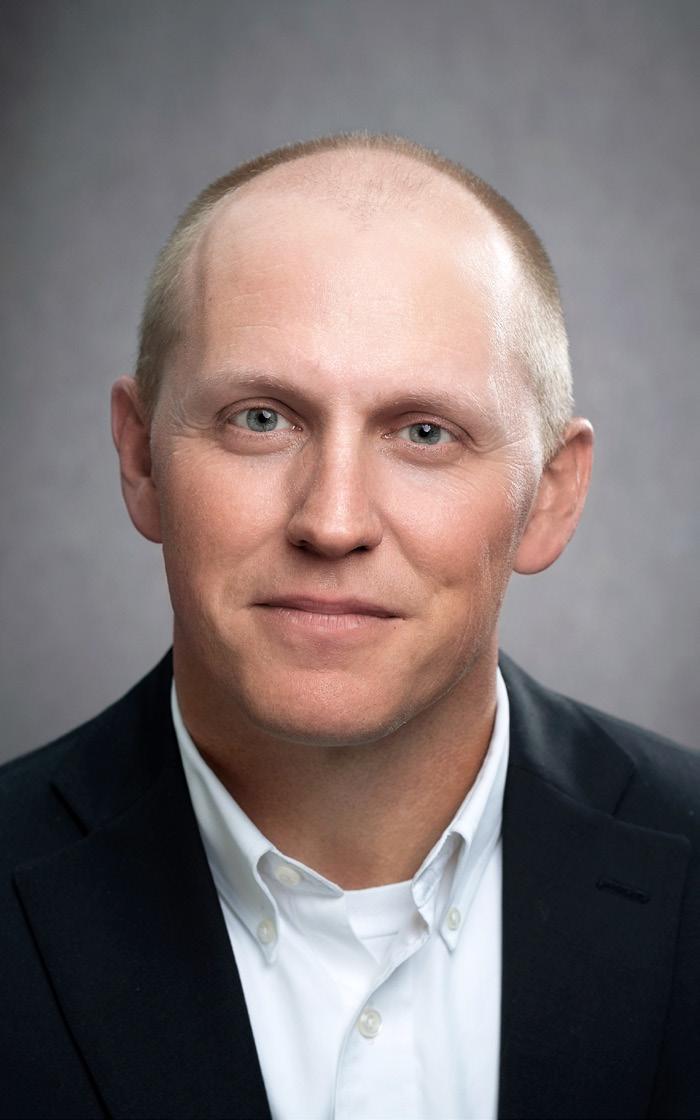
Renu Chhabra tackles her most complex assignment yet: providing healthcare for healthcare workers at McKesson 80
Gary Fennessy looks back on his fortyyear career in building relationships and managing teams to drive outcomes for Chicagoland patients 88
Prisma Health’s VP of Clinical Revenue Cycle Anne Robertucci endorses the power of technology to capture the full health picture of the patient 102

Joseph Mack overcame the obstacle of transitioning in-house to thrive at Bayer 108
Ann Sparkman reflects on an exciting and rewarding legal career, including the last sixteen years at UCSF 120
Monica Williams rose from a front desk position to benefits leadership at the Baylor College of Medicine ▶ 124

Lorenzo Ball on the technological shifts facing all industries—and their implications for healthcare ▶ 136
Ekta Vyas is about more than tactical improvements—she partners with the very best medical centers and research facilities to build the future of healthcare 148

LCMC Health’s Krystle Ferbos Duplessis credits her career success to flexibility and open-mindedness 152
Concept and Creative: Vince Cerasani, Sheila Barabad Sarmiento, Jaylyn Bergner
Photographer: Lisa Predko
Retoucher: Tom Michas

Dog: Winnie
Dog Trainer/Owner: Amrita Goel

The journey inspiring GlaxoSmithKline’s Vidhu Bansal Dev and her mission for greater access to proven medications 160
President and CEO Steve Mackin takes a purposeful and innovative approach to bolster talent during a pivotal time at Mercy Health 172
Northside Hospital’s Carl Waller on proactive supply chain management 184

Chicago-based photographer Lisa Predko specializes in conceptual and narrative images and coauthored Lisa Food , a photo-centric, gluten-free cookbook. Her two favorite design elements are lighting and color. Upon entering a room, the first thing she typically looks for is a dimmer switch.
To view more of her work, visit lisapredko.com
Alan Brian Nilsen (Bansal Dev), Courtesy of Ameritas Mutual Holding Company (Ball)Editorial Director
Frannie Sprouls
Managing Editor
Jaylyn Bergner
Editors
Melaina K. de la Cruz
Michele Cantos Garcia
Sara Deeter
Brittany Farb Gruber
Julia Thiel
Staff Writers
Zach Baliva
Billy Yost
Contributing Writers
Zachary Brown
Peter Fabris
Will Grant
Frederick Jerant
Joseph Kay
Russ Klettke
Natalie Kochanov
Donald Liebenson
Keith Loria
Maggie Lynch
Giovanni Perry
Rebecca Rakowitz
Andrew Tamarkin
Carl Waller
Senior Designer, American Healthcare Leader
Vince Cerasani
Designers
Anastasia Andronachi
Rebecca Kang
Arturo Magallanes
Senior Photo Editor & Staff Photographer
Sheila Barabad Sarmiento
Photo Editor & Staff Photographer
Cass Davis
Contributing Photo Editor
Sarah Joyce
Special Projects Editor
Sara Deeter
Creative Operations Coordinator
Melaina K. de la Cruz
CORPORATE
CEO & Publisher
Pedro A. Guerrero
President, Group Publisher
Kyle Evangelista
Chief of Staff
Jaclyn Gaughan
SALES
Director, Sales
Stu Ziarnik
Director, Sales Onboarding
Justin Davidson
Onboarding Sales & Development Manager
Hannah Tanchon
Sales Researchers
Titus Dawson
Kemp Pile
Lead Recruiter, Guerrero Search
James Ainscough
Senior Director, Corporate Partnerships & DEI Solutions
Krista Horbenko
Digital Product Manager
Aleksander Tomalski
Director, Talent Acquisition & Engagement
Haylee Himel
Talent Acquisition Managers
Josie Amidei
Jordyn Gauger
Content & Advertising Managers
Ashley Alcock
Megan Apfelbach
Lea Delattre
Maddie Keeler
Annie Peterson
Noy Raiber
Drew Thomas
AUDIENCE & ENGAGEMENT
VP, Hispanic Division and Head of Audience & Engagement
Vianni Lubus
Director, Events
Jill Ortiz
Events & Marketing Manager
Ashley Parish
Communications & Engagement Manager
Cristina Merrill
Associate Manager, Digital Marketing
Aliana Souder
Social Media Manager
Su Tellez
OPERATIONS
VP, Finance
David Martinez
Director, Circulation
Stacy Liedl
Staff Accountant
Natallia Kamenev
Senior Director, Client Operations
Cheyenne Eiswald
Senior Manager, Client Services
Rebekah Pappas
Manager, Client Services
Brooke Rigert
Office Manager and Administrative Assistant
Emiko Daniel
AHL Magazine® is a registered trademark of Guerrero, LLC.
Facebook: @ahlmagazine
LinkedIn: @american-healthcare-leader
Twitter: @AHL_Magazine
© 2023 Guerrero, LLC guerreromedia.com
1500 W. Carroll Ave., Suite 200 Chicago, IL 60607
Reprints
Reprinting of articles is prohibited without permission of Guerrero, LLC. Printed in China.
For reprint information, contact Reprints & Circulation Director Stacy Liedl at stacy@guerreromedia.com.
As job resignation numbers continue to climb at rapid rates (in part because of the COVID-19 pandemic), never has this question been more relevant. Recognized as the Great Resignation worldwide, this mass exodus by millions seeking a more intentional and balanced life forces a number of questions.
This is especially true for healthcare, the second-hardest hit industry, globally. The workforce, it seems, needs a breather—and for many, a life overhaul.
Throughout our numerous conversations with executives in 2022, we at American Healthcare Leader have come to understand that employees are becoming more specific about what they want from their roles and employers. Contrary to popular opinion, it’s not a fat paycheck and company car. Rather, individuals across the board repeatedly express desires that start with the heart and end with growth potential and passion.
As such, I invite you to consider that the Great Realization is upon us. We find ourselves at an unprecedented moment when scores of employees are truly considering who they are and what they want. And in response, organizations are reevaluating how they address everything from company culture to benefits in order to retain their staff and attract top talent.
Imagine then what a fully engaged company might look like: one comprising a cadre of professionals excited, empowered, and tuned into a mission that aligns their own goals with their employer’s. The possibilities. The potentialities. The mind reels. How exciting, then, to consider where such focused passion might lead.
Jaylyn Bergner Managing Editor

In 2022, an astounding number of employees across America resigned to seek opportunities better aligning with their career and life goals. With 20 percent of the healthcare workforce quitting, the industry has suffered considerably. Many are calling this the Great Resignation. However, we see this time of individuals rebuilding their lives around passion as the Great Realization. Here’s how ten leaders are addressing the situation and creating organizations of which their teams can be proud.

Corporate Relocation International partners with healthcare clients to attract and keep top talent during the Great Realization by relocating new employees and their families
By Zach Baliva Portraits by Sheila Barabad Sarmiento
Portraits by Sheila Barabad Sarmiento

Healthcare leaders across the Midwest woke up to some surprising news in July 2022. Joseph Mullany, president and CEO of Hospital Sisters Health System’s (HSHS) Illinois division, resigned suddenly. He was on the job for less than three months.
In his role as CEO, Mullany led teams at several Illinois hospitals, including facilities in Springfield, Decatur, Litchfield, Shelbyville, and Effingham. Ninety days after appointing a new leader, the HSHS Illinois system, which has a combined yearly revenue of nearly $1.4 billion, was forced to once again attract a new president and CEO. In the middle of a talent war. During an ongoing pandemic.
Attracting top talent is no easy task even in the best of times. In today’s candidate market, it can feel impossible. That’s why the operations teams at Corporate Relocation International (CRI) are partnering with leaders in the industry more closely than ever before.
“We know that death and divorce are the most stressful events most people can face, but moving is probably a close third,” says Vice President of Business Development Leisa Ross. “Our relocation consultants facilitate everything about a move to help our healthcare clients attract the very best candidates from across the country to come join their hospital or health system.”
Veteran healthcare executives with clinical backgrounds, top university pedigrees, and decades of experience can almost handpick their preferred destination and often choose to stay in major cities or stick close to home. Small-market or rural hospitals that can’t compete with entertainment meccas or local attractions still have to find a way to land visionary decision-makers. In fact, they need top candidates at every level. These and other factors are convincing more organizations to look to companies like CRI to bring in talent and mitigate turnover.
Ross works with Directors of Account Management Stephanie Massegee and
Tyler Doole to serve CRI’s healthcare clients. The trio is seeing an unending evolution take place across the entire industry. “Our partners may have big budgets, which increases their pull to go for the very best, but it’s no longer enough just to throw a lump sum of money at someone and hope they accept an offer,” Doole says.
Those partners—which include clinics, hospitals, university systems, mental health providers, and other—are responding to increased competition by expanding their recruitment footprint. Adding relocation benefits to an offer package can make the difference between a yes and a no.
Corporate Relocation International is a privately held, full-service relocation management organization. In the last thirty years, the Texas-based company has assisted people in more than 150 countries and developed a reputation for a relentless focus on the customer experience.
That customer experience anchors the entire process. “We talk to every client to find out exactly what’s most important to them and their culture, and then we custom build a program together that fits their exact needs,” Massegee says, adding that there are often different tiers for different levels of employees. Specialized employees can take advantage of home organization, grocery delivery, meal prep, transportation, and concierge service.
For the CRI team, a move is about more than simply getting a person from point A to point B. Ross views each move as an intricate puzzle she and her colleagues painstakingly put together bit by bit until a beautiful picture comes into view. Each piece—the employee, spouse, children, household goods, church, community, school, automobiles, and pets—is handled with care.
“We take a holistic approach, because the new employee is going to really thrive and have the best relationship with his or her new employer if the
“We know that death and divorce are the most stressful events most people can face, but moving is probably a close third.”
—Leisa Ross

The Great Realization has seen a record 4.5 million American workers quit their jobs in March 2022, alone (Bureau of Labor Statistics, 2022)



 Leisa Ross VP of Business Development Corporate Relocation International
Stephanie Massegee Senior Director of Ecosystems Corporate Relocation International
Tyler Doole Director of Account Management Corporate Relocation International
Leisa Ross VP of Business Development Corporate Relocation International
Stephanie Massegee Senior Director of Ecosystems Corporate Relocation International
Tyler Doole Director of Account Management Corporate Relocation International
entire family is well cared for from start to finish,” Ross says.
Each relocating employee (and their family) receives a dedicated operations consultant. This personal representative handles every detail and also reports back to the employer through a dashboard that tracks costs and other details in real time.
Proprietary tools and key partnerships supplement these important efforts. Reloportal is CRI’s in-house site that curates temporary housing options that clients can examine and select from when necessary. “Most people farm this out, and we’ve built our own tool that can give users options based on proximity to their favorite gym or a dog park, because we believe the social piece of the puzzle is so important,” Doole says.
The CRI team also has an app called Pivot that helps users find doctors, clubs,
friends, and activities in their local market. Lastly, the Prowess app arms accompanying spouses with interview skills, résumé prep, and other resources that ensure a successful transition.
The ongoing COVID-19 pandemic has changed things at CRI, and healthcare is now the largest industry the company serves. Other factors are forcing the organization to adapt too. “The needs of relocating employees are different all the time, so we have to stay flexible and provide options,” Massegee says.
A white-hot housing market has made those temporary housing options popular, and some employers will even kick in cash for an above-asking real estate offer. Lump sums, storage costs, and miscellaneous expense allowances also are increasing. While it might sound like enough to make any hospital CHRO’s head spin,
Ross says they can trust CRI to stay on top of every changing trend. “The market is changing so fast, but we analyze our data constantly, and we can tell what employees are using, what they aren’t, and how clients can reallocate funds from underused line items to more popular features,” she explains.
The cost to move a new employee may cause some employers to hesitate, but in today’s competitive world, many see it as a necessity. “Companies that are willing to relocate top talent fill positions faster and stay ahead of their competition. It’s a worthwhile investment and an important weapon to help win the talent war,” Ross says.
Getting all the pieces in place lets the healthcare provider focus on the big picture task—taking care of patients, their families, and their communities. AHL
“We talk to every client to find out exactly what’s most important to them and their culture, and then we custom build a program together that fits their exact needs.”

Tony Contessa leads with his heart on his sleeve as regional VP at Cigna
By Jaylyn Bergner
Heart. This is the word that comes to mind after one conversation with Cigna’s Tony Contessa and his teammates—to the point that one forgets the discussion is about insurance.

But people matter, and that comes through when talking to the regional vice president of the New York and New Jersey region’s select and middle market segment.
“Everything I do, whether internal or external, as far as I’m concerned, is focused around relationships. That’s just who I am,” he says candidly. “You can’t really get anything done in a company like Cigna, or any company as far as I’m concerned, unless you have strong relationships. You build them on trust. You build them on credibility.”
The global health service company is known for its health, pharmacy, dental, and supplemental products, but it offers clients considerably more. Cigna provides a different perspective and experience when interfacing with the industry— one based on community, trust, and mutual respect—not just with clients but also across the internal organization. As expected, this laterally fostered team outlook translates to greater health outcomes and rewards for Cigna’s employees, clients, and customers.
“When I look across our business, many people touch our clients, and the brokers who are their representatives,” Contessa reflects. “There’s a lot of complex relationships you have to balance and make sure you’re focused on. What differentiates Cigna is we truly strive to partner in a differentiated way by working to understand what their focus is, or what their goals are, and balance that with what Cigna’s goals are. And then we work as a team to deliver on that.”
Enter Cigna’s Annual Client Forum, a three-day event held in a different location each year, affording the organization the opportunity to connect on a deeper level with its clients by showcasing thought leadership and industry
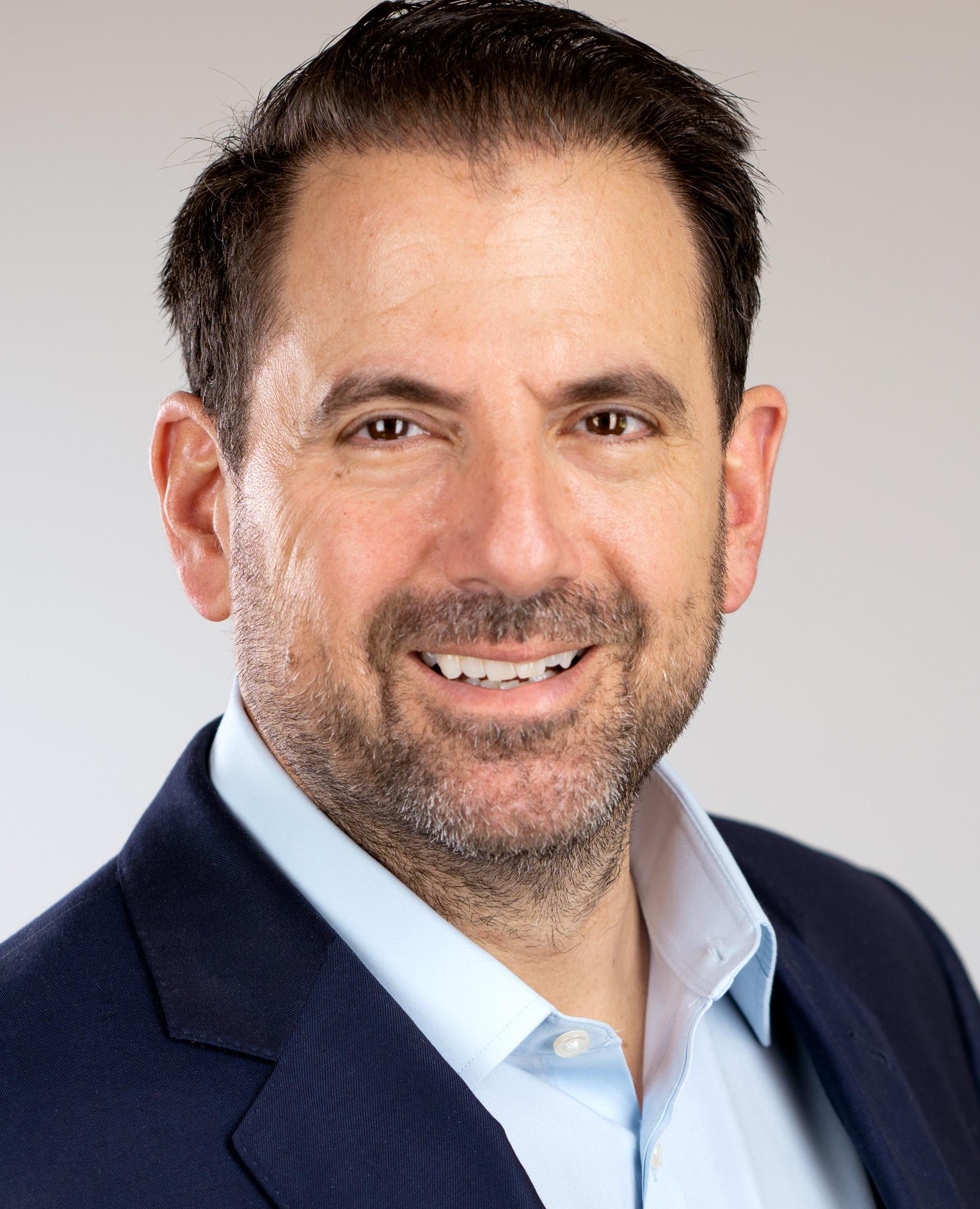 Tony Contessa Regional VP, NY/NJ Region–Select & Middle Market Segment Cigna
Carlo Cipriani
A majority of the workers who quit in 2021 cited low pay, no advancement opportunities, and feeling disrespected.
Tony Contessa Regional VP, NY/NJ Region–Select & Middle Market Segment Cigna
Carlo Cipriani
A majority of the workers who quit in 2021 cited low pay, no advancement opportunities, and feeling disrespected.
trends. The localized sessions help foster a mutually beneficial relationship, take clients offsite, and comprise events and topics focused on helping clients achieve their goals of improving the health, wellness and productivity of their employees and family members.
Lectures on how to find talent, Christopher Herron’s presentation on loneliness and drug use, and a speech from Admiral William McCraven on leadership illustrate just a few examples of the company’s consideration of client needs.
Creating meaningful opportunities to engage and learn leaves attendees feeling a real connection with Cigna employees and the company as a whole. According to Contessa, the overarching idea marries with the undercurrent of “I trust them because they didn’t waste my time, and it was important, and I left feeling good.” This automatically opens communication lines and remarkable friendships, not to mention inspires repeat attendees.
Contessa and Cigna continue this engagement through support and by making a positive impact with a multitude of community and charitable initiatives, such as raising money for Ukraine, building a bike for orphans, or collecting food for needy children. Employees and clients create and contribute—together. According to the VP, it’s these shared moments that create a foundation of resonance and rapport.
“It’s not like this is just another event,” Contessa says. “You start to bring clients and brokers into a family. They see how we act with each other, and it’s absolutely the most important thing we do. If I can get all of our clients to it every year, I think we could change the way that we work, which would be for the good of everybody, because we help them achieve better outcomes for their employees. We break that trust barrier. And the better communication, the better outcomes.”
For employees, this means a working community that not only aligns with their values but also offers an outlet of expression. “It helps people get focused
and energized in a job that is not only difficult, but many have been in for a long time,” he says. Considering some employees have clocked over thirty years, it’s a point worth noting.
“It makes you feel good about Cigna, it makes you feel good about your partnerships,” he continues. “We have an opportunity every day to change lives for the better and help people achieve their health goals. Cigna has the expertise to transform health benefits from an expense into an investment, so employees—and businesses—truly thrive and grow.”
Contessa credits the company’s team-focused approach to leadership as the overarching cornerstone to its cultural success. Considering each individual as a valued teammate, rather than from a hierarchical structure, not only validates a variety of perspectives but also yields greater results.
Practically, this looks like an environment of inclusivity, thank you letters, open office doors, and CEOs under the table plugging in light projectors. Not something you see at every organization.
A natural leader himself, Contessa’s role requires a mix of internal and external focus on anything that touches the client—every person, program, or effort. His distilled approach stems from lessons learned—specifically, his more negative experiences. “The list of things that I’ve learned not to do from bad leaders is longer than the list of things I learned to do from good leaders,” he says. “I’ll never be a perfect leader, but I try, and I’m very conscious about how things come across.”
With such a strong focus on prioritizing relationships and creating an empowering culture, Contessa shares that his team has been relatively untouched by the Great Resignation. A phenomenal fact, considering the great surge of change in all industries.
“When you get into this company, and you feel the culture, the bond, the family aspect, it really makes you feel like there’s no other place you’d rather be,” he says. AHL
“Everything I do, whether internal or external, as far as I’m concerned, is focused around relationships. That’s just who I am.”
Dena House overhauled Adverum Biotechnologies’ company culture—bolstering the company’s recruiting advantage within just months
By Peter Fabris

You could say Dena House had her work cut out for her when she joined Adverum Biotechnologies in 2019. The company—which aspires to establish gene therapy as the new standard of functional cures for debilitating, highly prevalent ocular diseases—went public just three years after launching. The move exacerbated an already-existing, unacceptably high turnover rate. Employee surveys indicated low favorability in engagement across the organization, and the company’s rudimentary human resources assets complicated the situation.
“Adverum didn’t really have an HR department,” says House, the senior vice president of HR, organizational development, and learning. “Different groups performed the tasks for different pieces of the HR function. Given the size of the company and the fact that it was public, we had to bring the basics of HR into one department and implement an HRIS [human resources information system.]”
That meant House and her new team had to gain an understanding of the turnover problem, piece together an HR department from disparate parts, and tackle the corporate culture problem—simultaneously.
The remedy started with a leadership change, including new faces in the CEO seat and other C-suite positions. Then House diagnosed the morale problem by conducting numerous focus groups and informal meetings with employees at different levels. One of the most troubling findings: the employees’ low rating of a company-fostered, collaborative culture.
Changing this required participation from all levels of the organization. As a
result, the leadership team prioritized improvements and committed to creating an engaged workplace. The SVP then brought in the voice of the employees with a cross-functional team of volunteers to dig into the data and create a plan together.
Under House’s direction, the Adverum Culture Transformers (ACT) devised a comprehensive plan focusing on four major areas:
1. Roles and Responsibilities: Creating clear job descriptions, individual goals, and clearly delineating the roles of various groups and departments
2. Employee Development: Implementing skills development and career growth programs
3. Communication: Providing more transparency and clarity around corporate information, strategies and goals
4. Strategy Refining: Clarifying missions, vision, and values.
Clearer job descriptions at all levels, groups responsibility delineations, and a more defined company mission statement, goals, and values provided much-needed guidance for employees. The team also redirected staff to the proper leadership and channels for answers on key matters, as well as helping them define their own roles.
Another critical component centered on how and what leadership communicated. At times, the company released guidance and information to investors without much information as to the impact on employees. “People would wonder, ‘How does it change our goals and milestones?’” House shares.
The uncertainty sometimes fueled the rumor mill and the feeling of
“Our goals are to help our people develop their careers and make sure they know they are valued.”
•20% total loss of industry workers overall •3% of healthcare workers quit each month •1.7 million resigned in 2022
organization instability. “This is how infighting starts, eating away at collaboration,” she explains.
To increase transparency on strategy and policies, the company launched an intranet with weekly video updates on business developments from executives and held more frequent company-wide and intradepartmental meetings. When the COVID-19 shutdown began, weekly all-hands meetings and biweekly newsletters kept staff apprised of all company ongoings. These also served as a tool for connectivity and community building across the organization by featuring various employee pictures, work-fromhome setups, and summaries of company-hosted virtual events.

House, her team, and the ACT kept a pulse on the organization throughout COVID, ensuring the culture improvements were being implemented, adjustments made based on employees’ changing needs, and continued assessment on improvements in collaboration and engagement.
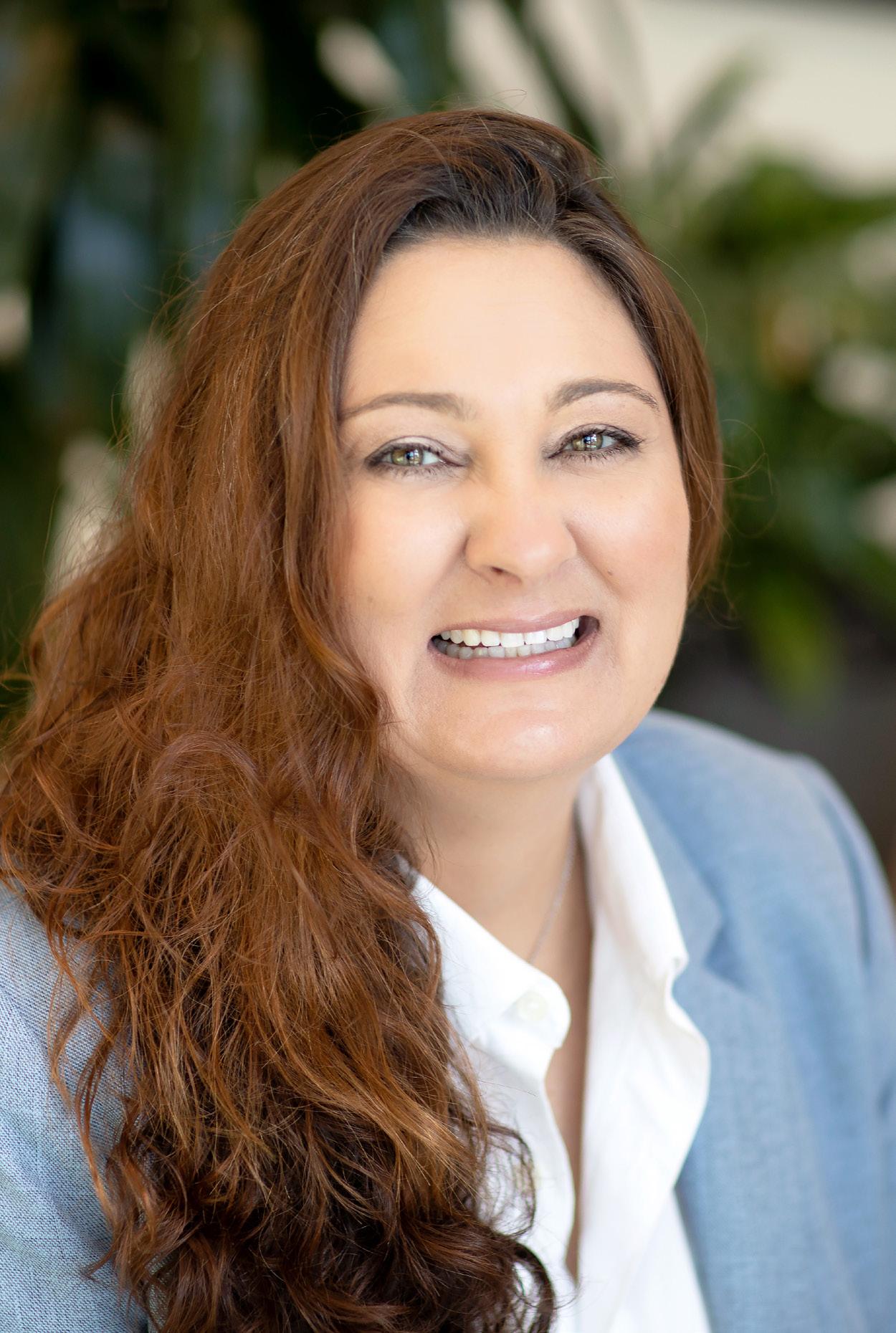
In the hot field of biotechnology, employees have their pick of potential employers in the San Francisco area. Knowing this, the HR lead found providing skill development opportunities a critical retention strategy. Adverum University proved to be a key tool for cultural transformation. One component, Learning Forums, offers a knowledgeand skill-sharing venue for internal experts. A central hub of education and program development benefiting individuals and the organization alike.
Recognizing the need to improve the company’s welcoming of newcomers, House and her team bolstered the orientation and onboarding program. The formal process steeps new employees in
Dena House SVP of HR, Organizational Development & Learning Adverum Biotechnologies Christophe Testi HEALTHCARE IS THE SECOND MOST AFFECTED INDUSTRY OF THE GREAT REALIZATION:the company goals and provides success training, including writing one’s own annual objectives. COVID especially highlighted the importance of continued high-touch, individualized care of new hires. The team implemented thirty-, sixty-, and ninety-day interviews with each individual to stay abreast of what processes worked and what roadblocks required removal.
The efforts of the ACT paid off: employee engagement surveys significantly improved and continue an upward trajectory, while turnover decreased to below the industry benchmark. “Something we’re proud of at Adverum is that given the engagement work we’ve done and improvements in our scores, we actually made it on the Bay Area News Group’s Best Places to Work in 2021,” House says. “We did this within eighteen months of focusing on engagement, even through a pandemic!”
“PMLG is extremely proud to support Dena in rapidly maturing the skills of Adverum’s leaders with our unique,
experiential-based leadership training,” says Bill Stewart, president and CEO of Project Management Leadership Group (PMLG.) “Creating teams of collaborative current and future leaders is the key to achieving strategic execution excellence.”
While proud of her many accomplishments, House says more needs to be done given labor pressures. “I’m concerned about what’s happening in the world post-COVID,” she says. “People are exhausted and making life changes.”
Some are leaving the labor market or changing careers, exacerbating the battle for talent. “Our goals are to help our people develop their careers and make sure they know they are valued,” she says. AHL

Congratulations to Dena House for her commitment to developing employees, so they can discover their full potential. Torchiana is proud of our collaborative partnership with Dena. For over forty years, our Smarts + Hearts™ approach to leadership development, executive coaching, and career management has helped leaders and organizations thrive.

We recognize Dena House for her dedication to helping employees discover their full potential.
“Different groups performed the tasks for different pieces of the HR function. Given the size of the company and the fact that it was public, we had to bring the basics of HR into one department.”




Mark Weiss brings his unique mix of finance and operational expertise to bear at the New Jewish Home
By Natalie Kochanov

Mark Weiss’s job title at the New Jewish Home (NJH) might be CFO, but finance is only one of the items on his plate.
“After about three or four months at the organization, I was given responsibility for some of our operations,” Weiss explains. “We have two large nursing homes that account for probably about 75 percent of our revenue, and that operational responsibility went to me, in addition to my CFO responsibilities.”
Within a year, the New York City nonprofit’s remaining lines of business became Weiss’s responsibility, as well. Today, he advises on finance and operational matters alike, with the end goal of helping the New Jewish Home achieve its patient-centric mission: “To empower older adults to enhance purpose and well-being through a portfolio of innovative healthcare services.”
When Weiss first joined the New Jewish Home in July 2019, he already had substantial operational experience under his belt from his time as a nursing home administrator in the state of Ohio.
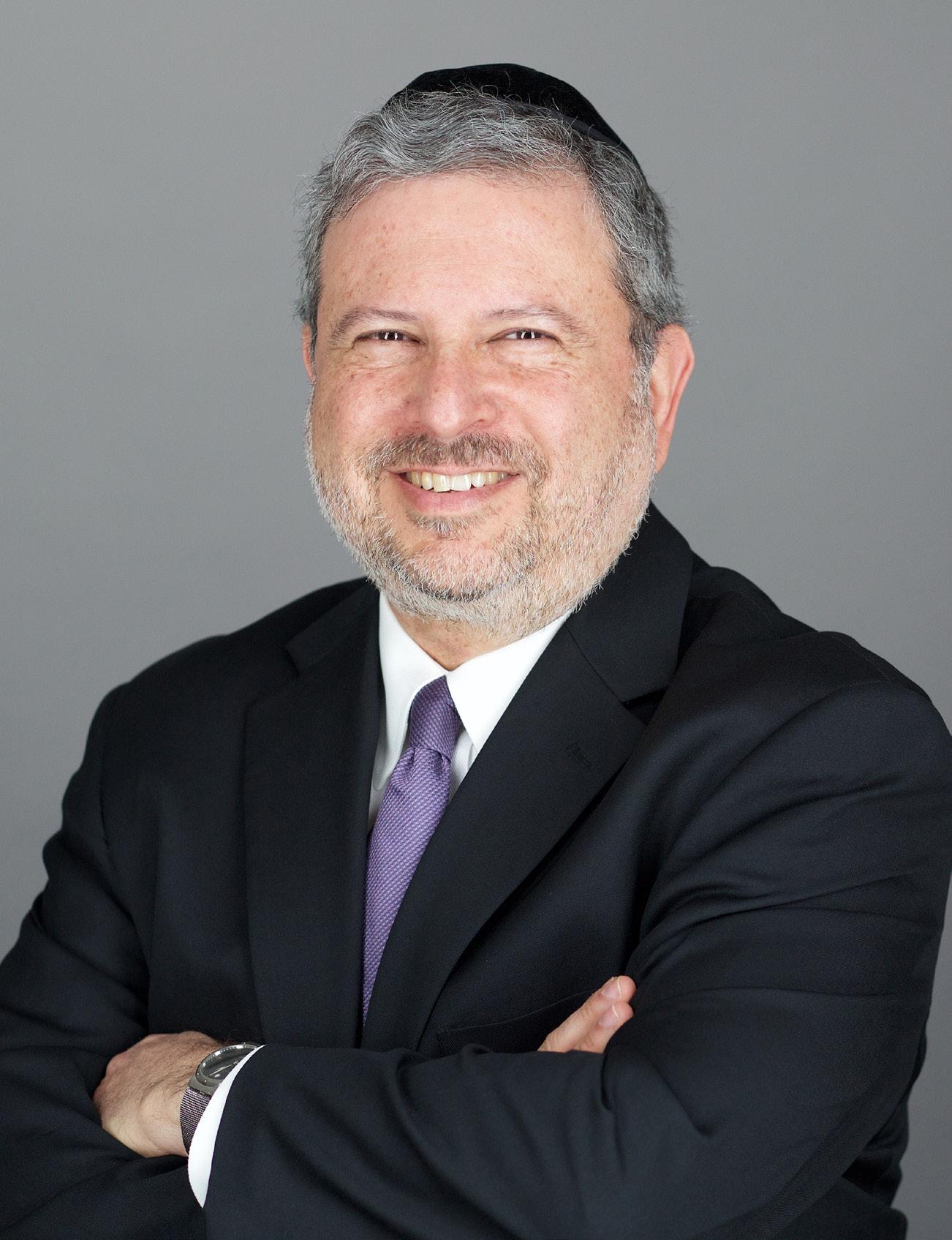
“I’m in a unique position because I’m able to look at things from both a finance and an operational perspective,” he says. “For instance, I understand that by spending more money on certain things up front, I can create potential savings down the line when it comes to mitigating risk and eliminating long-term exposures.”

His ability to consider the organization holistically, instead of narrowly focusing on its bottom line, gives Weiss an edge when offering support or guidance to fellow members of the executive team. It also comes in handy on projects geared toward strengthening the finance function.
“One of my major initiatives since the get-go has been to improve upon the audit process that we’ve had in place for a number of years,” Weiss says. “We’ve made big strides in that area. Audits are getting completed sooner, with fewer—if any—adjustments.”
NURSING, IN PARTICULAR, HAS SEEN THE GREATEST CHANGES.
•30% of nurses quit •34% of nurses reported their intention of leaving by the end of 2022 (US Bureau of Labor Statistics)
Mark Weiss CFOAlthough his expectations are high, Weiss strives to empower his colleagues and set them up for success. He maintains regular touchpoints with staff members, especially those in need of additional mentoring in the face of a new challenge. “I want to know that we’re spending our money wisely, getting a good return on our investments, and processing things appropriately,” he says. “I’ve been in the healthcare industry for about twenty-eight years, so I can bring the benefits of that to people who have less experience or who have not experienced what I have.”
Even with his background, Weiss still encounters challenges of his own, including those of Medicare and Medicaid reimbursement, city and state regulatory hurdles, and talent attraction and retention. The latter has only increased in difficulty amid the Great Resignation, which has hit the healthcare space particularly hard.
“We are people taking care of people. We cannot do what we do without people, but people were affected by COVID to the degree that they no longer wanted to work in healthcare,” Weiss says. “The Great Resignation has been a big challenge. Our operating costs have gone up, while our revenues have not matched that increase in cost, so it has put a financial strain and an operational strain on the organization.”
Weiss minimized the aforementioned flexors by prioritizing hiring and leveraging technology solutions to streamline staff scheduling. “Our focus is to spend where we need to, make sure that there is no waste where possible, be as efficient as we can with the resources that we have, generate business for the organization, and deliver the care that we’re here to provide,” he summarizes.
“Working with Mark the past twelve months has been the perfect balance of him deferring to Vestian’s real estate skill sets and expertise, while driving us to optimal cost savings for the New Jewish Home,” says Brad Armstrong,
“We’ve been around for over one hundred seventy years in New York City. My role is to work with the executive leadership team to do the best we can to make sure that we’re in a position to continue to care for New Yorkers.”
executive managing director at Vestian. “Mark has provided clear understanding and specific direction for us in support NJH’s balance sheet goals to eliminate underutilized facilities. While still in progress, we should successfully reduce $1 million in year-over-year expense. Mark has led both the Vestian and NJH teams to navigate complex legal, operational, and financial challenges to reduce the footprint by 25,000 in 2023 and plans to achieve similar reductions in 2023.”
Indeed, patient care is at the heart of his team’s work. “The mission of the New Jewish Home is to take care of seniors in New York,” he confirms. “Success for the organization is to provide the care that is needed at the time it is needed, whether it is in a patient’s home through our home care services or in our nursing homes through either short- or longterm care.”
Weiss cites the New Jewish Home’s status as an approved COVID-only facility
at an earlier stage of the pandemic as an example of the organization’s efforts to make good on its mission. For his part, he is committed to carrying forward those efforts into the future.
“We’ve been around for over one hundred seventy years in New York City,” Weiss says. “My role is to work with the executive leadership team to do the best we can to make sure that we’re in a position to continue to care for New Yorkers.” AHL
“I understand that by spending more money on certain things up front, I can create potential savings down the line when it comes to mitigating risk and eliminating long-term exposures.”




CISO Joshua Roth knows that secure systems are a key part of caring for patients, including his family
By Rebecca Rakowitz

For even the most dedicated employees, Friday afternoons can be a time to slow down. But for Joshua Roth, these periods call for extra vigilance. As the chief information security officer (CISO) at the Children’s Hospital of Orange County (CHOC), he knows cybersecurity attacks don’t subscribe to business hours.
“Some of the biggest threats are the ones that will pop up on a Friday afternoon,” he says. “And then it’s allhands-on-deck to mitigate the risks.”
In his role, Roth assesses the overall maturity of CHOC’s information security systems. He ensures they have appropriate resources and processes for data protection, looks for potential gaps in the system, and locates areas of opportunity, including new technologies and new ways to monitor threat intelligence.
“The process always requires improvement,” he says. “And that’s a continuous activity to always be evaluating.”
In a landscape that changes daily, sometimes even hourly, it’s not a game of if a cyberattack happens, but when. For this reason, Roth prioritizes having quality teams, vendors, tools, and response plans—he knows security is an essential part of patient care.
“Ransomware will literally take down an organization,” he says. “Whether it’s hospital operations that go down or the medical devices that provide patient care, all of those can be impacted by cybersecurity.”
Patient well-being sits at the top of Roth’s priority list. After many successful years at healthcare company Kaiser Permanente (KP), he decided to move to the nonprofit space.
“It come down to what I see as the mission of nonprofits,” he explains. “For CHOC, it’s to nurture, advance, and protect the health and well-being of children. For KP, it is to provide high-quality, affordable healthcare services and improve the health of members and the communities we serve. From my perspective, it’s not about shareholder
profits; it’s about what you can do for the communities you serve.”
With his stepfather serving as a detective and his mother as a nurse and emergency room director, Roth developed a worldview of public service from early childhood. He combines this with his passion for supporting children’s hospitals, which stems from the experiences of his children.
His son is on the autism spectrum, and his stepdaughter has Down syndrome. Once a CHOC baby, she still receives care from her CHOC team, despite being over eighteen. Taking all of this in consideration, Roth considers working for CHOC “an honor.”
“It just speaks volumes for the type of organization that they are,” he says. “And that’s what I want to be a part of in doing my job.”
Meanwhile, what speaks volumes to Roth’s leadership is the way he retains team members. In his nearly ten years at Kaiser, none of his fourteen employees left. An unheard-of win in the industry.
“It really comes down to how you treat these individuals, building that trust with them, and being an advocate for their career aspirations,” he says.
Roth likely developed much of that trust during the biweekly one-on-ones he held with team members, a practice he continues at CHOC. The CISO believes it important that everyone sets their own agenda, as some dread the structured meeting. If an employee prefers to ditch the work talk and just chat about their weekend or family, Roth is all for it.
“It’s to build that rapport and mutual trust,” he says. “I’m just as accountable to them and their success as they are to me and the organization.”
Mutual trust, accountability, and inclusivity are key tenets for Roth. He wants everyone he works with, including his outside vendors, to know their relationship is not hierarchical but lateral and symbiotic—an especially important differentiation at a time when retention seems more critical than ever.
“I’m just as accountable to [my team] and their success as they are to me and the organization.”
Roth has heard estimates tracking worldwide cybersecurity job openings at just over a million. Some call this the Great Resignation, but he thinks of it more as a “Great Reshuffle.” Rather than just quitting, people are seeking positions that better meet their talents and expectations.

He believes companies need to invest in their people and welcome all kinds of future cybersecurity professionals, confronting the situation with an open mind and willingness to mentor. Having hosted interns throughout his career, the CISO relishes the opportunity to guide prospective specialists. “Internships are some of the most fulfilling aspects of my work,” he says. “You get to work with someone fresh, teachable, and passionate.”
Roth also says companies cannot expect to only recruit candidates with four-year degrees or industry internships. “I think we need to do away with this traditional expectation and focus instead on people who might have certifications in the field or the passion, soft skills, and desire to learn,” he says. “Otherwise, we will not have the numbers we need.”
With such roles remaining empty, companies in every sector will struggle to maintain secure systems. Without such insurances in healthcare, patients and their information cannot be protected adequately any day of the week, perhaps especially on Friday afternoons.
“When you have resources spread thin, it’s a distraction,” Roth says. “We have to make sure that we can keep our eye on the target.” AHL
Zero Trust principles are critical to the successful implementation of Secure Access Service Edge (SASE), which is the model for a cloud-centric, hybrid work architecture, where data is protected everywhere it moves across cloud, SaaS, IaaS, private applications, web, email, and endpoint devices. Netskope’s approach to SASE and Zero Trust data protection has seen rapid adoption by enterprise healthcare providers and service organizations all over the world, and has been repeatedly recognized by leading technology analysts.
Joshua Roth CISO Children’s Hospital of Orange County (CHOC)

You won’t hear echoes of that era-defining line of dialogue from the classic 1967 drama Cool Hand Luke starring Paul Newman on Shannon Cruz Lloyd’s watch. The associate vice president (AVP) for human resources at suburban Atlanta-based MIMEDX is a fervent proponent of employee engagement, and the pandemic only strengthened her commitment to communicating.
“We do still have a business to run, but we want to be sensitive to our people’s needs, as well as their families,” she says. “It’s a delicate balance. What has helped us is being able to listen to the employees and ask them what they need. We may not be able to say we can meet 100 percent of what they are asking for, but we try to compromise to see what we can do. At least we are asking people what is important to them and what they need from us.”
Lloyd was born in Del Rio, Texas, to a Hispanic and white mother and a father from Guam; her parents prioritized education. Hard workers who got married and divorced as teens, they graduated high school but did not attend college. After spending her childhood between Texas and California, Lloyd eventually transitioned to California to begin high school and live with her grandmother.
“My family wanted me to have a better life,” she says. “I was always interested in school, so they didn’t have to push me too much. I was the first in my family to go to college.”
The Californian initially studied Organizational Psychology at San Diego State, and though it wasn’t originally her plan, she later earned a master’s in HR management and employment law. “I was a music major with a dance minor. But I


This government-backed effort seeks to improve healthcare providers’ wellness by requiring the Department of Health and Human Services to award grants to hospitals, medical professional associations, and other such entities. (Congress, 2022)
Shannon Cruz Lloyd Associate VP of HR MIMEDX Nancy Gabrielahad a part-time job during college, which gave me an administrative introduction to HR, and I felt I was pretty good at it. Before I graduated, I ended up in a role at Sony Electronics, where I was an HR assistant.
“Within a couple of months, I was promoted to junior recruiter,” she continues. “I’ve always been told that I’m diplomatic, but also pragmatic and empathetic. I felt HR was a natural fit that would play to my strengths and could possibly be a nice career path.”
Now in her fifth year with MIMEDX, she serves as an HR industry leader in the global biopharma space. “What I like best about HR is that while I’ve been fortunate to mostly work in the pharma/ medical device industry primarily in a global capacity as well as with organizations of all sizes, I could work in any other industry and still be able to apply my knowledge in helping people and management to be the best versions of themselves,” she says.
The AVP describes her current role as unique in that she is both customerfacing, but also operational. “I work strategically with management on issues, such as performance, coaching, engagement, recruiting, retention,” she says. “But I do also have a role in developing and initiating operational items, specifically optimization and process improvement initiatives. I’m fortunate to lead and manage an amazing team. I wear a lot of different hats.”
Perhaps the biggest change in HR, and certainly a contemporary challenge, she says, is what is being called the Great Resignation. Last year, according to the Bureau of Labor Statistics, more than 47 million Americans quit their jobs. And resignation rates continued to rise at unprecedented rates in 2022.
“There was a lot of employee uncertainty during the pandemic,” Lloyd says. “Now that it is starting to feel a little bit more normal, people are reevaluating their roles and their purpose. They are reconsidering what is important to them. We have to recognize that employees have several options; why should they stay if there are more choices out there? They’ve become accustomed to some flexibility.”
Surprisingly, work-life balance and continuous development tends to be a stronger driver than salary in some cases, Lloyd notes. “Employees want to be recognized for their hard work,” the HR leader says. “They want to be sure that enough is being done in terms of growing their career.”
As businesses navigate a post-pandemic world, Lloyd believes people need to rethink HR as a strategic partner. “I would like people to see HR as a function that ultimately wants to see the people impact the companies for whom they work,” she says. “If you have great talent, your business will be productive, everyone is happier and more engaged, and that will drive profitability.”
What can companies do to facilitate this? “Someone needs a tagline for that,” Lloyd says with a laugh. “It’s challenging. We need to be able to identify root causes where we can; to actually ask, listen, and ultimately, take action. It can be something as simple as talking to people to see if there are any patterns we can address, or creating a culture that provides employees with a sense of purpose in why they even want to come to work every day.
“That can be a struggle for many companies with even the best existing cultures,” she continues. “They have to continuously work on it. You can always be doing something to improve your culture. HR is always a work in progress.” AHL
“I could work in any other industry and still be able to apply my knowledge in helping people and management to be the best versions of themselves.”
and Mobility Tanner Brunsdale shares what sets the ridesharing company apart
By Zach Baliva

Tanner Brunsdale knows firsthand the importance of a strong benefits package to employees and their families. Though he was already working in HR when he was diagnosed with Hodgkin’s lymphoma in his mid-twenties, he felt lost. Brunsdale didn’t know who to call, where to go, or how to access the care he so desperately needed. He eventually beat the cancer, and now has a favorable prognosis. However, the experience changed him, deepening his commitment to supporting every employee in every situation.
Now Lyft’s senior manager of benefits and mobility, Brunsdale spoke with American Healthcare Leader about what it means for the transportation network to build a flexible workforce, do DEI well, and provide the benefits that matter most.
In March 2022, Lyft announced it would become a fully flexible workplace. What has the response been?
The majority of our employees can now choose where they live and where they work. The response has been really strong, but we’re also seeing that there are inherent challenges in transitioning to a new way of working. Those are the times we’re in. Needs and expectations are changing.
What does that mean for someone in a role like yours?
high-quality healthcare and everything else they need.
How can you address this?
I think virtual options and telemedicine will play a big role. We’re actively identifying the most innovative companies we can track, so we can find the right partners.
You mentioned taking care of employees. How did you first get passionate about working in this space?
My mom was a nurse, and she always showed me her passion for helping others and caring for them, which led me into HR and benefits. I worked as a recruiting coordinator for a healthcare company, then as a benefits coordinator at the New York Public Library. That’s where I fell in love with the field, seeing the impact this work can have.
And I understand you experienced that personally?
I was diagnosed with Hodgkin’s lymphoma. I got through it and have been in remission for twelve years, but it was hard to coordinate my own benefits and care, even though I worked in the industry. It made me want to be that person employees can get support from if they are ever in a similar situation—in those scary moments.
It means that pay is no longer the only factor. People want to be paid well, and they want to have a benefits package that supports their families. They want to be somewhere where they can be their true selves and have their needs met. It’s not all about pay and a fancy office and other perks that might be trendy.
Are there challenges beyond identifying and meeting changing expectations?
The main challenges are around location. We have to find ways to support employees who might now choose to live in rural areas. They still need to have access to
What was it about some of those early experiences that made you fall in love with this work?
Benefits is that spot where your whole job is to provide support and make sure employees have the resources they need. You have to see employees as people. You have to figure out what that person needs to be a great employee and want to work in a particular culture.
How did that play out before you joined Lyft?
I had a couple of foundational experiences. I was working for US Airways and was able to help roll out their very first corporate wellness program.
Then when we merged with American Airlines, I was part of the team that harmonized all the benefit plans. That took me to Dallas, where I launched a new benefits website and implemented a video telemedicine program and an expert second opinion program.
Along the way, I got involved in the Pride employee resource group. When my husband’s job took us to San Francisco, I worked for GoPro and a latestage start-up called Samsara, where I built out people operations and benefits as their first benefits hire. That really set the stage for my experience at Lyft.
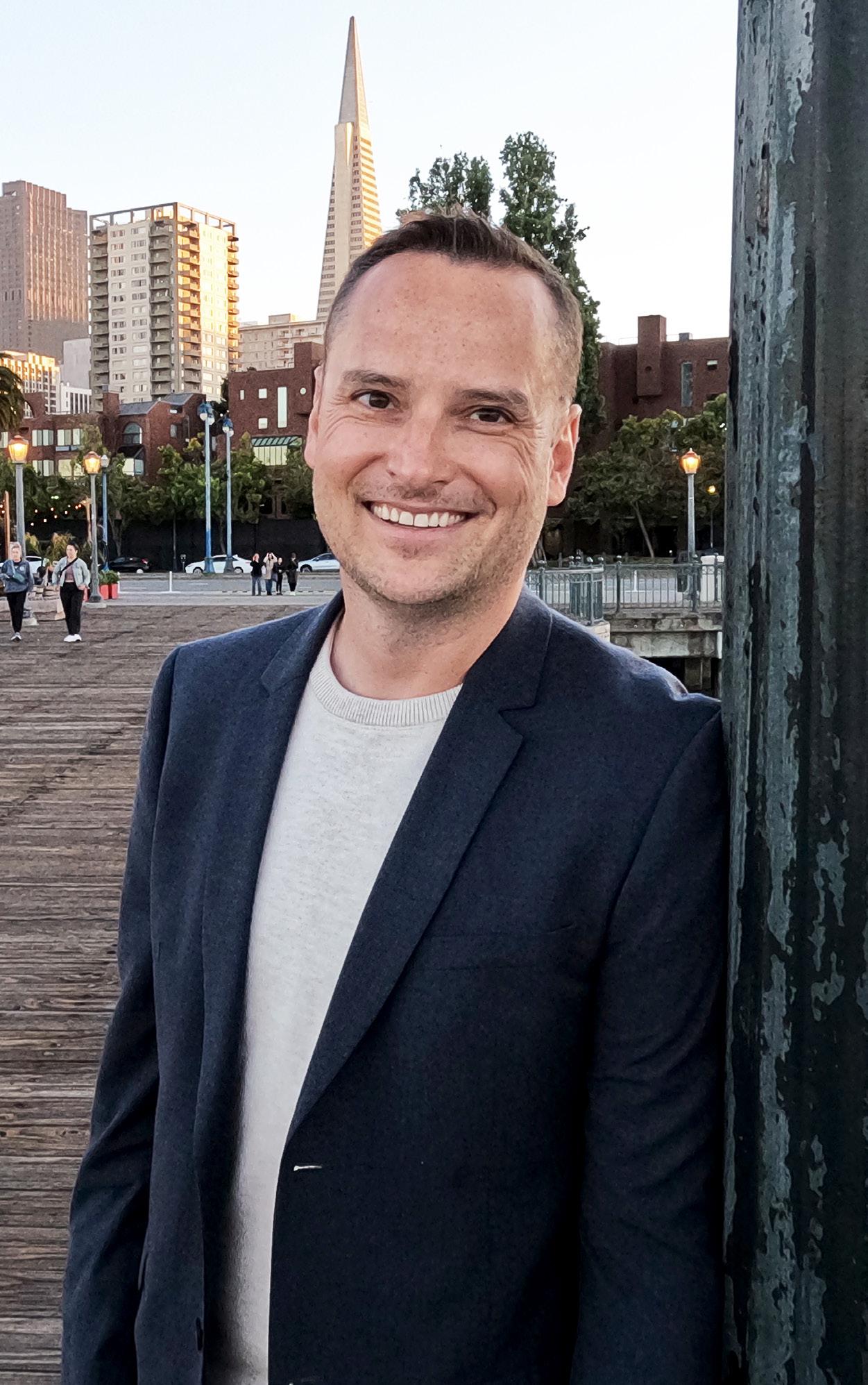
You came to the organization in the middle of the pandemic and the Great Resignation. How did that impact you and your teams?
It showed the need for strong mental health support. We now work with Modern Health to offer free therapy, coaching, and mindfulness resources. And it’s not just for our employees. It’s for their families, too.
What else are you doing that sets your plans and programs apart?
We want to meet the needs of our employees, and also let them have choice. High caring is our mantra. We focus on the benefits that matter most. We have a really strong fertility program that offers four full cycles. We offer support for employees who want to adopt or use a surrogate.
We have rich gender affirmation benefits that cover associated cosmetic services, and our founders are supportive of women’s rights to healthcare and equal access. We’ve recently added travel benefits to our medical plan if people need to travel to receive in-network abortion care.
Lyft is growing. What issues are you watching most carefully?
We’re always thinking of how to adapt as we move into this flexible workforce model. We’re all used to doing
 Tanner Brunsdale Senior Manager of Benefits & Mobility Lyft
Wesley Tafoya
The American Hospital Association President and CEO Rick Pollack made a public statement seeking assistance, saying, “A recent analysis shows there will be a shortage of up to 3.2 million healthcare workers by 2026.”
Tanner Brunsdale Senior Manager of Benefits & Mobility Lyft
Wesley Tafoya
The American Hospital Association President and CEO Rick Pollack made a public statement seeking assistance, saying, “A recent analysis shows there will be a shortage of up to 3.2 million healthcare workers by 2026.”
open-enrollment events and in-person health fairs and onsite flu shots. We can’t do all those things exactly the same way anymore. We have to communicate well and add new options.

What benefits are especially important to LGBTQ+ employees and diverse communities?
We want to help people live their true and authentic lives. Early in my career, I hid who I was. When I came out as gay, it changed how I interacted with coworkers and how comfortable I was at work. Creating an environment where people are comfortable is hugely important.
We have all of the benefits I already mentioned that contribute to this, and we also have family-forming benefits that support alternative options to parenthood. There are inclusive leave policies.
Lyft offers eighteen weeks of parental leave for all new parents.
What’s next in 2022 and beyond?
I think we’re going to see more caregiver support as people take care of elderly parents. I love that this field has to stay evolving and innovative. There’s always new technology and new ways of supporting people.
Are you still loving the work that you do?
I am. There are moments along the way that remind me how great it is. People sometimes come to me and show me sonogram images or baby photos and say that the benefits we put into place helped them have a family. Or they share how grateful they are for mental health therapy or easy access to healthcare. These things are changing people’s lives, and that makes it all worthwhile. AHL
“I think virtual options and telemedicine will play a big role. We’re actively identifying the most innovative companies we can track, so we can find the right partners.”
Every step executives take on their career journeys is pivotal to achieving their current successes. Along the way, individuals accumulate technical skills, foster relationships, and develop the leadership acumen that has turned them into pioneers of the industry.
46. Chris Spady Erlanger Health System
50. David Kizner Viz.ai
54. Abby Clifton Oregon Health & Science University
58. Nic Riesenberg North Kansas City Hospital
62. Craig Hasday EPIC
66. Joe Mattera Froedtert Health
70. Jim Hopwood Behavioral Health Group
76. Scott Hollander Dr. Reddy’s Laboratories
Chris Spady’s superpower is team building to provide patients with compassionate care
By Donald Liebenson“F avorable conditions never come.”
This quote from author C.S. Lewis resonates with Chris Spady, vice president of revenue cycle at Chattanooga, Tennessee-based Erlanger Health System. It is one a mentor often shared with him. It speaks to problem solving in times that may be quite unfavorable—like, say, a pandemic. “Early in my career there were times I would overthink things and wait for that perfect time [to address a problem],” Spady says.
Another quote the VP tends to share with his team members is, “It may not be our fault, but it is our problem.” This refers to the necessity to move past the blame game and come together to help solve an issue.
Growing up, Spady knew he wanted to work in a job helping people. This was largely inspired by his parents, who lost two children—one lived for only eight hours. “My parents began their early years of marriage with a lot of medical debt from being underinsured,” Spady says. “They had to work themselves through it.”
When Spady was a toddler, his father was forced to change jobs after a bad year of farming. He always put family first, the VP recalls. “He went to work on an assembly line that made boat engines,” Spady says. “He worked there more than twenty-five years, and ended up managing the warehouse he started in. He worked very hard for my brother and I, but mostly so my mother would have the opportunity to stay at home
with us. He made it work, and that was inspiring to me.”
In his role at Erlanger Health System, Spady is focused on fulfilling the organization’s mission of providing compassionate care for its patients. “We take the business side of the patient experience,” he says. That includes patient access, revenue integrity, health information management, clinical
documentation integrity, utilization management, central billing office, and other functions. “Healthcare can be frustratingly confusing. Our job is to make sure patients understand [each step in the process].”
In June 2022, an online dispute resolution developed by a Tennessee court debuted. It is available to people with
“By handling patients with compassion, we have actually increased collections.”
 Steve Lowry
Steve Lowry
medical debts owed to Erlanger Health System. This program, currently in a pilot phase, will allow Erlanger to work directly with patients regarding their billing issues so they can be resolved without involving collection agencies, credit reporting, lawsuits, or additional stress, according to a RevCycleIntelligence.com report on the initiative.
Another aspect of reasonable collections on which Spady is working involves expanding the health system’s charity program. “By handling patients with compassion,” he says, “we have actually increased collections. We are providing patients with a lot more options.”
In the height of the pandemic, Spady and his team moved quickly to keep Erlanger Health System’s mission running. “We had some of the infrastructure in place,” he says. “Preservice collections have to be simple and effective. We put a lot of our time and resources into that. I was really proud of the team.”
After twenty years in healthcare, team building is integral to Spady’s management style, which he describes as calm—“hopefully,” he jokes—and thoughtful. “If there is any sort of decision of significance, I will want to sleep on it even though I’m 99.9 percent sure I know which way I would like our team to go,” he says. “My process is to build support. I want the opinions of others. It’s important to make sure your team knows that their input is taken into account.”
He also believes in the importance of letting leaders be leaders. “It’s their department,” he explains. “We’ve got really good people, and they are set up to lead their departments. I try to keep them in as few meetings as possible. But I am also passionate; it is important to me and to the team that we are winning in comparison to other health systems. So I come at things calmly, but I like to win.”
Recently, Spady praised an Erlanger employee for her stellar appearance on a panel in a LinkedIn post, saying she “makes Erlanger better every day.” He notes, “It’s important to build up careers. So many people have invested in my life without whom I would not be where I am.
“I have several leaders who are ready for a promotion now,” he continues. “If we had it, they’d get it, but I want them to know that I will support them 100 percent if they are ready for it before an opportunity opens here. It’s not just about their work here, it’s investing in their lives as people. It creates a much better team.” AHL
We believe everyone should be able to afford the care they need, when they need it –without high out-of-pocket costs getting in the way.
That’s why we partner with healthcare providers to offer 0.00% APR + no application patient financing to all patients, regardless of their financial status. We drive more patient engagement and retention, and more conversions of pre-bad debt accounts into cash.

Patients count on you – with CarePayment, they can count on even more.
CarePayment is the leading patient financial engagement company designed to accelerate the transition of healthcare providers to the new digital, consumer-driven healthcare market. Powered by an integrated platform and analytics, our innovative and always 0.00% APR patient financing solutions improve patient satisfaction and loyalty, while delivering superior financial results.
Count on the highest capture of earned revenue and patient satisfaction than any other program in the industry – guaranteed.
When it comes to patient financing, you deserve a partner you can count on.
In-house counsel David Kizner explains how his leadership style enables success: he trusts impeccable hires who have a drive for the health
tech space By Maggie Lynch“If someone is suffering a stroke, they’re losing two million brain cells a minute,” explains David Kizner, general counsel (GC) and chief privacy officer at Viz.ai. “The clock is ticking, you want to get them treated as fast as possible so they survive; and the faster you treat them, the more likely they are to survive without lifelong deficits.”
Strokes are the fifth-highest cause of death and a significant cause of disability in the United States, affecting about eight hundred thousand people per year. Strokes are caused when a blood vessel in the brain is blocked by a clot or ruptures, preventing oxygen and nutrients from reaching part of the brain, causing brain cells to die. Around 85 percent of strokes are caused by a clot, called ischemic strokes, and around 15 percent of strokes are caused by a rupture, called hemorrhagic strokes.
Ischemic strokes are treated using clot-busting drugs and a minimally invasive surgical procedure called a mechanical thrombectomy, where a surgeon uses specialized equipment to pull the clot from the brain to restore blood flow. With either of these options, Kizner emphasizes time is of the essence.
“The challenge is that of the five thousand or so hospitals in the United States, maybe one thousand of those hospitals can perform a mechanical thrombectomy,” he says. “We refer to these hospitals as hub hospitals. If an ambulance takes a patient in need of a mechanical thrombectomy to one of the other four thousand hospitals, referred to as spoke hospitals, they must be diagnosed and transferred to a hub hospital for treatment. Our solution is designed to
alert the specialists and care team at the hub hospital within minutes of a computed tomography (CT) scan of the head being performed on a patient at a spoke hospital when our artificial intelligence algorithm detects a suspected ischemic stroke in the CT scan.”
Kizner continues, “We’ve shown that we speed up time to treatment by alerting physicians at those hub hospitals, who can then pull those patients in to the hub hospital from the spoke hospital very quickly utilizing patient transfer workflow and communication enabled through our application.”
Available on iPhone or Android, the company’s solution does not replace a radiologist and is not for primary diagnosis, but is a computer-assisted triage solution, notifying clinicians of scans of patients needing priority review. When the product sends an alert, it is “nudging the clinician to say, ‘Hey, this is a case you should prioritize because the artificial intelligence algorithm thinks it has detected a condition,’” Kizner says. In addition to AI algorithms that detect ischemic and hemorrhagic strokes, Viz.ai now offers products that detect suspected aneurysms, pulmonary embolisms, and aortic dissections.
The “engine” behind the AI in the product? The workflow and ability of the care team to collaborate and coordinate care for a patient through a secure, HIPAA-compliant, mobile app.
Kizner says that in addition to improving patient outcomes, the company’s products help to reduce clinician burnout—a common promise of health technology. For example, physicians in the stroke space share that when on call,
“It could be late at night or at their kid’s soccer game, or wherever they are, if [on-call physicians] get an alert on Viz.ai they can pretty quickly determine whether or not they need to head to the hospital.”
they have the advantage of reviewing CT scans on the mobile app.
“It could be late at night or at their kids’ soccer game, or wherever they are, if they [on-call physicians] get an alert on Viz.ai they can quickly determine whether or not they need to head to the hospital,” he says. “While the primary goal is to improve patient access to life-saving treatments, we’re pleased that we can also help improve clinician quality of life.”
With over twenty years of law practice under his belt, Kizner understands and sympathizes with the burden of the clinician. His mother was a nurse before she retired, and his wife is a speech-language pathologist at Stanford Medical Center, where she currently works with outpatient head and neck cancer patients.
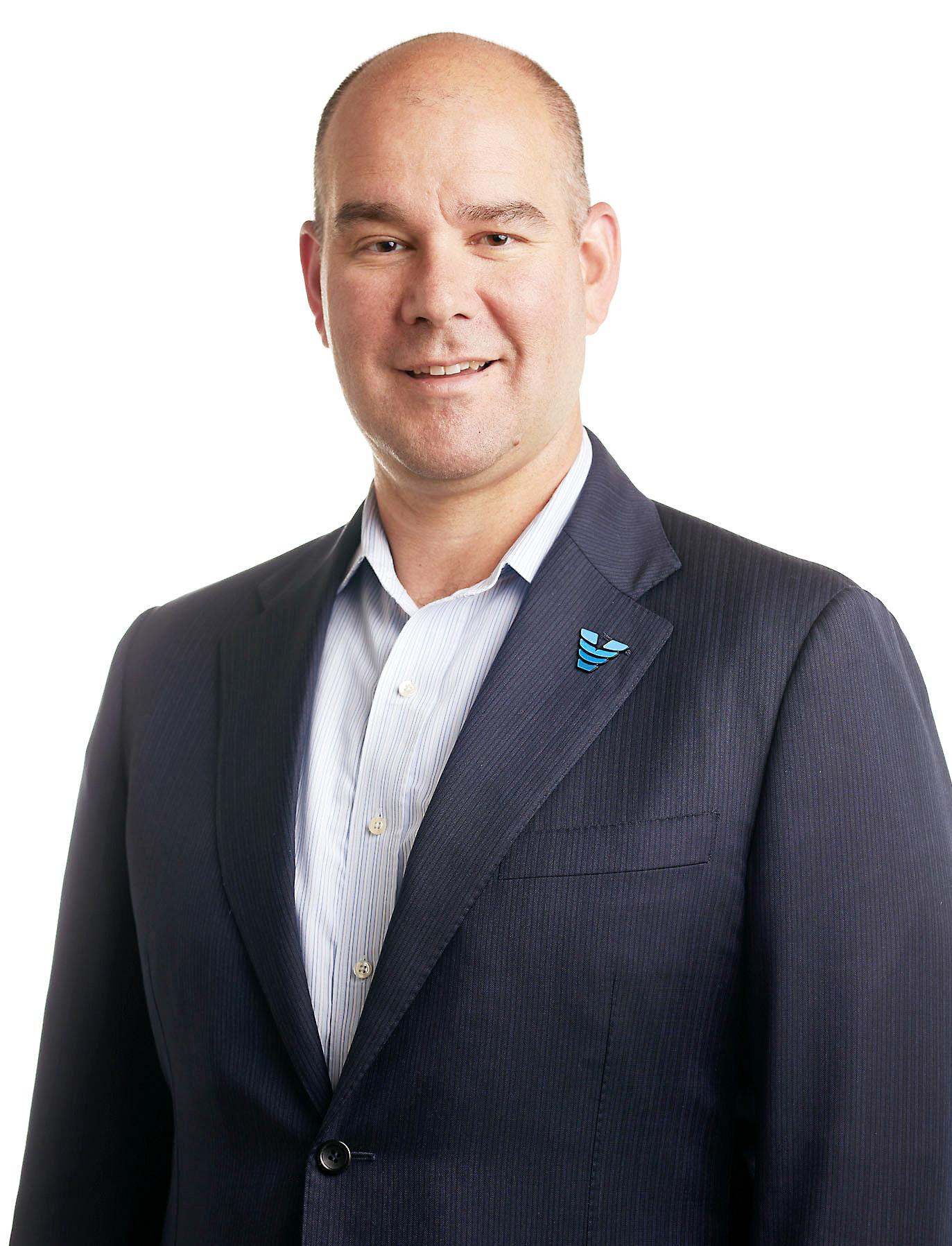
She previously worked in a hospital, including helping stroke patients to recover speech and swallowing function. These familial ties to healthcare workers greatly inspire him, but he says, “I’ve always had an interest in doing tech work.”
This passion brought Kizner to Silicon Valley in what he refers to as “back in the heyday of the dot.com boom.” While at a large law firm, the GC worked with Stentor, a start-up client in the healthcare IT space that made an innovative picture archive and communication system, as their first in-house counsel. “That was my first taste of working as an in-house lawyer for a health tech company. It was an amazing experience; it was very different from big law firm law. I really liked the mission.”
Five years into his time at Stanford University Medical Center, Kizner began consulting for Viz. Not long after, when Viz.ai received its first FDA product clearances, he joined the start-up as general
David Kizner General Counsel, Chief Privacy Officer Viz.aiIt has been a great pleasure for Excis Networks to play a part in both Viz.ai’s and David’s success, and we offer our congratulations. They have been driven by a desire to innovate and change healthcare for the better by the use of AI, improved hospital workflows, and faster diagnosis of an increasing number of diseases to improve patient outcomes.
Excis Networks shares Viz.ai’s and David’s vision for constant improvement, and it is a core tenet of the way we work. We are specialists in helping Software as a Service companies enter new markets, such as the EU. Our services ensure they are compliant with laws and regulations, such as the GDPR, NIS Directive, and Medical Device Regulations.
Our techno-legal practice covers data protection, cybersecurity, and legal services, providing a unique, full data life cycle coverage that includes key areas of compliance. We specialise in medical devices, medical software as a service and biometrics, other areas of AI application, and technical innovation.
If you would like more information about Excis Networks, we would welcome a discussion about how we can help you in a similar way to Viz.ai.
Please contact Paul Benedek at paul.benedek@excis.co.uk or call +44 7976 411586 for a chat.

counsel. From this type of position—an in-house counsel at a start-up—Kizner feels he can have a greater impact than at a larger organization because he has far more influence on the strategy and direction of the company. Plus, he adds, “there’s an intensity to it that I enjoy.”
Between overseeing both legal and compliance, Kizner remains very active and tied to the business. “It’s really soup to nuts, everything you can imagine in a legal role,” he says. This position allows the GC to lead in his style.
“My leadership philosophy is to hire really good people who are experienced at their jobs, are confident, and have impeccable judgment, and to provide them the tools to enable them to do their work and the freedom to make decisions,” says Kizner.
Leveraging his experience in law firms, health tech start-ups and as a lawyer for a prestigious academic medical center, he guided his team through a successful expansion into Europe, creating relationships with some of the largest life sciences companies, and building an effective privacy
and compliance program needed to meet General Data Protection Regulation, HIPAA and other privacy regulationss.
Kizner credits the success of implementing his leadership approach to hiring individuals possessing his same passion for making a difference in people’s lives. When interviewing candidates, especially those without healthcare experience, he jokes: “Look, there’s nothing wrong with working for a video game company, or some other product. But there’s something special about working in healthcare, when you know the products you’re making are being used by clinicians to impact people’s lives.” AHL
STRATEGIC
Weil, Gotshal & Manges LLP: “David is an insightful, strategic thinker focused on positioning Viz.Ai for long-term success. David’s passion for his work is infectious, and it has been a pleasure partnering with him to advance the company’s legal objectives.”
—Adrian Percer, Patent Litigation Partner
BUSINESS PARTNERS. INNOVATIVE SOLUTIONS. ENTREPRENEURIAL SPIRIT.
It is Weil’s honor to collaborate with David Kizner of Viz.ai to devise business-oriented solutions to complex legal issues.
Oregon Health & Science University’s Abby Clifton shares lessons learned in the pandemic that every HR team needs to consider
By Zach Baliva Abby Clifton
Abby Clifton
Abby Clifton says her mission as a healthcare HR leader remains simple. She and her teams exist to alleviate burdens frontline workers face, allowing them greater focus on patient care. That mission guides Clifton in all she does as director of benefits and HR Service Center at Oregon Health & Science University (OHSU).
As Oregon’s lone academic health center, OHSU plays a vital role in community health and education. Its nineteen thousand employees and five thousand students care for patients, train providers, complete clinical tests, and conduct research.
OHSU and its affiliates add more than forty-two thousand jobs and generate over $7 billion dollars for the local economy. American Healthcare Leader recently talked with Clifton about what she’s doing to keep the state’s top-ranked hospital focused on the health and well-being of Oregonians, as well as how she’s navigating the considerable challenges facing the industry today.
You’ve been in HR for about twenty years. What keeps you going?
I love benefits and culture, and everything that goes with it. But it’s the people that make HR really special. When you get a phone call, it can send your day in a whole new direction. There’s variety, and in healthcare especially, you get to align with great people and mission-driven organizations.
I know you talk about HR working in healthcare to let the providers care for patients. Where does that philosophy originate?
I was a benefits manager at Archbold Medical Center in Thomasville, Georgia, working to evaluate coverage trends and suggest changes to our package. The system worked with razor-thin margins and needed all hands on deck, which gave me an incredible opportunity to get broad experience. We had to go outside our job descriptions, explore, ask questions, and push the envelope. The leaders drove home the concept that HR is a cost center, and our job is to make sure the people who provide care don’t waste their work hours worrying about HR stuff. HR people should do that.
What does that take?
It takes thoughtful, consistent, clear, and repetitive communication. It takes knowing how employee needs and preferences are changing and staying close to them. It takes good team collaboration.
Tell me about OHSU. What made it the right fit for you?
I came here about six years ago. We had been in Tennessee to live near my husband’s family, and I finished my MBA. It was time for something new, and I wanted a new challenge. OHSU is large and growing. The challenge is that we have to keep serving our employees, but that can’t mean that HR constantly adds full-time employee headcount to keep up with growth every time we add caregivers. Instead, we need to find more ways to be efficient, creative, and effective.
How do you do that?
There are a lot of ways today through technology and other solutions. We ask managers to do so much related to onboarding. It was a huge amount of
time and paperwork, and then we had four student workers spending their whole time scanning, verifying, and routing employment documents. We now have an electronic system that does most of this for us, and the student workers are available to help our HR specialists with other aspects of their jobs.
Let’s turn to current events and challenges in healthcare. How are those challenges impacting your work? Well, like in most organizations, COVID19 came and all of the sudden people who weren’t providing direct patient care weren’t allowed on campus. All employees had a new set of needs that were suddenly exposed. COVID-19 changed
“We had to go outside our job descriptions, explore, ask questions, and push the envelope.”
everything overnight, and it will change the future. But we see some of the changes as positive.
What’s been positive about it for your teams?
There are new needs that we can meet, and some of the issues that came to the forefront, like mental health, wellness, and burnout, needed to be addressed.

What have you been able to do along those lines?
There was a massive childcare need as schools and employers shut down. We got a pop-up childcare center organized in three days. We later partnered with local schools and opened it up to other people, not just our employees. We’re going to explore ways to expand childcare support permanently into the future. We did other programs, too—stipends, grants, and various other things. The popularity of what we offered showed us that HR in healthcare needs to shift from reactive to proactive. We are never going back to the way things were in February of 2020.
So what does it look like going forward, then?
That’s a good question. Some people will be hybrid. Some will be remote. We’re changing the way we’ve always done things—employees are demanding it. They want a better balance of work and personal time. They want better support for their mental health and their families. And we have to deliver.
We hear so much about mental wellness, but are employees really taking advantage of what you offer?
Overwhelmingly so. People who wouldn’t have time to commute to in-person sessions started seeing providers online. We saw a huge uptick in virtual usage. Even with a virtual option, we’re experiencing a shortage of providers in the area, so we’ve started using niche vendors to fill the gap. We found and advertised a twelve-week program that was very popular, and we’re looking to build out this piece even more. This goes to the communication piece from earlier. We’re going to keep talking to employees and rework the solution until we have what they need. We want to explore every route and every idea, and not just pick one thing and stick with it.
What else is big right now?
[Diversity, equity, and inclusion] DEI and work-life balance. Our teams figure out what works for them when it comes to balance. We allow flexibility based on the work performed by the departments and ask leaders to set the tone. My team mimics my behavior, so I stop communicating at five in the evening. When my kids get home from school, I set my phone down, and I focus on them. We have to. There is a temptation to do too much when you work at an academic medical center. But our work is ongoing; it will never come to an end. So we need to find a healthy rhythm.
Why are you still in healthcare?
I will never be a frontline caregiver. I will never be a nurse or a doctor or a person in a research lab . . . but it speaks to me to be a person who supports those individuals. It’s rewarding to do what we do in this industry and for this organization. AHL
Nic Riesenberg champions the foundation of healthcare in his leadership role at North Kansas City Hospital—the maintenance, food and nutrition, real estate, construction, and environmental services workers
By
Zach BalivaNic Riesenberg remembers rising before the sun climbed over the hills in rural Iowa. Mornings were an important time on the family farm. As the youngest of thirteen children, he understood the need to contribute at an early age. Each day, Riesenberg had meaningful work to do. He fed the animals, watered crops, fixed equipment, and helped cook breakfast—all before the start of the school day.
Today, the vice president of facilities and support services at North Kansas City Hospital (NKCH) manages the
hardworking teams keeping the provider operational. Riesenberg oversees employees in environmental services, food and nutrition, maintenance, construction, and real estate. Together, they clean five hundred rooms per day, serve a million meals each year, and maintain 1.8 million square feet of space.
The habits Riesenberg learned on the farm have stayed with him throughout his entire career. While he may not be doing physical labor fourteen hours a day, he’s still waking at sunrise and covering a lot of ground. He arrives early each
morning and starts his workday rounding throughout the hospital as it opens.
“As the youngest in a large family, you learn to listen a lot,” he reflects. “That’s what I do. I walk around. People talk, and I listen, and hopefully we can solve big problems together.”
During rounds, he asks his colleagues how they are doing, what challenges they face, and what tools might improve overall output. Most importantly, he’s getting to know people, strengthening culture, and creating community. “The more we build community, the more
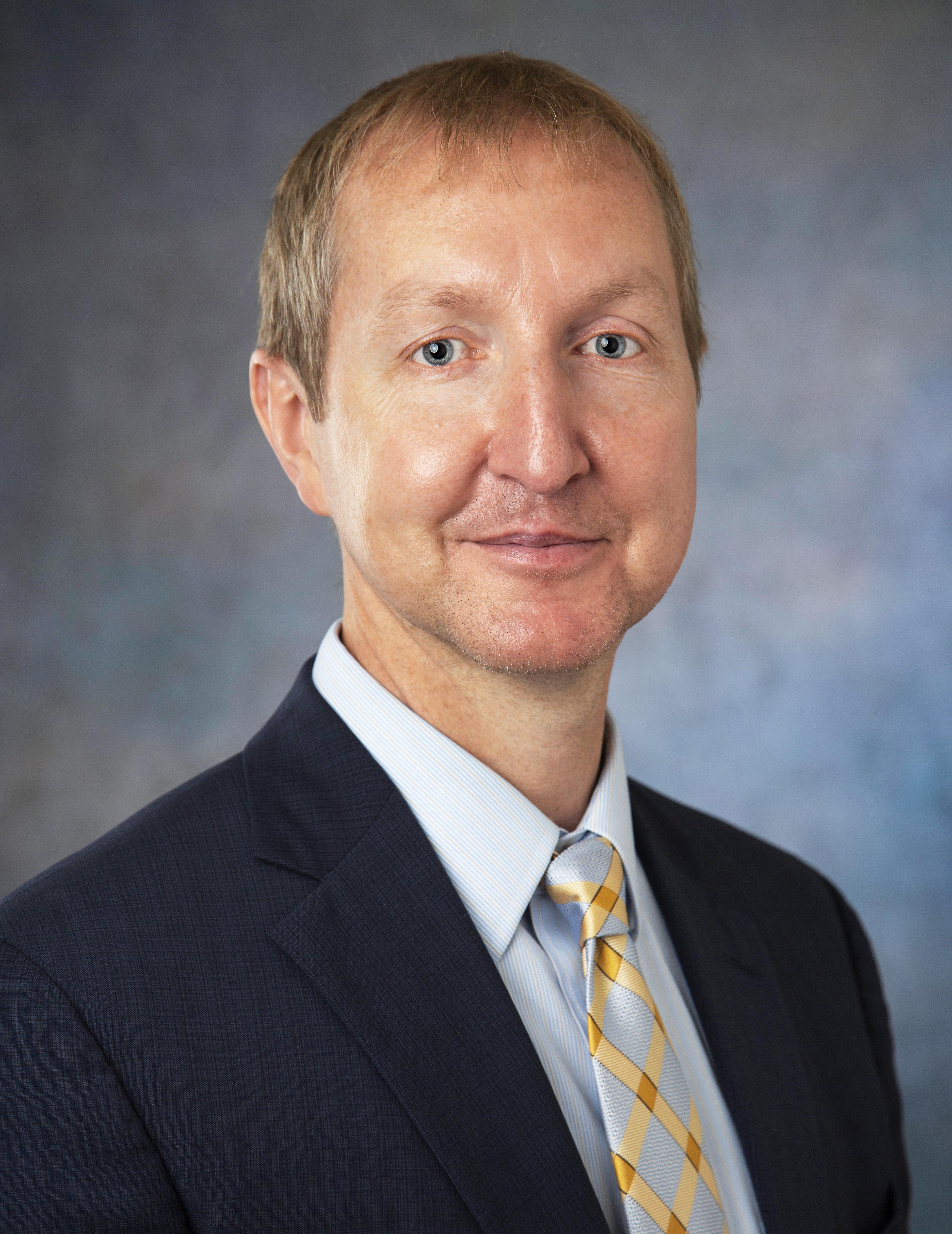 Nic Riesenberg VP of Facilities & Support Services North Kansas City Hospital
Nic Riesenberg VP of Facilities & Support Services North Kansas City Hospital
people go above and beyond to help,” he explains.
Riesenberg’s upbringing gave him a passion for finding creative ways to increase efficiency. That interest led him to study construction engineering at Iowa State University before starting his career as a carpenter and project engineer. Not long after that, the young professional began heading large teams working on multimillion-dollar, high-rise projects.
The importance of strong leadership is something Riesenberg knows
firsthand. While his dad was a selftaught farmer and bus driver, his mom assisted people with disabilities. They were both hard workers who lacked mentors. “I’ve seen people struggle and teams fail because they need better managers,” he says.
In 2010, after deepening his expertise and stepping into roles of increasing responsibility, Riesenberg transitioned into healthcare as a facilities manager at the University of Kansas Hospital. Working with administrators and
department heads in an active hospital setting to make clinicians more efficient opened his eyes to the potential of using his background to impact patient care.
“I enjoy working in healthcare because it’s a challenging and important environment where customer service and quality really matter,” he says.
Riesenberg joined NKCH in 2019 and started analyzing an ongoing master plan while developing new standards and processes. He was quickly promoted to his current role, which entrusts him with ensuring that facilities and support services teams collaborate with all other hospital departments.
“Teams in healthcare settings can sometimes default to staying within boundaries that limit them, when thinking in new ways can help the hospital accomplish more,” he explains. In times when teams are stretched thin and administrators need to do more with less, Riesenberg reconfigures teams, enhances communication, and blurs the lines of responsibility.
He encourages and expects each team member to work outside of a traditional or narrow job description, leading by example. It’s not uncommon to see Riesenberg lending a hand, or his empowered employees deviating from assigned duties to serve patients, families, and each other—knowing they have full support from the NKCH leaders.
“A facilities and support services worker can either focus on completing just one task as quickly as possible, or they can get in the habit of looking
“A facilities and support services worker can either focus on completing just one task as quickly as possible, or they can get in the habit of looking multiple steps ahead and impacting care.”
multiple steps ahead and impacting care,” Riesenberg says.
Once, while cleaning a room, a housekeeper intervened and saved the life of a choking patient. Similarly, support services staff frequently respond when passing rooms with alarms sounding, indicating that patients are attempting to get out of bed. “If our workers simply talk to patients and stall for a few seconds before nurses arrive, we’ve helped prevent a fall,” Riesenberg says.


His most recent rounds demonstrated the hospital’s culture in action. Walking into the cafeteria, he noticed a room service supervisor and several of her teammates filling in as cashiers when the food and nutrition team was missing five employees during the shift. Workers didn’t panic or even report the problem to leaders and wait for a response. They simply saw the need, figured out an immediate solution, and solved the problem without interrupting service to guests.
When the hard work was over and the long day ended on the family farm, Riesenberg usually ran around with his siblings or played basketball. At NKCH, it’s one of the few moments of quiet in his office. The VP logs into his computer and spends some time catching up on emails.
As he pulls out of the parking lot, he scans the buildings and campus to make sure everything is in order. The sun starts to dip below the horizon. Riesenberg sighs and heads home content, but ready for more. The hard work may be over, but the midwestern farm kid knows another day is coming. AHL



• Patient Gowns & Apparel
• Comfort Care® Gowns
• Bed & Bath Linens
• Scrubs & Lab Coats
• Surgical Gowns & Towels
Committed to building strong partnerships, Kelly Construction Group, Inc. is an award-winning Kansas City rm specializing in providing comprehensive pre-construction, construction management, general contracting and design-build services for clients across a wide range of markets. Our team has earned a reputation for excellence in customer satisfaction with a focused commitment.
Kelly Construction’s management structure is built on resources which enable us to deliver aggressively scheduled projects on time and within allocated budgets.
• ScrubVAULT® System


• Storage Solutions
• Hygiene Program
• Microfiber Solutions

• Floor Mat Program
• Cubicle Curtains

Your patients’ satisfaction isn’t a number. It’s an experience.
EPIC is not your average insurance broker and consulting company. The unique San Francisco-based firm has proven expertise in both mainstream and specialty industries. While the company serves clients in accounting, education, hospitality, and healthcare, it also offers property and casualty coverage—such as coverage for terrorism and valuable fine art collections—and manages ransom and war risks for luxury super yacht owners.
With fifty-seven thousand clients, the brokerage founded in 2007 is now one of the fastest-growing in the insurance
industry. It takes a dedicated team of professionals with deep expertise and experience in specialty insurance to build a responsive and innovative company truly able to provide customized advice, direction, and support. Craig Hasday is EPIC’s lead expert in healthcare.
The president of the national employee benefits practice helps administrators navigate employee benefit plans, understand cost transparency, and address spending waste in an ever-changing field. “Times are tough in healthcare, and the creative solutions we bring to our partners help them optimize benefits
programs so they can thrive,” he says. The measures also increase employee retention in a landscape plagued by burnout, competition, and the Great Resignation.
Now more than ever, hospitals, clinics, and health systems need someone like EPIC in their corner. Hasday has over thirty years developing and deepening niche expertise in the benefits space, which has equipped him with a unique talent. “I like to think I can see the future,” he says.
By that, Hasday means he stays ahead of emerging trends to help clients develop proactive solutions before gaps and
liabilities emerge and solutions are hard to come by—something the Queens native has done for his entire life and career. He studied accounting, became a CPA, and worked as the CFO for an international thoroughbred horse racing company.
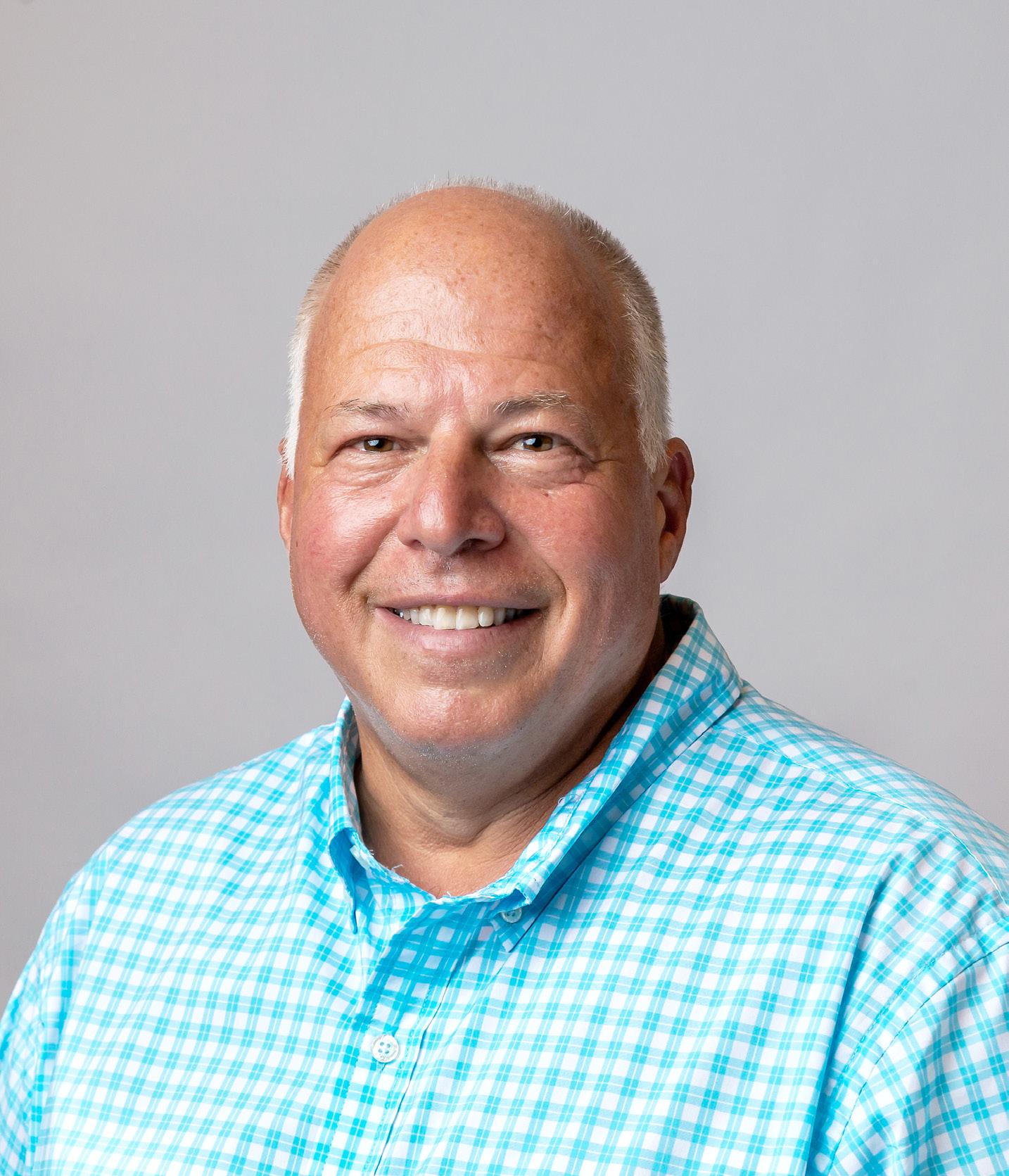
Hasday enjoyed life as a CFO as his company found success. In fact, he once owned 2 percent of Theatrical, the winner of the 1987 Breeders’ Cup Turf Award. But in 1989, his uncanny ability to predict the future compelled him to make a change. “I noticed that healthcare was changing, and costs were escalating. Those changes brought opportunities I wanted to get out in front of,” he says.
Not only is Hasday a trained financial analyst, he also had worked with CEOs and HR leaders. He knew those people would need help adjusting to changing cost controls and creating new employee benefits programs. The opportunity drove him to join his father’s insurance company.
Unfortunately, a minor heart attack cut their days as colleagues short. The elder Hasday survived, but retired and left his son to manage the business, which merged with Frenkel Benefits in 1992. As president of Frenkel, Hasday managed the organization and taught clients how to step outside of life as passive observers of change and truly manage healthcare costs.
Frenkel went from $2 million to nearly $7 million in annual employee benefits revenue in less than ten years with Hasday at the helm. Simultaneously, the brand developed a reputation for strong global benefits plans, retirement services, and other creative solutions.
Hasday noticed another emerging trend in 2004: employers embracing the idea of encouraging healthy behaviors to control health plan costs. He bought Onsite Wellness and made Frenkel one
of the first middle market employee benefits company with an internal wellness division.
As managed care plans took hold and complicated the delivery of employee health benefits, Hasday invested in building a robust communications team and developed compliance resources, among other improvements. Frenkel continued to grow and became a part of EPIC in 2017.
Now as the leader of benefit practice at EPIC, Hasday is surrounded by other visionary and like-minded leaders, who help elevate his own process. “The management, leadership, and culture here take us to the next level,” he says. “With my partner, Larry Kirshner, we used to make all of the decisions, and now I have the support of others who add value to what we are able to accomplish together.”
The company stands out among the national brokerages in an era of consolidation. A highly collaborative and regionally controlled structure anchored by a strong national leader gives the firm an ability to be both responsive and strategic.
Hasday develops and deploys the national strategies that support those local offices and manages compliance
issues and emerging products, like individual coverage HRAs. Brokers within the EPIC ecosystem can deliver the right services for their specific markets, while tapping into the resources offered by a holistic platform.
In addition to his work as president of the company’s national employee benefits practice, Hasday also uses political action to steer healthcare in a positive direction. He sits on the board of the National Association of Health Underwriters Principal’s Council, has taught at New York University, and has met with or testified before state and national legislative bodies.
“What strikes me most about Craig is his recognition that relationships are key to driving EPIC’s business forward,” says Tony Contessa, regional vice president of the New York and New Jersey region for the Select & Middle Market Segment at Cigna (p.16). “He values partnership and collaboration as much as I do, which gives us a framework for achieving the best outcomes together.”
Today, Hasday again looks into his proverbial crystal ball in an attempt to predict the future and prepare EPIC clients for healthcare disruption. The environment sees continuing forecasts of higher medical costs and significant
changes to the healthcare landscape, including Amazon expanding Amazon Care, Walmart building health centers, and the CVS purchase of Aetna, as well as virtual care delivery and other options. This places more control and greater demands for proactivity in the hands of individuals. Low-cost, high-quality medical care is in high demand.
Hasday looks at these factors and has one prediction. “Healthcare as we know it isn’t sustainable for employers,” he says. Costs are on the rise, the population is aging, chronic conditions are more common, working arrangements are changing. It’s a complex system.
That’s why Hasday and his benefits colleagues at EPIC recommend employers take decisive action to provide real, difference-making solutions for employees and their organizations alike. AHL
At Cigna, good health and well-being are the cornerstones of our purpose and the driving force of our passion. We are champions for affordable, predictable, and simple healthcare. As a global health services company, our goal is to provide the right services and solutions, in the right setting, at the right time, to address the diverse health needs of our customers and patients in a highly personalized way—each and every day. We see healthcare as an investment in the growth of your business, because we’re much more than a health partner. We’re a growth partner. Our data-driven insights improve both employee wellness and productivity, while our quality healthcare mentors provide your employees with the ongoing guidance they need to thrive. And when they thrive, so does your business. To learn more about how Cigna can help you continue to grow, please visit us at: Cigna.YourNewGrowthPlan.com
“I noticed that healthcare was changing, and costs were escalating. Those changes brought opportunities I wanted to get out in front of.”
With experience spanning multiple industries, Joe Mattera applies his unique perspective to help Froedtert Health best serve its patients
By Natalie KochanovWhen Joe Mattera came on board at Wisconsin-based regional health network Froedtert Health Inc. six years ago, he had more to learn than just the ins and outs of his new role. Having spent the past eight years in the manufacturing industry, Mattera needed to find his footing in an entirely different legal landscape.
“I was asking a lot of questions, and I think I wound up asking questions that may have been critical in the manufacturing industry, but perhaps hadn’t always been asked of my business teams at Froedtert before I got here,” says Mattera, now an associate general counsel. “Those questions helped me better understand the healthcare sector and the organization.”
Mattera has continued to apply his multi-industry expertise ever since. He advises on commercial matters impacting Froedtert’s supply chain and information technology (IT) groups, each of which presents its own array of challenges. In addition to meeting those challenges head on, Mattera streamlines internal and client-facing processes, with the goal of creating efficiencies benefiting his fellow attorneys, his Froedtert business partners, and the numerous patients depending on the health network.
Immediately prior to joining Froedtert, Mattera worked in-house at Kohler Co., a manufacturing company likewise based
“What is always—and has to be—front of mind is the impact on patients. My job is to mitigate risk and protect the organization, but, in pursuit of those tasks, I can’t lose sight of the fact that we need to create the best patient experience we can.”
in Wisconsin. “There are a number of businesses at Kohler—kitchen and bath, engines and generators, hospitality,” he explains. “I was able to work in most of them during my eight years there, and I got to handle diverse types of matters and projects.”
That variety suited Mattera, who’s always keen to explore new areas. His eagerness to broaden his horizons paved the way for his jump from Kohler to Froedtert—and from manufacturing to healthcare. “Healthcare is obviously a completely different industry from manufacturing, and a highly regulated one. I’ve learned a lot over the past six years, and I continue to learn something new every day in the healthcare space,” he says.
Even as he was learning on the job, Mattera brought fresh eyes to Froedtert’s commercial engagements. “Coming from manufacturing, I had a little bit of a different perspective,” he confirms. “When Froedtert was buying a piece of capital equipment, I wanted to know not only what the equipment does, but also what happens when it fails. Is it going to impact patient care? What are the implications for the organization as a whole?”
The trickle-down effect of his activities in the legal department, both on patient care and Froedtert as an organization, pushes Mattera to make a constant effort toward process improvement. To that
“The faster we’re able to get commercial contracts done, the faster we can get products and equipment into our facilities to try to give our patients the best care possible while they’re here.”
end, he recently started leveraging digital solutions, such as artificial intelligence and automation, to revamp the commercial contract review process.
“The faster we’re able to get commercial contracts done, the faster we can get products and equipment into our facilities to try to give our patients the best care possible while they’re here,” he explains. “It also helps decrease and minimize the cost of that care. Those are the overarching reasons as to why we’re looking at these initiatives.”
Mattera and his colleagues have found another opportunity for improvement in the way that the legal department manages projects. “We’re in the process of implementing a solution that will offer visibility and transparency across our department as to what major projects we’re all working on. We all have different areas of expertise, and this tool will foster discussions and encourage us to work through projects in a more collaborative way,” he says.
Beyond creating efficiencies internally, Mattera strives to remain abreast of external issues in healthcare that may affect the groups he counsels at Froedtert. On the IT front, he sees cybercrime as an ongoing challenge.

“If there is a data breach or some other event created by a cybercriminal, there are ramifications for patients, whose data may be compromised, and for the healthcare system itself. The reputational
damages in the eyes of the system’s patients and business partners could blow up really quickly,” he elaborates. Security is also of the utmost importance when it comes to the healthcare supply chain. “The COVID-19 pandemic exposed a lot of flaws in supply chain processes and created a lot of challenges for the healthcare supply chain,” Mattera says. “As health systems start to transition out of the COVID-19 pandemic phase, health systems need to continue to be cognizant of potential supply chain-related issues.”
In the face of these and other hurdles, Mattera aims to keep Froedtert on top. “You try to put the organization in the best position possible under the circumstances,” he says. After all, when the organization thrives, so does its patient population. “What is always—and has to be—front of mind is the impact on patients,” Mattera adds. “My job is to mitigate risk and protect the organization but, in pursuit of those tasks, I can’t lose sight of the fact that we need to create the best patient experience we can.” AHL
von Briesen & Roper, s.c . is a Wisconsinbased law firm providing health law services since the 1950s. With more than 180 professionals, von Briesen is positioned to provide unparalleled service and recognized expertise with practical legal advice at a competitive value. We are a law firm that is A Step AboveSM
von Briesen & Roper, s.c. is a Wisconsin-based law firm providing health law services since the 1950s. With more than 180 professionals, von Briesen is positioned to provide unparalleled service and recognized expertise with practical legal advice at a competitive value. Recognized as a BTI Client Service All-Star, by Best Lawyers® and Wisconsin Super Lawyers®, and as a Top Workplace – we are a law firm that is A Step AboveSM
For more information on the services we provide to the health industry, please contact:
Je rey E. Mark at je rey.mark@vonbriesen.com or Stacy C. Gerber Ward at stacy.gerberward@vonbriesen.com.
Jim Hopwood brings a lifetime of turnaround expertise to a patient population that needs more attention than ever
By Billy Yost James (Jim) Hopwood
SVP & CFO
Behavioral Health Group
James (Jim) Hopwood
SVP & CFO
Behavioral Health Group
James “Jim” Hopwood was a turnaround guy. The current senior vice president and CFO at Behavioral Health Group (BHG) earned his stripes doing some of the hardest financial work there is in healthcare (or any industry, for that matter): trying to get an organization back to zero.
“I was used to working with a company that needed to be rebuilt, a company that couldn’t produce enough income to meet its financial obligations,” Hopwood reflects. “Coming here wasn’t a turnaround situation, but it was an incredible opportunity to serve a patient population that needs our help.”
The largest network of Joint Commission-accredited outpatient opioid treatment and recovery centers in the United States wasn’t in turnaround mode when Hopwood arrived in 2019. And, unlike so many companies in the pandemic environment of the following year, the demand BHG experienced only increased as lockdown stress spiked substance use. More and more people sought help for their addiction and mental health issues.
But COVID-19 triggered Hopwood’s early turnaround instincts nonetheless. Experienced in compiling thirteen-week cash flow plans for struggling organizations, and with the onset of one of the most perplexing two years of the last century, Hopwood wasn’t about to stop.
“It was natural to assemble that projection right away, because it was just my gut reaction,” Hopwood remembers. “Fortunately, BHG’s census continued to grow, and I never had to look at it much after I made it.”
When Hopwood got to BHG, the organization had fifty-four locations. At present, they’re right around 117. They’ve more than doubled their footprint since Hopwood came aboard, and it’s put the CFO in the position of not just steadying a ship, but helping enable the desperately needed next wave of treatment options for those struggling with substance use disorder.
Hopwood credits the work of CEO Jay Higham and Chief Medical Officer Benjamin Nordstrom, whose guiding vision helps establish a new standard of care for treating addiction issues. That starts with understanding that it’s rarely just a single issue that needs to be addressed.
“We’re working to expand the types of programs that we offer to make sure we can provide the best outcome possible for any particular patient.”






“Medication assisted treatment is a data-proven and successful therapy for substance use disorder. Nonetheless, we’re working to expand the types of programs that we offer to make sure we can provide the best outcome possible for any particular patient,” Hopwood explains. “Many substance use disorder patients have co-occurring mental health conditions, and these are issues a traditional substance use clinic hasn’t addressed.”
BHG is expanding services to treat mental health conditions in the same setting. The convenience can help patients stay on their recovery journey long-term. Then, there is life beyond addiction.
“Here at MedSTAT, we are especially proud of our association with Jim and BHG,” says CEO Jonathan Connell. “Through the pandemic Jim ensured high-quality patient care by investing in strong, reliable, vendor relationships. We strive daily to preserve the trust he has put in MedSTAT as a valued source of medical supplies. We look forward to a lasting and beneficial partnership with Jim and the BHG team.”
Through collaborative community partnerships, BHG also helps guide patients in tackling challenges like workforce return, food and housing security, and all of the difficulties one might face when rebuilding their lives in recovery. Unfortunately, navigating what governments and insurers are willing to pay for services always proves a challenge, and the mandates for what that service entails can often seem contradictory or just plain ineffective.
To truly combat the epidemic, our country needs to address one issue that surfaces repeatedly: the difference between a proactive and a reactive approach. The substance use industry started accepting Medicare in January 2020; Medicaid has only covered treatment since the late 2010s. The support we provide to this population needs to go much further.
Hopwood took the lag as a personal challenge. The CFO’s financial expertise provides much-needed know-how to an industry with a nascent institutional understanding of third-party payers and billing. “I saw something that needed my help,” Hopwood says. “It’s been a privilege to bring my experience to an organization that is growing quickly and is really helping people.”
Hopwood also remains deeply interested in how the organization will continually leverage the volumes of data it collects.
“I love the idea of being able to help explain a situation or diagnosis with the data we’ve collected and analyzed,” Hopwood says. For example, BHG crunched data and discovered that the number of counseling sessions a patient receives early in their treatment has statistical significance and can be used to predict their likelihood of staying through the first ninety-day treatment cycle.
“That may be a simple example, but it just demonstrates what you’re able to accomplish if you understand what you’re doing with all of this data,” he explains. “I love being able to make that data accessible and understandable for a broader audience. Our local operations teams utilize the data we have collected on a daily basis to better understand and optimize their treatment programs.”
That passion for making information accessible is a hallmark of Hopwood’s leadership. Too often, he says, the financial side of a business lays out the numbers with the attitude of “this is how it is, deal with it.” That’s never been his way. He reached his level by investing time and effort into making sure that he acts as a true partner, offering advice and opportunities instead of dictates and ultimatums.
“It has been a privilege to partner with Jim and the team at Behavioral Health Group and help support the important work they are doing to best serve their patients during this critical time of the opioid epidemic,” says David Watkins, director of strategic accounts at Hikma.
Hopwood also applied his expertise to the company’s 401(k) committee. He says he wants to make sure those at BHG can be confident in the investments being made for their futures. It doesn’t leave a lot of free time for Hopwood, who admits he spends any spare minute researching investment opportunities.
“What’s important to me is thinking ahead and investing for the future. Not everybody does,” Hopwood says. “I’m just the kind of person who thinks about how I can help everybody do the same.” AHL
As a lead arranger of healthcare loans for credit facilities up to $1B, Capital One Healthcare has specialized experience in more than forty industry sectors. Supported by the resources of a Top 10 Commercial Bank and a dedicated Behavioral Health Group, our clients have access to flexible, tailored financial solutions.
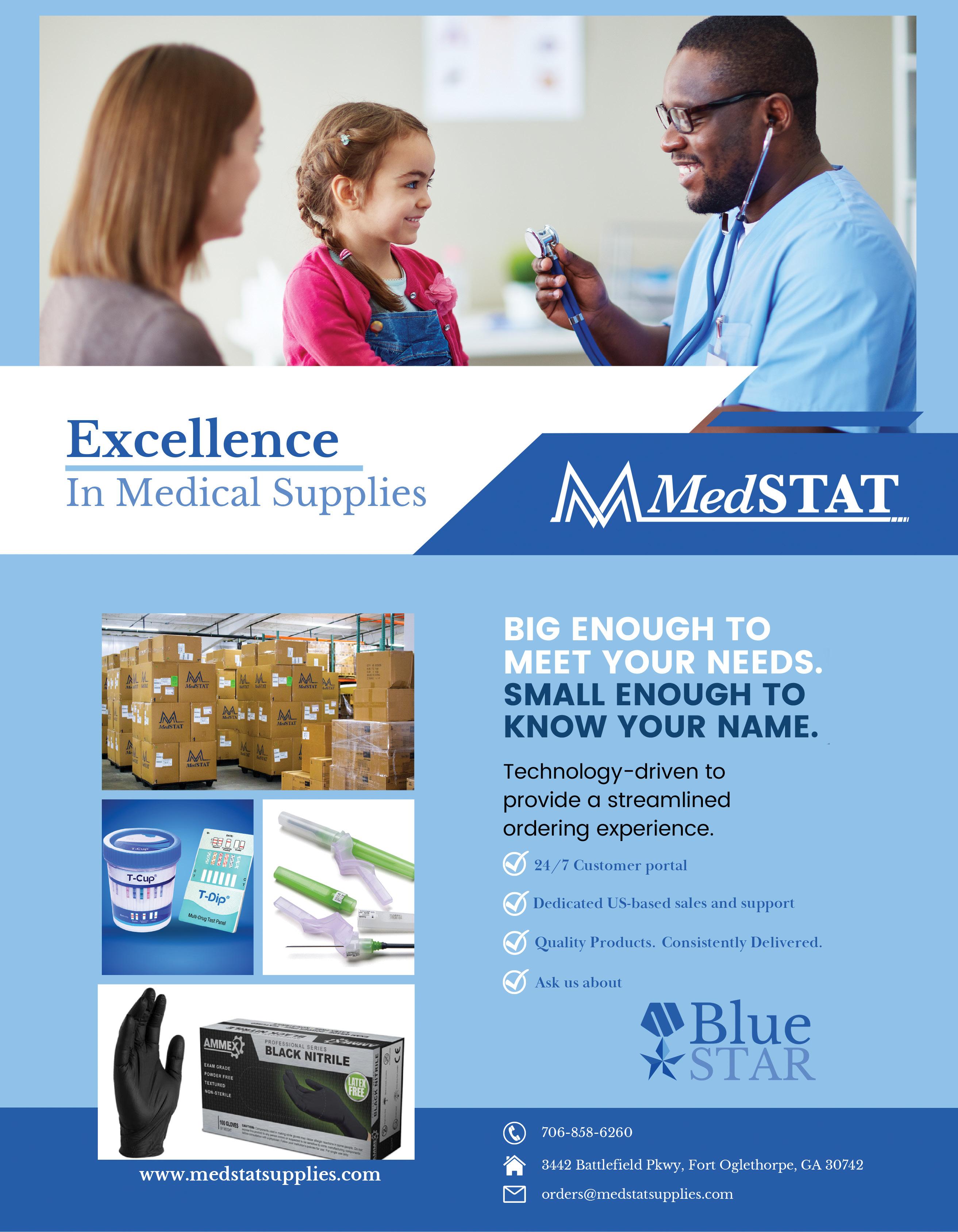
Scott Hollander is taking on new challenges at Dr. Reddy’s Laboratories, where he’s learning how to manage risk to prevent a single issue from rippling company-wide
By Frederick JerantF or most of his career, Scott Hollander followed the typical workflow at a private practice law firm: attorneys are assigned cases, work them to their conclusions, and then take on more.
Hollander joined Wolff & Samson PC (now Chiesa Shahinian & Giantomasi PC) in 2010, and focused on litigation during his first few years. “It was mainly commercial cases,” he recalls. “The work seemed to match my skill set and my personality, and I liked it. But I wasn’t passionate about it.”
His portfolio expanded to include individual, government, and corporate clients in sensitive and high-stakes matters. While he focused on white-collar criminal defense, internal investigations, complex commercial litigation, and e-discovery, he also assisted clients with compliance, regulatory, litigation, and corporate governance challenges.
As his responsibilities grew, so did his knowledge, which in turn spurred his passion. “I just like to learn,” he says. “Not merely what I need to do my job, but all sorts of things. I keep up with news, changes in the legal world, and many other topics because I enjoy them. Knowledge is valuable; it is a sort of currency.”
His urge to take on greater challenges grew as well. “I was at the stage of my career where I wanted to expand my skill sets and develop some significant experience in a single area,” Hollander says.
“Healthcare and pharmaceuticals were attractive to me, particularly because I’d also had experience in those industries.”
In 2021, he found his niche with Dr. Reddy’s Laboratories, where he’s now assistant general counsel for compliance, investigations, and litigation. Dr. Reddy’s Laboratories is one of the top drug-makers in India, developing and manufacturing generic drugs (branded and unbranded) and bulk pharmaceutical ingredients. Its product range includes ulcer medication, antibiotics, antidepressants, pain relievers, diabetes treatments, and cardiovascular drugs. The company also produces generic biotech products and provides an array of custom pharmaceutical services.
The shift from private practice to in-house brought some surprises. “I really hadn’t appreciated how many things are important to an in-house counsel,” he says. “I needed to review documents, issue approvals, evaluate strategic plans, plus learn to build internal relationships, determine who to communicate with and when—it seems everything creates a ripple effect that can spread throughout the company.”
That could be daunting on its own, but working at a multinational company means Hollander faces additional hurdles. “It’s tough to get things moving quickly,” he explains. “It’s partly because of the time difference—and partly a byproduct of having colleagues across
In developing our new brand, we asked clients what they appreciated most about our firm. Their response: they value the extraordinary team of legal talent we have assembled, our dedication to client service, and our honest, ethical approach.
time zones. When I set a Zoom meeting, the time is likely going to be inconvenient for at least some of them.”

The overall environment was profoundly different too. “In-house, you learn to work with a much broader group of businesspeople—not just other attorneys—who have their own objectives, understandings, and considerations,” Hollander says. “You learn to speak differently with different groups of people, so you need to understand your audience and their respective goals. In turn, that prompts me to think about the best way to optimally execute my function and benefit the company.”
While the day-to-day case management is similar, he has to keep a close eye on overall strategy. “Do we file a motion? Do we settle? Engage on a particular topic? I often find myself in an advisory capacity, as well as a legal one, and both are critically important,” he says.
That advisory role helps Hollander keep the company proactive rather than reactive. Every few weeks, he reviews every matter on his schedule to try to forecast what’s coming next. For example, they might need to turn to outside counsel or bring in an expert consultant. “There’s a real benefit to thinking ahead, because things don’t happen instantly,” he says. “There’s a host of challenges in assembling all the resources you need to accomplish a goal.”
Lest you think his interactions are limited to the C-suite, Hollander points out that he’s the regional compliance officer for the US and Canada. “One of our charges is to be front-facing with our employees,” he says. “I do that by meeting with every new hire—acquainting them with the company’s culture, policies, decision-makers, and other key topics. It sets a good tone just as they’re starting out and sends a positive message.” AHL
“I just like to learn. Not merely what I need to do my job, but all sorts of things. . . . Knowledge is valuable; it is a sort of currency.”
National, and even global, forces have an unmistakable impact on an executive’s work. Whether it’s a legislative change or an industry-disrupting technological breakthrough, executives must constantly adapt their business strategies to keep their company thriving.
80. Renu Chhabra McKesson
84. Lori Braender Aquestive Therapeutics
88. Gary Fennessy Northwestern Medicine
92. Michelle Adamolekun Cone Health
98. Jenn Higgins Guardant Health
102. Anne Robertucci Prisma Health
Renu Chhabra tackles her most complex assignment yet: providing healthcare for healthcare workers at McKesson
By Billy YostI f you’re a member of the benefits team led by Renu Chhabra, expect that she is going to fight for you. The vice president of benefits and well-being at McKesson has been an advocate for as long as she has been alive: as a first-generation Indian American who was raised in Rowlett, Texas, she existed in a community where her culture singled her family out as different. “I grew up being firm in
who I was, because I believe you have to protect your family and people that you love,” Chhabra explains. “My leadership has always reflected that. I make sure that my people are taken care of because it’s the right thing to do.”
That care was most immediately applied to her older brother while they were growing up. Chhabra’s brother has special needs, and she kept a watchful
eye on him (and still does to this day).
When her father passed away a year ago, Chhabra took legal responsibility for her brother and continues to help him navigate his life.
With that steadfast commitment to her family in mind, it’s no wonder that the VP has found success in so many different facets of the HR space. Chhabra has spent time both in-house and as

In her first 120 days at McKesson, Renu Chhabra was tasked with offering vaccines and vaccine education for distribution centers across the United States. The training to encourage vaccination was created and scaled across all center locations before the end of 2021.
The program was successful, the VP says, because they worked with people from the communities in which their frontline workers live and work. “It was an incredible project in a very short period of time,” Chhabra says.
an outside consultant throughout her career, weaving in and out of experiences and industries, building out HR expertise all over the board.
The actuarial mathematics majorturned-HR specialist says her own adaptability has been key. She’s a technicalminded professional with the heart of an HR executive. She can run the math and build the algorithm, but she can also lead with empathy. Now, at McKesson, Chhabra says she’s currently in one of the most complex roles she’s ever tackled.
“When you do benefits for a manufacturing company or a real estate company, it’s a very different experience,” the VP explains. “When you’re doing healthcare in healthcare, many of the stakeholders have an opinion. What
I love about the role is also the most challenging [aspect]: you need to communicate with everybody.”
Chhabra has helped usher in change when it comes to McKesson’s insurance plan. For the last ten years, the organization has primarily offered HSA plans, which can be intimidating for some people. “One thing that made sense was to add a PPO plan. We presented prevalent benchmarking and were able to make it happen,” she says.
It’s incredible that Chhabra was able to build so much consensus during a pandemic, and in such a short period of time. But the VP credits SVP of HR Neisha Strambler-Butler with helping her make an immediate impact. “I’m lucky that I work with such an incredible leader,
“When you’re doing healthcare in healthcare, many of the stakeholders have an opinion. What I love about the role is also the most challenging [aspect]: you need to communicate with everybody.”
who has helped guide me,” Chhabra says. “Even when she saw me going astray, she would lead me back to focusing on where I needed to be. She’s been instrumental for me.”

Chhabra’s own trajectory is also proof that taking the time to focus on what matters most doesn’t always negatively impact a career. Seven months after her son was born, Chhabra stepped down from what she saw as a dream role. “My husband and I just understood that there are moments when you can spread your wings and other times when you need to sit down and focus on your home.” The executive worked a more manageable consulting role while raising her son, and four years later, was ready to return in-house. That return was to McKesson.
The HR pro says in the short term, she’s looking forward to working on McKesson’s wellness programs and bringing more value to employees. In the long term, she hopes to grow her career at McKesson. But right now, it’s about the people.
“Right now, I want to continue to work on our plan offerings,” the VP says. “This is healthcare for healthcare, and I want it to be center stage. More importantly, I just want to make my people happy in their lives.” AHL
Lori Braender leverages her pharmaceutical industry experience at law firm Day Pitney to build Aquestive Therapeutics’ legal function from scratch
By Andrew TamarkinPlenty of lawyers move from private practice to in-house work—however, most don’t invest thirty-five years at the same firm before making the jump. Lori Braender seems unfazed. “It was a natural progression,” she says.
In 2018, Braender left her position as a partner at law firm Day Pitney to act as the senior vice president and general counsel for Aquestive Therapeutics. There, she wears several hats. A member of the C-suite, she not only offers legal advice on complex issues but also works with her colleagues in developing the company vision, mission, and goals. Her commitment to the work has cultivated a collaborative in-house environment focused on high performance and open lines of communication.
Though she’s spent her career in law, that wasn’t always her plan. “I had no intention of becoming a lawyer in high school or college,” Braender says. “But I explored all options for discussion and was always asking questions.”
Braender studied in France during college, where her university advisor encouraged her to think about law school. She ended up attending Seton Hall New Jersey Law School, where she served as editor on the Law Review and graduated cum laude. Fresh out of school, she accepted an offer at Day Pitney.
“Coming from New Jersey, I developed relationships with local pharmaceutical companies and developed an expertise in the regulatory environment,” Braender says. “It was a wonderful experience. I was given a lot of initiative and freedom to develop my interests, passions, and relationships with clients.”
She developed a cohesive life science group, for which she brought on new
“We’re working hard to build a healthier future for [diverse] communities and the people who depend on our medicines.”
attorneys and expanded services to support that client sector. She also launched a women’s network. After becoming a partner in her tenth year, she opened an office in Brussels, growing the firm’s international presence in the life science hub of Europe.
At Day Pitney, Braender gained valuable experience, found her legal niche, and grew her client network. When Aquestive Therapeutics—a long-term client—approached her with an opportunity, she put that experience into practice by building up a legal department from scratch.
“I represented Aquestive for many, many years, and was able to be part of their team as a trusted advisor,” Braender says. “I was engaged in a lot of their strategic initiatives and the development of their mission and goals, so I really felt like I had a strong role with the company before I joined.”
In private practice, Braender represented several clients simultaneously; moving in-house for Aquestive required shifting her energy toward the success of a single client.
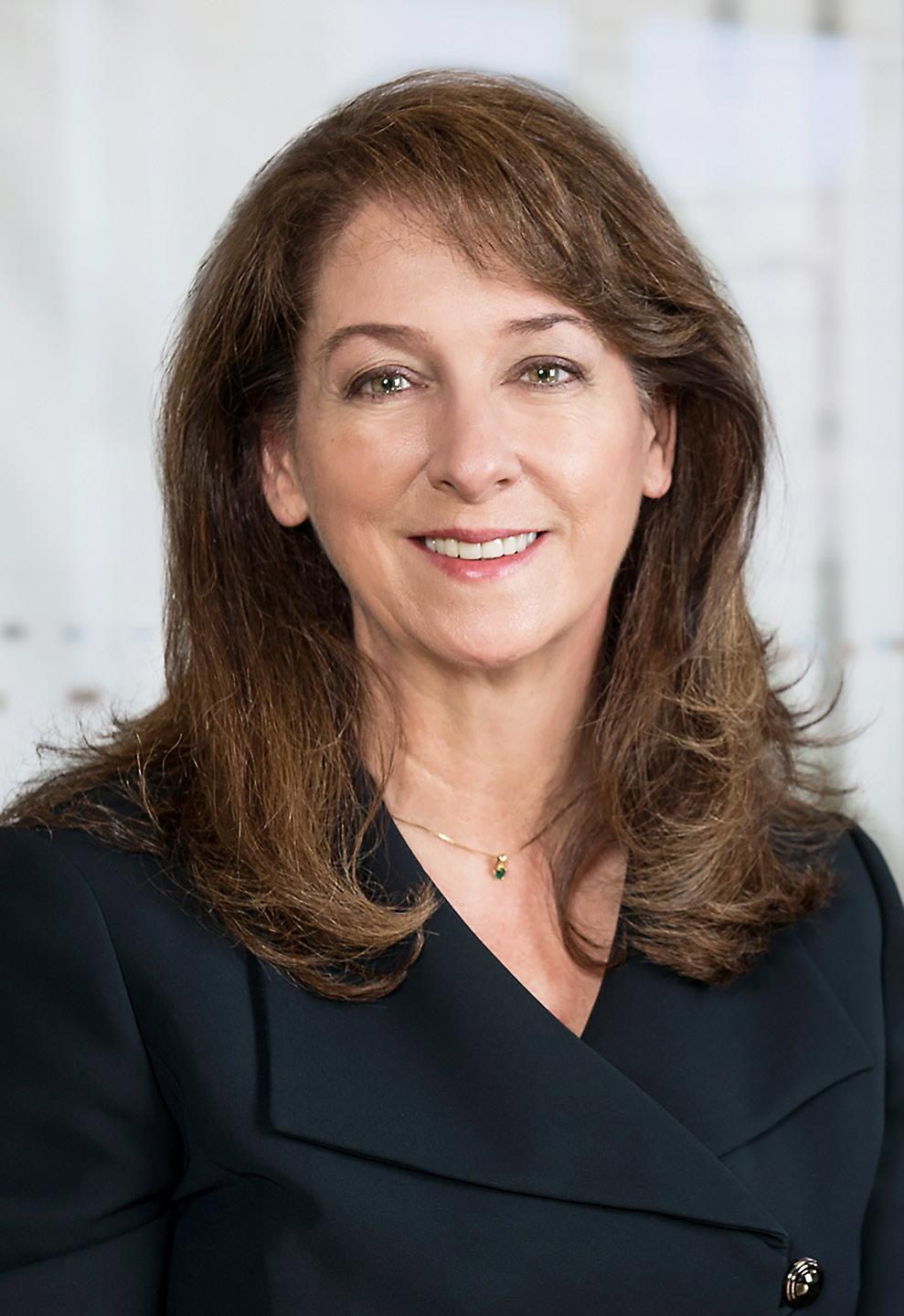
“Focusing the last phase of my professional career on developing a legacy for [one] company in helping them to build out the legal function was a wonderful challenge for me,” Braender says. “And it certainly had a lot to do with the team I was joining. The CEO and other senior executives were so passionate, committed, and dedicated to the mission and vision of the company that I embraced [the opportunity] wholeheartedly.”
Aquestive Therapeutics transforms medicines onto a produced film strip— administered under the tongue or on the side of the cheek—for patients requiring alternative delivery of existing treatments. ALS and epilepsy patients, for example, often become unable to swallow; Aquestive’s products aim to fill that gap in healthcare.
Ron Wyatt Lori Braender SVP, General Counsel Aquestive TherapeuticsBraender serves as general counsel, chief compliance officer, and company secretary and sits on the senior executive team. This entails leading corporate communications, working closely with industrial relations groups, supporting analysts’ outreaches, and managing the legal governance needs of the board of directors.

Leading Aquestive’s comprehensive ESG disclosure program, she ensures medical waste taken off-site complies with regulations and that water systems do not contribute to environmental hazards. She also evaluates how diverse groups are represented companywide and plans to develop programs to expand these metrics.
“We’re working hard to build a healthier future for those communities and the people who depend on our medicines,” Braender says. “This is an initiative that the market is going to demand companies observe going forward.”
Braender also meets with her teams weekly to assess immediate and expected needs, set performance goals, and confront challenges.
“When I am open, sincere, and able to show my passion for the success of our company, it engenders the same feelings from my team. That automatically creates a collaborative, inclusive environment,” Braender says. “[Everyone has] a voice in whatever matters we’re working on, whatever the strategies we’re developing.”
For Braender, it’s rewarding to work diligently toward a mission that ultimately improves the lives of countless patients. She requires the same energy from her team. “If you want to be successful and bring value to your company,” she says, “you’ve got to work hard, be dedicated, and support your colleagues in every way you can. I’m passionate about what I do.” AHL
We salute Lori Braender for her dedication and achievements at Aquestive Therapeutics

Day Pitney is proud of our longstanding partnership with Lori and Aquestive Therapeutics and looks forward to continuing to provide efficient and innovative legal services.
Always there for you. Day Pitney.

“When I am open, sincere, and able to show my passion for the success of our company, it engenders the same feelings from my team. That automatically creates a collaborative, inclusive environment.”
G
ary Fennessy has seen many triumphs and challenges during his tenure at Northwestern Medicine since joining the academic medical center in 1982. Over the last forty years, from his front row seat, he has watched Northwestern expand from a single hospital to eleven hospitals, two large physician groups, and more than two hundred locations across the greater Chicagoland area.
“When I started, we had approximately two thousand employees; we have
now grown to over thirty-five thousand employees,” he says. “It has been a privilege to witness and actively participate in that growth.” Having led all supply chain activities for the growing organization since 2013, the vice president has learned to “look for the lemonade” during challenging times.
Anyone who’s spent a fraction of the time Fennessy has accrued in the healthcare world knows the sector presents its share of challenges. It’s bound to give
any professional a proverbial bowl—or even bushel—full of lemons. With this in mind, the VP manages to find the opportunity, lesson, or positive aspect of each sour situation he encounters.
“I try to find the lemonade in every challenge that makes its way to the supply chain team. We can’t always control what happens, but there’s always something to learn or some way to grow as an individual, a team, or an organization,” he explains.
Fennessy spent most of his life and entire career in and around Chicago. He studied at DePaul and joined Northwestern as an accountant in the office of research. That introduction as an accountant eventually led to his role as director of financial planning, which included oversight for budget planning and long-range financial planning.
In 1987, Best Hospitals in America named Northwestern Memorial one of the top hospitals in the nation. Before long, Fennessy found himself progressing through the organization and interacting with key leaders. As director of financial planning, he worked alongside a new CEO, COO, and management team that began developing and reimagining Northwestern’s future. Fennessy oversaw the creation and development of the first long-range financial plan supporting the financing of a new $580 million medical center located in the heart of Chicago. That facility opened its doors on May 1, 1999.
For the Chicago native, the next fifteen years brought increased change and opportunity as the health system rapidly expanded. In that era, he held many roles, including acting CFO, that led to expanded roles in hospital operations. In 2013, he was asked to take a system role and lead supply chain activities full time for what would become an elevenhospital health system.
Northwestern historically has had a top-performing supply chain division. A key operating principal for Northwestern’s supply chain team is that clinicians should lead sourcing and value analysis efforts. Fennessy notes, “The dynamic of having clinical supply chain leadership results in different discussions when someone who has twenty years of bedside experience as an ICU
“The dynamic of having clinical supply chain leadership results in different discussions when someone who has twenty years of bedside experience as an ICU nurse has a conversation with a physician.”
nurse has a conversation with a physician about opportunities for standardization or new product introductions. It creates a platform of trust and engagement.”
The COVID-19 pandemic provided Fennessy and his leadership team with plenty of situations to look for the lemonade when drugs, supplies, and equipment were scarce. Having the clinical team in supply chain (which was developed years before the pandemic) proved key to addressing the forthcoming challenges.

Several months before the pandemic, the supply chain management team advised him to pay attention to a novel virus originating in China. Fennessy states, “We got an early start on acquisition of respiratory supplies.” The clinical leaders on Fennessy’s team had a premonition of what was headed their way based on prior experiences. “However, even with that preplanning, the level of need far outpaced any early demand signals on supply utilization. We were challenged daily.”
Although the move gave Northwestern a critical head start when COVID emerged, its hospitals still burned through supplies at an unsustainable rate when the early months of 2020 saw packed ERs and ICUs. To handle the situation, Northwestern developed a supply chain command center. They reprioritized all activity centered around providing the supplies and equipment needed to care for patients and for the staff that were being asked to treat and care for levels of activity that no one anticipated.
The VP and other leaders set the tone early. “We took a wartime mentality, and failure was not an option,” he says. “We did everything possible to ensure the caregivers at our eleven hospitals had the
Gary Fennessy VP and Chief Supply Chain Executive Northwestern Medicinesupplies needed to care for patients in a crisis. We reminded ourselves daily that the challenges we faced were minimal compared to what our caregivers were facing, and that provided all the motivation we needed to support them.”
While COVID-19 presented an unprecedented challenge, Fennessy didn’t have to look too far to find his lemonade. “I work alongside the best management team I’ve had the privilege to work with in my forty-year career. Clinician-led teams leveraged every relationship to source beds, ventilators, and supplies. The Northwestern system quickly set new standards on the use of N95 masks and other supplies, and the system was never without PPE at any point. We stayed two steps ahead of the bear and utilized every resource we had to ensure supply and equipment availability.”
Now, as the pandemic recedes, Northwestern’s leaders meet lingering
challenges associated with the Great Resignation, inflation, and product shortages head-on. “Supply chain disruption driven by inflationary pressures, backorders, and the competition to retain and attract talent is an ongoing challenge. We have a strong leadership team that works in a supply chain culture that is focused on continuous improvement. That culture is what allows us to meet the daily challenges we face,” the VP says. Although nearing the end of his career, Fennessy isn’t ready to retire with a cool glass of lemonade just yet. He wants to help Northwestern address some of these issues first. “My role is to execute the strategy as defined by Northwestern Medicine, and we are still in growth mode,” he explains. “A core part of our job is to get the products and resources that our caregivers and patients rely on. After all, the last link in the supply chain is the one to the patient.” AHL
From Procurement to Payment, Casechek automates workflows for all of your vendor-supported procedures

We believe your implant supply chain deserves the same automation as your stock supplies.

Casechek’s platform is the only fully-integrated solution that automates how you manage vendors and their inventory.

“I try to find the lemonade in every challenge that makes its way to the supply chain team. We can’t always control what happens, but there’s always something to learn or some way to grow as an individual, a team, or an organization.”

With two national collegiate sprinting championships on her list of accolades, Michelle Adamolekun is used to moving fast. Her professional career appears no different. Cone Health’s executive vice president and chief people and culture officer spent the early part of her career in tech, a space where moving quickly isn’t just a suggestion but a critical success factor and important survival tactic.
Prior to starting her career in healthcare in 2007, the University of Texas at Austin track star worked across four different industries and harbored an aversion to the perceived speed of execution and transformation in healthcare compared to her experience in tech. Reflecting back, Adamolekun recalls the pivotal point in her career in which a healthcare organization, whose offer she initially turned down, reached back out six months later with an intriguing request for her to strongly reconsider. “I’m glad I did,” Adamolekun shares.

While Adamolekun was positioned strategically on the global tech organization’s leadership succession pipeline, she recognized her own potential growth limitations. Based on the high retention rates in the highly coveted leadership roles, few openings existed at the HR director level.
Additionally, the healthcare organization chose to reengage deliberately and intentionally due its recognition of the value and impact an external perspective might offer to such a critical leadership role and the company. Adamolekun found this an extremely attractive proposition.
Adamolekun remains in healthcare today, and for good reason. “I always found myself on boards of missionbased organizations while in tech. I have found working in a mission-based healthcare organization allows me to bring my whole self to work. I truly get to live my vocation, to be part of something bigger than myself, and this space allows you to do that every single day.”
Mission-based healthcare aligns with Adamolekun’s purpose and leadership intent. “I believe a true measure of my life is how much I can rise above my challenging circumstances, while contributing all I can to enriching and creating value for others,” she says.
In 2021, Cone Health earned the designation Great Place to Work-Certified for 2019–2020. Adamolekun attributes this to the organization’s deliberate and intentional focus on culture, developed in partnership
with management consultancy Insigniam over the past ten years. She remains intent on elevating the culture and focusing on the future through creative and innovative strategies for Cone’s fourteen thousand-plus employees, a cadre comprising over five generations of caregivers and support staff (making the breadth of complexities seen from an HR perspective extensive, to say the least).
“Like most organizations, we’re in a very transitional period of trying to understand the future of our workforce,” Adamolekun explains. “We’re currently in a hypercompetitive market, and the healthcare talent shortage environment has only exacerbated the situation as we move into the future.” For the EVP, it’s about honoring Cone Health’s past and rich history and working diligently to transform as an organization to meet the current demands, while positioning the organization for the future.
Cone Health endeavors not just to source new pipelines for talent but to actually create its own, through partnerships with its workforce development boards, local colleges, community colleges, and even high schools. Leadership actively incentivizes its people to assist in creating those programs and engage their communities, while also helping cultivate future talent.
She also emphasizes the continued build-out of Cone’s already strong culture. Putting her own spin on the Peter Drucker quote, she says, laughing, “Culture eats strategy for breakfast, lunch, dinner, appetizers—you name it. The executive leadership team here at Cone Health understands that implicitly.”
Under the leadership of CEO Mary Jo Cagle, Cone Health is on a transformational journey from success to significance and, Adamolekun says, remains committed to leading its community to outstanding health and well-being.
“Ultimately, our executive leadership team recognizes we must remain focused and vigilant on building and leveraging the capabilities of the organization and employees through the lens of the future, with an eye towards achieving our mission through value-based care,” she explains.
The people and culture team takes a more holistic approach to the health of its people. Whether they’re examining the social determinants of health; evaluating more long-term approaches to mental, physical, social, spiritual, and financial well-being; or fostering community interaction with the organization, Adamolekun’s team is motivated to take a more inclusive and holistic approach to drive care forward for both employees and patients.
“Especially when you consider COVID-19, there are issues like burnout that we need to think long and hard about. We’re working to make sure our team members have the services, solutions, and support whenever they need them,” the DEI champion says. “I think that’s a big part of leading with empathy, compassion, and servantbased leadership.”
As the industry adjusts to the pandemic environment, employees and employers alike are thinking more thoughtfully about the nature of work, the importance of bridging one’s authentic self to the job, and what it means to be fulfilled in one’s career. None is an easy fix, and the answers vary for each individual, but Adamolekun says it’s an important consideration requiring greater intention and attention from all companies.
“We’re working to make sure our team members have the services, solutions, and support whenever they need them. I think that’s a big part of leading with empathy, compassion, and servant-based leadership.”
According to Shideh Sedgh Bina, founding partner at Insigniam, “Michelle as a CHRO is a business executive who happens to have an expertise in human resources. She thinks and acts from the business. She leads and manages human resources to build a talent corps that is fully organized around performance and accomplishment.”
Though the former athlete found her own mission in the healthcare field, that didn’t mean her service outside of work ended. Currently, she acts as the president for the Reggae Girlz Foundation, a nonprofit focused on inspiring, educating, and supporting the next generation of female football players in underserved communities.
Adamolekun also serves on the board of the North Carolina United Way chapter and Guilford Works, a workforce development board based in North Carolina. If it seems like too much for one person to handle, please consider her take on traditional work/life balance.

“I do not prescribe to the idea of work/life balance, because I think it’s unattainable,” she admits. “Work/
life balance assumes equality between both work and one’s personal life, which is never the case. One will always take precedence over the other in every situation. So, I try to approach it more from a work/life integration perspective. I believe if you’re in a role that aligns with your passion and purpose, it will feel less like work, and will better integrate with one’s personal life. At the end of the day, the goal is to identify a role that fuels one’s passion and purpose and that will best integrate with one’s personal life.”
Hard to argue with someone living her true vocation in her career. Adamolekun is proof that it can sometimes take years, but finding one’s true mission is well worth the wait. AHL
Join
Personal
We understand the healthcare industry and the solutions required to protect your business, your staff, and your future. We are committed to helping you overcome all the complexities and challenges life throws at you. We are uniquely positioned to provide the resources you may need to address the risks that impact your business and the communities you serve.

At Marsh McLennan Agency, we’re built to help you meet the future without limits.

enn Higgins was going to be a surgeon. She had it all mapped out. But during her sophomore year as a biology major at a small liberal arts college, she started doubting herself. That’s when a mentor posed an important question. Did Higgins want to help one patient at a time, or effect change on a larger scale?
She realized that working in health policy and public health would more broadly align with all her interests, and
that drove Higgins to create her own interdisciplinary major in health management, medical economics, and ethics. Now, she is the vice president of public affairs at Guardant Health.
Guardant’s blood tests and other products help healthcare providers and patients detect and manage cancer across all stages of the disease, including at its earliest when it’s most treatable, to drive early detection and better outcomes. The
leading precision oncology company became the first to achieve FDA approval for a blood test for complete genomic testing. In her role, Higgins directs the government and public affairs function.
One important part of Higgins’s job lies in her ability to tell Guardant’s story on Capitol Hill and in state houses across the nation. It’s a skill she developed through many key positions before joining the company in 2019. In Higgins’s
 Jenn Higgins VP of Public Affairs Guardant Health
Jenn Higgins VP of Public Affairs Guardant Health
first job, in an analyst role at the Centers for Medicare & Medicaid Services, she compiled and sent industry updates to all 535 members of the US Congress.
Later in her career, Higgins spent time at a healthcare consulting firm, studying complex healthcare policies and researching the best practices of the top hospitals in the nation. She then worked for various firms, advising clients about the legislative risks in the healthcare sector and simultaneously deepening her knowledge of all related policy and regulatory matters. “The speed of change is intense when it comes to healthcare in our nation, and it’s critical to stay on top of every development,” she says.
Through her work as a multiclient lobbyist for clients in pharmaceuticals, medical device companies, and small start-up companies, Higgins built trusted relationships with lawmakers and industry executives alike. Guardant’s strong leadership team and clear mission compelled her to join and advocate for not the only organization but the patients it serves.
“We want to conquer cancer with data, and I came here for the chance to build something special,” she explains. “That, and also help Guardant Health create impact as a thought leader in the world of precision medicine.” Through precision oncology, tests that detect cancer and inform treatment, Guardant is transforming cancer care with a personalized, data-driven approach. Soon, the organization hopes to help healthy individuals screen for cancer before symptoms even appear.
Once Higgins understood the Guardant mission and supporting science, she set out to build on and improve her relationships with members of state and federal
legislative bodies. “I knew I could use my public policy background to help our company and fight on behalf of patients, doctors, and families about the issues that matter most to them,” she says.
Higgins’s work became about more than strictly government affairs. “It’s about how we think about and frame issues as part of a broader narrative we are driving as a company,” she explains. In addition to government affairs, Guardant has a strong corporate communications cadre and has established a patient advocacy unit that serves as an ambassador to the patient community. Team members work closely with patient groups regarding the company’s products and necessary support.
Today, Guardant’s products have the potential to serve about seven hundred thousand advanced cancer patients, fifteen million early-stage patients and
survivors, and one hundred million patients eligible for colorectal cancer screenings. Main products include liquid biopsy and early detection tests.
Higgins collaborates with policymakers to expand that opportunity to more patients. She’s also ensuring healthcare providers understand that comprehensive genetic profiling and early detection not only save lives but also reduce costs.
In early 2022, President Biden reignited the Cancer Moonshot initiative to “end cancer as we know it.” The plan calls for individuals, corporations, and government bodies to unite, accelerate discoveries, foster collaboration, and streamline data sharing. Higgins and her participating colleagues hope to increase the cancer screening numbers in the post-COVID environment.
Recently, they have laser-focused on colorectal cancer testing. “Nearly 70
“The speed of change is intense when it comes to healthcare in our nation, and it’s critical to stay on top of every development.”
percent of Americans would prefer a blood test to a colonoscopy. We believe many more people would get screened if they could use a blood test. That could save lives. We have one,” Higgins says, adding that she desires to raise awareness and provide patient access to these tests as quickly as possible.


As Higgins pursues these and other important goals, she also works overtime to support women in her field. “I always had male mentors, because there weren’t enough women in leadership positions in my field,” she says. “I want to help get women elected, and also empower them to thrive in the corporate setting,” she says. Higgins does this on both a formal and informal basis, often by inviting other women to experience working on her teams at Guardant.
That’s a valuable opportunity, considering the company’s recent growth and positive changes. Higgins has witnessed the company expand from 450 to over 1,500 employees globally, and it only continues to evolve and scale. In June 2022, the company completed the purchase of Guardant Health AMEA, gaining full control of operations across Asia, the Middle East, and Africa. Needless to say, it’s an exciting and important time—one greatly impacted by public affairs and Higgins’s oversight from her seat at the table. AHL

The Messina Group congratulates Jenn Higgins for this well-deserved recognition as a leader and trailblazer in healthcare. We are proud to partner with industry experts and organizations like Jenn and Guardant Health that strive to challenge the status quo and save lives.

With our expertise at the intersection of policy, politics, and healthcare, we help our clients craft winning strategies that navigate the healthcare industry’s political and regulatory challenges.
Guardant Health is a leading precision oncology company dedicated to helping patients at all stages of cancer live longer and healthier lives. From treatment selection in advanced cancer, to residual disease and recurrence monitoring in early-stage cancer, to screening for early signs of cancer, Guardant Health is dedicated to transforming cancer care through the power of liquid biopsy and the data it unlocks.
Prisma Health’s VP of Clinical Revenue Cycle Anne Robertucci endorses the power of technology to capture the full health picture of the patient
By Keith Loria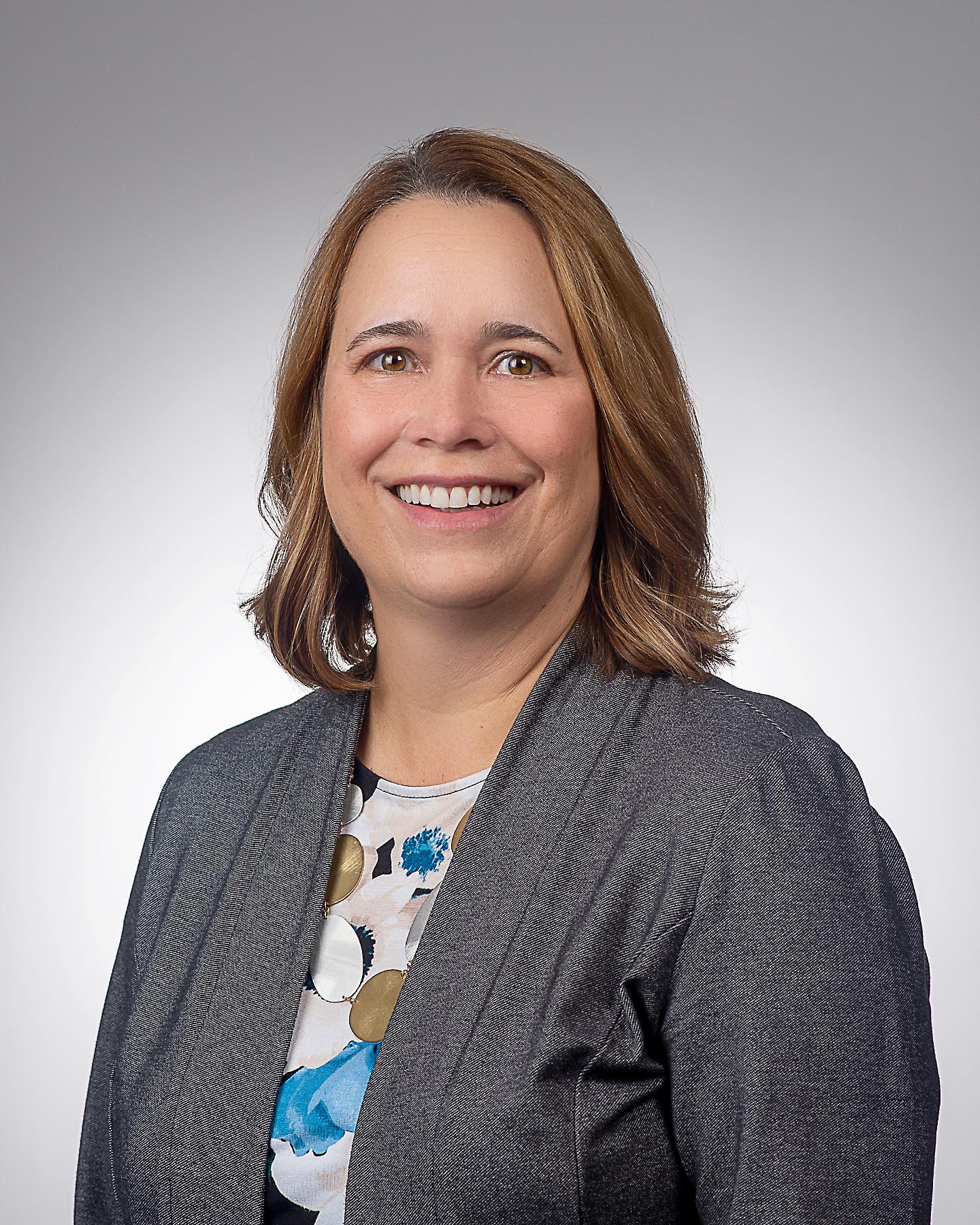
F
or most of her life, Anne Robertucci’s road led toward a career in healthcare. But while a calling to help others mobilized her, she knew that she lacked the stamina to deal with the direct patient care aspect. Fortunately, the role of a close family friend within the health information systems industry presented a different possibility—one that intrigued Robertucci and inspired her to join the healthcare field using her strongest skill set.
After earning both her bachelor’s and master’s degrees in health information systems from the University of Pittsburgh, the Panther alum went on to spend nearly twenty years at the University of Pittsburgh Medical Center, then five at Optum, before taking a position at Prisma Health in March 2021.
Today, as the vice president of clinical revenue cycle at Prisma Health, she drives initiatives to ensure the quality of care is reflected appropriately in the claims submitted to the payer. It is critical that the codified claim represents the clinical story of just how sick the patients are, and that Prisma is reimbursed properly for the great care provided.
“It’s about making sure we are being innovative and forward-thinking in all of the work we do, with the goal of driving down the administrative costs in our work,” Robertucci shares. “I feel in today’s world, you can’t do things the way you’ve always done them, so we need to look at how we are using technology to drive change and improve efficiency.”
“I feel in today’s world, you can’t do things the way you’ve always done them, so we need to look at how we are using technology to drive change and improve efficiency.”
For instance, Robertucci proved instrumental in creating an outpatient ambulatory clinical documentation improvement (CDI) program, focusing on hierarchical condition categories capture improvements. With the continued centers for Medicare/Medicaid services movement from fee-for-service payments to fee-for-value, she says, it should be on every healthcare organization’s key priority list.
“We created this ambulatory CDI approach to ensure our patients’ risk adjustment factor scores [h]ave all of their chronic conditions accounted for,” she offers. “From a managed care perspective, that’s really how you are reimbursed.” Using strong technology to support the team and reduce inefficiencies in the process remains key to their program.
Another initiative she’s excited about is Prisma Health’s work around CDI and coding in the acute care space.
“We’re making sure we are reviewing cases appropriately, that we are aligning with the providers concurrently with our clinical documentation integrity process, and that we are looking at the right case at the right time,” Robertucci says. “That ties back to the work and innovation I drove on the vendor side.”
Established over a decade ago, Brundage Group supports the team with end-toend CDI and revenue cycle solutions, helping improve documentation accuracy and optimize revenue cycles.
Having experience on both the health relationship management and vendor sides allows Robertucci to establish a fair and balanced approach to her current job.
“When I worked on the provider side, I really focused on the goals and tasks at hand, and you’re so focused on your organization and how you do things that you don’t have time to gain external insight. And while we were very innovative at UPMC, moving to the vendor side really allowed me to engage with other innovative and strong healthcare organizations to see what their best practice was,” Robertucci recalls. “This helped me expand my professional horizons and gain an entire tool kit of new best practices to drive improvements.”
As a result, the VP implemented some additional key, innovative processes at Prisma Health she expects will help move the needle further.
“In the past, coding and CDI were very financially focused,” she notes. “Over time, and in more recent times, the focus is on bringing the impact of quality metrics and outcome discussion into this space.”
Technology, she says, makes the job easier, and people shouldn’t be afraid to embrace it and take advantage of all it can do to improve quality outcomes.
“How we look at the consumer’s (patient’s) publicly available data, a lot of those metrics are based on what’s

Prisma Health leverages
CDI and coding sta ing solutions from Brundage Group, supported by the industry’s leading physician advisors, to achieve documentation excellence and coding accuracy.

Revenue Cycle Analytics
brundagegroup.com/sta ing
submitted on the claim—the diagnoses codes and procedure codes—and if you’re not ensuring comprehensive code capture, it has a major impact on how you look from an overall quality perspective,” Robertucci explains. “Coding and coded data have a halo effect on patient quality outcomes. It can impact your expected length of stay, reimbursement levels, and overall severity of illness. If you’re not accurately capturing the story on the claim, you’re not going to be reimbursed appropriately and portrayed appropriately in the public eye.”
With costs rising in every aspect of care, Robertucci emphasizes the importance of determining different ways the company can support its operations in a more efficient and cost-effective way.
Thanks to her five direct reports, Robertucci has moved things towards a more service line management structure.
Robertucci relays a story about caring for her father, who had terminal pancreatic cancer: she helped him go through the entire process and watched the different disciplines of the healthcare engine work as he went through chemo and dealt with extreme health circumstances.
This not only allowed her to take a step back and realize what is important from a life perspective but also gave her the opportunity to see every aspect of the healthcare continuum from start to finish. She saw what works well, what does not, and how to incorporate that insight into her own piece of the healthcare puzzle and drive change in her work.
“My father’s healthcare experience helped me learn how to balance work and life,” she explains. “Similar to how we, in the clinical revenue cycle, have to balance the work we do from both a financial and quality perspective.”
Robertucci is thankful for the career path she has taken and how these experiences have opened the door to so many different opportunities. AHL
Brundage Group is proud to partner with Prisma Health to provide revenue cycle staffing solutions for efficient, higher-quality care. Our CDI nurses deliver documentation excellence and coding accuracy. And with our suite of physician advisory services, hospitals can optimize the revenue cycle, driven by documentation integrity. Get quality talent and proven results: brundagegroup.com.
“Coding and coded data have a halo effect on patient quality outcomes. It can impact your expected length of stay, reimbursement levels, and overall severity of illness.”
Some executives feel the importance of their work because they have experienced its impact firsthand. Shaped by their mission to help others or by their personal experiences with healthcare, many executives are drawn to the industry from a sense of empathy and a desire to make a difference for others.
108. Joseph Mack Bayer
112.
116.
120.
124.
128.
Jennifer Prentice Clarivate Analytics Curtis Cummings Prestige Consumer Healthcare Ann Sparkman UC San Francisco Monica Williams Baylor Colleg e of MedicineJoseph Mack overcame the obstacle of transitioning in-house to thrive at Bayer
By Natalie Kochanov Joseph Mack
Joseph Mack
As a federal prosecutor at the US Attorney’s Office for the District of New Jersey (USAO), Joseph Mack faced criminals of all types. However, when transitioning in-house to work for Bayer, he faced an entirely different kind of challenge.
“I don’t know if it was a learning curve or a learning cliff,” Mack jokes. “It was that steep.”
Over five years later, Mack certainly found his footing. He advises internal stakeholders from Bayer’s pharmaceuticals, crop science, and consumer health businesses on a wide variety of legal and compliance matters. The lawyer credits his success to leveraging his crucial internal relationships and employing his previous legal expertise.
Mack started his career at the esteemed international law firm White & Case, advising clients in corporate defense matters. “I also did a lot of pro bono work for indigent defendants, whom we were appointed to represent through the Criminal Justice Act [CJA],” he explains. “That was my first true exposure to what federal criminal practice was like.”
Working on the CJA panel sparked Mack’s interest in the other side of the courtroom. After five years at White & Case and then Linklaters, he landed a position with the USAO and spent the next decade as a federal prosecutor.
“It was an awesome responsibility to work with agents and paralegals to help build a case and use prosecutorial discretion to achieve justice,” he says. “I got the opportunity to represent the United States as a trial attorney—and that was my dream in law school.”
During that time, Mack gravitated toward healthcare. As a member of the
healthcare fraud unit, he prosecuted individuals and corporations for not only healthcare fraud, but also violations of the Anti-Kickback Statute and the Federal Food, Drug, and Cosmetic Act. Beyond developing an industry specialization, he helped shape the future of the USAO by supervising its newest prosecutors.
Additionally, Mack supervised more seasoned prosecutors in the healthcare fraud unit and helped run the law intern program. All of these experiences provided him perspective on the future.
“When thinking about transitioning from the USAO, I looked inward and asked myself what I really liked doing,” Mack says. “I realized I enjoyed counseling: providing advice, identifying risks, and problem solving.”
Inspired by his interactions with a corporate monitor team, Mack landed on compliance. His healthcare background made him the perfect fit for an opening at Bayer, and the rest is history.
“I took a bit of a gamble switching to in-house because I got out of my comfort zone. I was a litigator for fifteen years, and now I try to build relationships and provide counsel in a totally new environment,” Mack says. “Every day I draw on my prior experiences to help my internal clients navigate their work in highly regulated industries subject to intense enforcement oversight.”
While getting acclimated to Bayer, Mack took concrete steps to become a real partner to his business colleagues. “There used to be these imagined barriers
“If you can balance your outside interests with having a fulfilling job and spending time with your family and friends, that gives you some measure of success,” Joseph Mack says.
A lifelong basketball fan, Mack draws on a hoops analogy when asked to describe failure. “John Wooden said, ‘Failing to prepare is preparing to fail,’” Mack says. “When it comes to facing challenges, if you don’t put in the necessary effort to prepare, you’ve failed, no matter what it is you’re trying to do.”
between compliance and the businesses, but we’ve broken them down in the past several years,” he says. “In a compliance role, those relationships are integral to our success.”
Mack explains it’s important to him to get to know his internal clients in different settings, including on the basketball court. “We have regular basketball games in our gym at Bayer,” he explains. “Connecting with colleagues in the gym helps build trust and a bridge to partnership when we are back at our desks.”
To foster relationships internally, Mack and his compliance colleagues hold regular meetings with various stakeholders. “I always try to explain the ‘why’ behind my reasoning,” he adds. “I learned early on in the transition in-house it’s not enough just to give people the policy. You have to explain to them why the policy exists, and what it means for them.”
Another trust-building strategy he uses with internal clients simply involves having a conversation—and not over email. “You have to listen first,” he emphasizes. “Many times, a problem could be the result of a misinterpretation of previous guidance.”
Mack also relies on external relationships, especially regarding complex internal investigations. “We pride ourselves on handling investigations ourselves. But in certain resourceintensive cases, we hire outside counsel, often using a former colleague from my USAO days, Scott McBride of Lowenstein Sandler,” he says.
Whether leading an investigation, responding to a government inquiry, or counseling on fraud, risk, or abuse matters, Mack knows a good day’s work. “If Bayer colleagues feel they can come to me with something confidential or seek me out because they trust my judgment,” he says, “then I’ve done my job.” AHL
Lowenstein Sandler applauds JOSEPH
Senior Assistant General Counsel, Compliance and Investigations at Bayer Corporation

We salute this well-deserved recognition of Joe’s experience, knowledge, and leadership.
Our firm is honored to represent Bayer Corporation as one of its trusted counsel.
“If Bayer colleagues feel that they can come to me with something confidential or seek me out because they trust my judgment, then I’ve done my job.”
Today’s employees have new needs as they face new challenges. Jennifer Prentice of Clarivate strongly believes that in light of these realities, well-being is the future.
By Zach Baliva Jennifer Prentice Director of Global Benefits Clarivate Analytics
Jennifer Prentice Director of Global Benefits Clarivate Analytics
Jennifer Prentice initially joined Clarivate as a benefits manager to optimize and improve its health and retirement programs for thousands of professionals around the globe. It was 2017, and Prentice was eyeing a position from which she would have an even greater opportunity to create and implement platforms that truly impact employees and their families.
The veteran HR leader ultimately became the company’s director of global benefits. As she researched emerging trends and key components employees expect in modern benefits programs, one thing rose to the top, and that item quickly became Prentice’s primary focus—well-being.
For Prentice and Clarivate, addressing emotional and mental health needs is an imperative. “Well-being is the future of benefits,” she says. “It’s something many people asked me for on a regular basis. If you’re paying attention in the benefits world, you are moving into this space.”
Many factors paved the way. Employees at Clarivate and elsewhere have all experienced changing political cycles, the murder of George Floyd, school shootings, a global pandemic, remote work, inflation, social unrest, climate change, war in Europe, burnout, and other acute stressors. Prentice says those who provide well-being benefits differentiate themselves as employers by helping their employees feel “seen, heard, and taken care of.”
Clarivate’s eleven thousand global employees help more than forty-five thousand customers accelerate their business innovations. The publicly traded analytics company, which owns Ex Libris, ProQuest, and others, offers subscription services for biopharma, medtech, healthcare, intellectual property, and other research areas. Clarivate makes it easier for its clients in these industries to identify, market, and monetize novel inventions.
Before formalizing robust well-being offerings, Clarivate, which operates in more than forty countries, already had several solutions in different parts of the world. Prentice saw an opportunity to do more. “I wanted to bring everyone together and make sure all of our many employees had access to the same benefits because that really builds corporate culture,” she says.
“I saw that deeply understanding people and addressing their needs and wants is of critical importance, and I saw the positive change the services we provide can bring them.”
That drive compelled Prentice and her colleagues to find a strong partner to launch the program. Clarivate worked with Virgin Pulse to establish a global well-being platform and partnered with internal colleagues on a communications plan to increase employee awareness and engagement. A clear vision, internal support, and the right external partner enabled everyone involved to move quickly. Clarivate Analytics announced the program in the US and introduced it to all employees worldwide just six weeks later.
While these solutions were created to make a difference, Prentice decided to take things one step further. She opted to add a Whil plug-in (now RethinkCare) to the Virgin Pulse. RethinkCare offers podcasts, webinars, and mini courses on popular and relevant topics like resilience, anxiety, insomnia, mindfulness, and relationships.
These important steps complement what Clarivate already was doing to support employees through the ongoing COVID-19 disruption. In 2020, the company started to host weekly live Q&A sessions with its CEO and other top leaders. It also recommitted to its existing global employee assistance program, expanded child and elder care benefits, allowed rollovers and midyear election changes to pretax spending accounts in the US, increased paid time off, changed its 401(k) program, and began a financial hardship assistance program that ultimately brought $2.78 million in assistance to employees and their families.
In leading global benefits, Prentice works with a diverse team of five professionals who help shape programs and create culture at the large company. A unique background helps her thrive in the role. Although she’s originally from the Jersey Shore, her father’s job with the US Department of State took Prentice to places like Liberia, Kenya, Cyprus, France, Egypt, and Yemen.
Overcoming culture shock and learning to adapt to new cultures helped her become a tolerant, wellrounded person who looks for and appreciates different perspectives and points of view. Those traits have helped her in the global roles she’s held throughout her career.
John Zutter, CEO of Employer Direct Healthcare, says, “Jennifer’s dedication to driving positive change
for Clarivate, and her compassion for the well-being of others, make her an impactful leader and partner. As one of her partners, we know firsthand how committed she is to continued improvement and tangible, meaningful results.”
Prentice also studied international affairs at Northeastern University. She began her career as a temporary worker at the front desk for a partial hospitalization program at Hartford Hospital. Although initially a short-term job, she ended up staying with the organization for twenty years.
At first, the young Prentice didn’t even realize she was working at a mental health facility. “I thought it was a school,” she explains.
But once she realized what her colleagues did—particularly their service and dedication to vulnerable populations—she was hooked. Prentice spent the last half of her tenure with Hartford Hospital in their clinical psychology department, where she developed bereavement materials and coordinated patient-facing programs. In doing so, Prentice discovered a passion that still guides her work with Clarivate today.
“I saw that deeply understanding people and addressing their needs and wants is of critical importance, and I saw the positive change the services we provide can bring them,” she adds.
While Prentice and her team carry these efforts forth, they’re starting to see tangible results. Comprehensive wellness platforms are known to increase productivity, decrease absenteeism, attract talent, and create a healthier and happier workforce. Clarivate plans to build on this foundation, and Prentice hopes to add financial well-being tools and other holistic features in the coming months and years. AHL
In 2019, Jennifer Prentice, director of global benefits at Clarivate, began searching for a solution that would increase the value of their benefit offerings, especially related to access and affordability of care. Their search led them to SurgeryPlus™, a solution focused on transforming access to specialty care and the market leader in the Center of Excellence space. We look forward to our continued partnership with Jennifer and Clarivate.
Curtis Cummings was in high school when Radio Shack’s TRS-80 personal computer came out. Boasting up to 48 kilobytes of RAM and a 1.774 MHz processor, it foreshadowed tremendous changes across the economy—and in his career path.
Cummings’s journey started at Eastern Washington University, where he majored in computer science. “I took Pascal, FORTRAN, all the early languages, and I was just a horrible programmer,” he says, laughing. “But I still loved computers, so I transitioned
into more of an IT [information technology] function.”
He spent his early years crisscrossing Idaho and eastern Washington building network infrastructure. Afterwards, Cummings spent almost two decades designing, building, and operating Microsoft’s global infrastructure and cybersecurity. Today, he serves as senior vice president, chief information officer (CIO), and chief information security officer (CISO) at Prestige Care.
The Washington-based organization operates thirty-three skilled nursing
facilities and forty-four assisted living facilities, which also house operations for twenty memory care facilities and nine independent living facilities across eight states. Prestige emerged from Sarah Delamarter’s work caring for local seniors in Troutdale, Oregon, in 1946. Over the years, she acquired buildings and developed the organization that became Prestige Care in 1985. Today, two of the three owners are Delamarter’s grandchildren.
Cummings found his knowledge and experience could make a major positive
impact in the sector. “If you can translate what caregivers are doing into technology speak and vice versa, you can provide the much-needed solutions they are looking for,” he says. “Because the senior living space is underinvested in, poor technical solutions are typical. Prestige Care leadership is committed to modernization and finding the best possible solutions, not just for Prestige Care but for the industry as a whole.”
As CIO and CISO at Prestige Care, his primary role is to translate and synthesize health, tech, and business needs.
The main point, the CIO says, is to recognize that tech tools are not one-step solutions. “The challenge is addressing the ecosystem of care and properly translating what caregivers are asking for. If IT misunderstands caregiver requests or deliver the wrong solutions, technology becomes an inhibitor versus an enabler. People think technology will solve their problems, but technology is more of an efficiency tool for a functional workflow,” he explains. “If you’re applying a poor workflow to a new tool, the tool can make the workflow even worse.”
Done carelessly, tech “improvements” can push valuable workers out of the organization. Instead of easing their workload, employees feel unheard, grow frustrated, and depart. But through active listening, collaboration, and patience, Cummings and his department are seeing greater results, driving efficiency and innovation.
“IT can have a huge impact on labor and retention, either positive or negative,” Cummings says. “The way the labor market is today, if people don’t understand your new workflow and why, they go to another company that does things the way they’re used to. Make your transitions logical and show people how it helps them take care of patients better.” Turnover has complicated the industry, but IT at Prestige Care looks to position the company as a destination company for caregivers.
Since this sector is tightly regulated and small efficiencies are critical to the margins, Cummings often finds ways to drive value for the business, while eliminating pain points for care providers. Still, his work is to drive change—often a major challenge.
The IT team also oversees the integration of health data to support care providers and patients. They’re actively creating automation and analytics for senior living health information and business metrics, with several custom applications available to Prestige caregivers already.
“The challenge is addressing the ecosystem of care and properly translating what caregivers are asking for. . . . People think technology will solve their problems, but technology is more of an efficiency tool for a functional workflow.”
 Curtis Cummings SVP, CIO, and CISO Prestige Consumer Healthcare
Curtis Cummings SVP, CIO, and CISO Prestige Consumer Healthcare
In senior living, for example, diabetes is a major problem and caused by intersecting factors—stress, lifestyle, and genetics. This makes it challenging to address individual cases and disentangle causes and effects. Eventually, when care providers can integrate that data and present treatment options in more specific context, individuals will have more power and better outcomes.
“Part of my job as an informaticist is getting medical information to patients in a way they understand, accept, and can act on,” Cummings says. “We, as an industry, continue to be challenged getting information to people in a meaningful way. As we improve this, it’s going to have a tremendous impact on care, and how we age and care for ourselves.”
Away from the company, the CIO devotes time and financial support to community projects in Kenya via Rotary International. Using his background in construction, he started building water wells, then sanitation infrastructure and schools. One year, after helping to build two thousand desks for twenty primary schools, he agreed to build fifty small ones for a kindergarten.
“We took these fifty small desks to deliver them, and there was no school— it was the kindergarten under a tree,” he recalls. They built a four-classroom building on-site, and by Cummings’s next visit the following year, the government had added another building. Together, they provided water, bathrooms, and a library, turning the fifty-student kindergarten under the tree into a four hundred-child primary school bearing Cummings’s name.
Now, he’s funding his first scholarship program. “I just agreed to that last summer,” he says, “because the first child from that kindergarten got accepted into university. And that’s pretty cool.” AHL

Bigleaf Networks delivers truly reliable connectivity, so all your mission-critical cloud technologies perform optimally, without delay or downtime. Bigleaf’s siteto-cloud connectivity platform is built on AI-powered SD-WAN and point-of-presence architecture designed to deliver high-quality, highly available, and resilient connections over any ISP that today’s organizations need to enable and protect their increasingly SaaS-based operations.

“The way the labor market is today, if people don’t understand your new workflow and why, they go to another company that does things the way they’re used to.”
Ann Sparkman reflects on an exciting and rewarding legal career, including the last sixteen years at University of California, San Francisco (UCSF) By
Billy Yost
It all started in southeastern Kentucky. Ann Sparkman—the retiring chief medical center counsel and deputy campus counsel for health affairs at the University of California, San Francisco (UCSF), some 2,384 miles away from her hometown of Lexington, Kentucky—says her journey in healthcare dates back to her grandmother, a midwife in rural Appalachia. She would venture from home to home by horse, delivering babies of the mountainous area’s residents.
“I remember asking my grandmother how she was paid for her services during the Great Depression,” Sparkman recalls. (“In the form of poultry, produce, or promises,” her grandmother, Grace Sparkman, told her.) “She just made it work. That kind of mentality and dedication was my introduction to medicine, and it has really stayed with me.”
Now a retiring attorney, Sparkman initially thought nursing was her calling. While working as an infection control nurse, Sparkman attended law school at night and came out on the other side as a full-fledged nurse attorney. While it was decades ago, her time as a frontline worker provided countless opportunities for insight into the field many other healthcare lawyers simply haven’t had.
Sparkman worked as an infection control nurse at Kaiser Oakland during the AIDS crisis of the 1980s, a time when no one really knew what the virus was, let alone how to treat it. San Francisco, a city with a thriving gay community, was decimated by the epidemic. Sparkman never thought she’d see anything like it again in history. Then 2020 arrived.
“COVID-19 seemed to bring my career full circle,” says Sparkman, who spoke to AHL in summer 2022. “It was another situation where we didn’t know what it was or how to treat it, and you saw the community pulling together. In my case, it involved helping organizations solve complex healthcare law issues and finding ways to help enable our physicians and frontline workers to keep them safe and do their best work. I have such enormous respect for our physicians and, especially, our nurses.”
Two epidemics may seem difficult to tolerate as bookends to a career, but Sparkman’s own evolution in the healthcare law space in the interim has impacted UCSF for the better part of sixteen years. The lawyer helped the public academic research and medical center compete with its privately funded counterparts at a truly elite level.
Sparkman reflects on the enormous growth that occurred since 2014, when UCSF began expanding as a health system, looping in affiliates, such as
“In one way or another, I think I’ll always maintain a connection to this remarkable institution and people. I think its best years are still ahead of it.”
UCSF Benioff Children’s Hospital in Oakland, California, and MarinHealth. The extended network improved patient care by allowing local residents to see UCSF physicians for specialty care in their own community.
“Our expansion has improved access and quality in patient care,” she says. “There are complex regulatory and legal issues to enable these transactions, but it’s incredibly fulfilling to know that I’m able to help people from my position.”
Additionally, Sparkman, an elected member of the Marin Healthcare District Board, served as chair, vicechair, and secretary, as well as chair of the Lease and Building Committee.
The Marin Healthcare District (MHD) owns MarinHealth Medical Center (formerly known as Marin General Hospital). MHD provides oversight of significant hospital transactions, hospital board appointments, and the hospital’s performance goals, while advocating for high-quality hospital care and addressing community healthcare issues.
In her final year, Sparkman mentored health sciences counsel Alexander Peña to prepare him for elevated responsibilities and share her wisdom. She spoke so glowingly of him, that when Peña called her during her interview, she conferenced him in.
“I’ve been under Ann’s leadership for the last year, but you have to understand she was the inspiration for my coming here in the first place,” Peña says. “I had had such strong mentorship in my previous role, and I was hesitant anyone else could fill that void. But in one conversation, I recognized Ann as a seasoned
healthcare attorney [who is] as passionate about healthcare as I am. You just don’t see it very often, and it made me want to join the organization.”
“That’s kind of you to say, but you know I feel the same way, Alexander,” Sparkman replies. “I can’t say enough good things about Alex. He’s great with our clients and has an incredible career ahead of him.”
It’s a bittersweet time. The lawyer will miss her daily interactions. Whether aiding physician betterment through UCSF Medical Center Medical Staff’s Wellbeing committee; participating in Medical Staff investigations; assisting with California Department of Public Health (CDPH), CMS, and pharmacy surveys; or just the day-to-day multitude of healthcare law issues.
However, she’s looking forward to joining the UC Master Gardener program in retirement, continuing her Marin Healthcare District Board work, and devoting time to animal rescue. “I’m so grateful for the opportunity to be part of UCSF,” Sparkman says. “In one way or another, I think I’ll always maintain a connection to this remarkable institution and people. I think its best years are still ahead of it.” AHL
Since 1987, Hooper, Lundy & Bookman’s primary focus has been to guide and support healthcare providers and suppliers in our shared mission to create and maintain a viable and effective healthcare system. With clients in all fifty states, we meet the legal and government relations needs of healthcare providers across the country.

www.health-law.com




























































Hooper, Lundy & Bookman is the largest law firm in the country dedicated exclusively to representing health care providers and suppliers.
Health law from every angle
Hooper, Lundy & Bookman proudly supports UC San Francisco and congratulates Ann Sparkman on her recognition in American Healthcare Leader
Monica Williams rose from a front desk position to benefits leadership at the Baylor College of Medicine
By Billy YostMonica Williams started at the Baylor College of Medicine in 2006 behind the front desk as a benefits service representative. Frankly, after Baylor’s initial contact, she didn’t really have a clear idea about what the position entailed—and she still didn’t quite understand when she accepted the role. She just had to be anywhere else but her current job.
Though not necessarily bad, Williams’s initial human resources experience didn’t feel like a fit. Knowing she belonged elsewhere, she tried her hand building out early HR experiences in other ways, first for the City of Houston, and later (and rather unfortunately) for an Enron subsidiary that folded because of the scandal.
(Williams remembers the nonstop ringing of office phones, her colleagues turned away, jobs gone in an instant.) Her company would be sold off, and circumstances worsened as time continued.
So, when Baylor called, the conversation was simple. “I had no idea what position I had applied for, but I just said yes,” she says, laughing.
Nearly sixteen years, a completed degree, and four promotions later, the executive director of benefits at the Baylor College of Medicine thinks back to the impact that first position had on her journey—not just as a benefits representative but also in her development as a compassionate leader and mentor.
“I think a lot of people take the front desk job for granted,” Williams says.
“They think it’s about just meeting and greeting people, but it’s not the case. That’s the place where I learned more about people and benefits than you could ever imagine. Each individual that comes through that door has a different
situation, a different need, and a different explanation. Along with the mentors in my life, that front desk role was everything for me.”
Williams’s gratitude for her mentors and her time at Baylor encourages you to root for her instinctively as she continues in her most recent promotion. Admittedly, the role change propelled her forward significantly, and slightly out of her comfort zone. She succeeds by staying centered on her central mission of appreciation. That, and focusing on passing along her experiences, wisdom, and guidance to her fourteen-person team and the thousands she helps every day.
Baylor prides itself in caring for employees—the organization was presented
“I’ll put everything I have into this team, because it’s what others did for me.”

with the 2019 Healthiest Employer Award by the Houston Business Journal —and the benefits team continues in that mission every day. They recently assembled a Baylor Custom Network as a joint venture with CHI St. Luke’s Health system. The network (inside of Baylor’s current carrier network) provides employees the lowest out-of-pocket cost possible and two distinct options for care through the Baylor College of Medicine and CHI St. Luke’s healthcare systems. The current carrier plugs gaps in existing coverage.
“I think it’s the perfect amount of choice, because if you give people too many options, their eyes just sort of glaze over, and it’s easy to get confused very quickly,” Williams explains. “But this is a custom network that is here for you if you need it. I think it’s an amazing option for our population.”
During the pandemic, the benefits team worked with its carriers and wellness program to ensure ready access to mental health resources for those suffering due to lockdown strain. Along with newsletters, media screens, posters, and any opportunity to get resources in front of people’s eyes, the team worked hard to make sure that access to those resources was just a simple click away.
“We wanted to ensure not one person had to jump through any hoops to get the help they needed,” Williams adds. “If you were feeling down or burnt out or worn out, we wanted everyone to know that there was always help ready and available.”
The Future and the Past Looking ahead, Williams plans to make the enrollment system more user friendly and accommodating to the company’s population. She’s also examining how to evolve Baylor’s prescription plans, especially as it relates to nonadherence in its largest three categories: diabetes, hypertension, and cholesterol.
“When these groups become nonadherent to the prescription plan provided by their doctors, they ultimately become our cardiovascular patients,” Williams explains. Tackling that became part of her to-do list in summer 2022.
Several more projects wait in the wings, but it would be a disservice not to point out the value the leader places in mentorship. Invaluable to Williams, she knows how much it can benefit others.
“My definition of mentorship is different than most, I think,” the director says. “To me, it’s providing everyone around you with more skill sets than they think they need to make themselves marketable, even if it’s to your own detriment, meaning I lose them.”
Williams says mentors built her, shaped her, even gave her informal advice about dress and approach when arriving in the corporate world. Never could the executive director have dreamed of stepping into such a role, and she has many supporters to thank.
“I have people reporting to me now, and I want to make sure that they rise right along with me,” Williams says. “I’ll put everything I have into this team, because it’s what others did for me.” AHL
Inspired by the example set by her mother, Aileen McGill Fair works to advance the Bristol Myers Squibb mission of delivering transformative care
 By Zachary Brown
By Zachary Brown

Aileen McGill Fair knew she would be busy after receiving an offer to join the law department at a leading pharmaceutical company. However, she had no idea just how much work she would undertake on such a large scale in her first year alone. After eight years at a New York law firm, she joined Bristol Myers Squibb (BMS) in December of 2018. Two weeks later, BMS announced its plans to acquire Celgene Corporation in a transaction valued at $74 billion.
Leaders at BMS targeted Celgene to solidify the company’s standing as a leading biopharma company, creating innovative therapies in oncology, hematology, immunology, and heart disease. But like any deal this size, the transaction required extensive antitrust approval.
BMS General Counsel Sandra Leung tapped Fair to serve as her point person for the Federal Trade Commission’s antitrust review of the merger and lead efforts to provide materials to antitrust authorities worldwide. Fair got to work immediately. “It was critical for our law department to provide the support necessary to close the BMS/Celgene merger with full regulatory approval, and I was honored to have a role in making that happen,” she says.
During this busy first year, Fair worked on several other litigation matters and government investigations, which continue today, as she teams with a dedicated and tight-knit litigation cadre managing the company’s most important cases.
Fair’s work often requires long hours and extensive research that enable her to make thoughtful, deliberate
decisions. At these times, she draws inspiration from her mother, Dr. Janet McGill. After Fair’s father, also a physician, died during her youth, her mother and two older siblings moved to St. Louis. There, her mother started a fellowship at Washington University, and currently serves as a professor of medicine in the Washington University School of Medicine and is a world-renowned endocrinologist.
Her mother’s ability to overcome hardship and dedication to her patients and profession had a significant impact on Fair. She remembers her mother spending evenings reading medical journals, editing study protocols, or on the phone helping patients manage their diabetes.
“When I was young, I didn’t understand why my mom did as much as she did for her patients, but over time, we often ran into my mom’s patients or colleagues in town, and I heard firsthand how my mom’s dedication had affected so many people in our community,” Fair says. “Patients told me, ‘Your mom diagnosed a condition that four other doctors missed, and it saved my life.’ And junior faculty members would tell me how my mom had supported them early in their careers. It made me realize that the extra effort to help patients and colleagues matters, and that that was exactly the kind of person I wanted to be.”
Fair followed her mother by studying at Washington University, before attending the University of Pennsylvania Law School. She then joined Patterson Belknap Webb & Tyler, LLP, as an associate. The combination of the firm’s reputation in healthcare, as well
as the chance to get direct, hands-on experience really inspired the young lawyer. Early in her career, partners trusted her to give opinions regarding important matters. “During Aileen’s time at the firm, she worked very effectively and efficiently to find solutions for clients, laser-focused on the business needs of our clients and how our litigation strategy would help to achieve them,” says Lisa E. Cleary, cochair and managing partner at the firm.
“As a junior associate, I wasn’t the most experienced attorney on the team, but I always researched my cases extensively, and that input often helped guide the team to develop better strategies,” she says. That experience, and many others, reinforced her belief in the importance of both hard work and diversity in securing the best outcomes. “When we hear every voice in the room, we make better decisions. Diversity of opinion and input from people of all backgrounds, levels, and areas of expertise is critical,” Fair adds.
It’s a philosophy she continues to promote in her current role as senior litigation and antitrust counsel at BMS, where, in addition to working in litigation and competition law, Fair supports a number of initiatives to support colleagues and law students. She serves as a leader of the law department’s early career program, which aims to recruit and support colleagues early in their careers; a member of the law department’s diversity and inclusion committee; and a leader of the department’s diversity and inclusion summer internship program.
“It was critical for our law department to provide the support necessary to close the BMS/Celgene merger with full regulatory approval, and I was honored to have a role in making that happen.”
Fair’s role gradually increased to include leadership on multiple committees and litigation, government investigations, and antitrust and competition law worldwide. At the same time, she continues to provide critical legal support to BMS, as the company takes new products through its pipeline to deliver medicines to patients around the world.

Fair’s colleagues at Arnold & Porter are impressed by her efforts. “Aileen is always a pleasureto work with, through intense and calm periods,through highs and lows. She is smart, thoughtful, collaborative, and simply a nice, caring person. I could not ask for a better in-house partner,” says Anand Agneshwar, partner at Arnold & Porter. Partner James L. Cooper agrees: “Aileen is a rising star in healthcare antitrust law. She uses her deep understanding of Bristol Myers’ business, and where the business is going, to
anticipate legal problems and opportunities well ahead of the curve.”
Industry insiders expect big things from BMS in 2023, with the company’s several highly anticipated drug launches in areas with significant unmet medical need. Additionally, the global biopharmaceutical company will continue its longstanding partnerships with universities and other businesses. These relationships bring innovative products to market faster, and Fair’s department helps move these collaborations forward.
Like her mother, Fair remains passionate about serving the mission of BMS, and its dedication to patients. “Like my mom and so many other healthcare providers,” Fair says, “I feel inspired to bring absolutely everything I can to my work, supporting the company, so that we can create the best outcomes for patients.” AHL Rob
WesterichCongratulations to our friend and client Aileen Fair for the well-deserved recognition from American Healthcare Leader for your exemplary leadership.
Arnold & Porter is proud of our longstanding partnership with you and with Bristol Myers Squibb.



Covington commends Aileen Fair of Bristol Myers Squibb for her innovative leadership and professional dedication.
Providing legal representation across a comprehensive range of practice areas that are critical to the success of our clients. wilmerhale.com Legal
 Attorney Advertising
The Reason 133
Attorney Advertising
The Reason 133

Healthcare is a constantly evolving industry that demands executives to plan ahead. Often, this means business leaders need to address department- or companywide issues to remain focused on driving innovation and devising strategies to maintain a high level of care.
136. Lorenzo Ball Ameritas 142. Ron Spielberger Personal Touch Home Care 148. Ekta Vyas Keck Medicine of University of Southern California 152. Krystle Ferbos Duplessi LCMC HealthAmeritas Vice President of Data Strategy and Analytics
Lorenzo Ball on the technological shifts facing all industries— and their implications for healthcare
By Zach Baliva Lorenzo Ball VP of Data Strategy & Analytics Ameritas
Lorenzo Ball VP of Data Strategy & Analytics Ameritas
Tune into a Friday Night Baseball broadcast on Apple TV+, and you’ll see the power of big data in the bottom right corner of the screen. Viewers can see live, probability-based forecasts about the hitter’s chance of reaching base or producing a run. The numbers fluctuate with every pitch. In the dugout, managers use a quantitative analysis methodology called Sabermetrics to compare player performance and guide in-game strategy.
The data revolution is here and is transforming every industry. Sports, banking, insurance, healthcare. At the end of the day, more and more organizations recognize not just the value, but the need of such informed insight.
Lorenzo Ball has twenty-five years of experience in technology management and analytics across a few different verticals, and over the past four years he has used his expertise to find new applications for data and analytics in the insurance and healthcare space. Currently, he serves as vice president of data strategy and analytics at Ameritas, a leading insurance, financial services, and employee benefits company.
Five Nebraska businessmen started the Old Line Bankers Life Insurance Company of Nebraska (which later became Ameritas) in 1887. The business still makes its home in Lincoln, and today serves more than 5.3 million customers nationwide. Ameritas may be most well known for its products in life insurance
and annuities, but the company has offered dental insurance since 1959.
Ball’s team of eighty people and six direct reports focus on increasing customer satisfaction, growing premiums, reducing financial risk, and driving outcomes. In his four-and-half years with the organization, the VP has introduced
a number of enabling services like a modern data environment to allow faster use of information, the use of artificial intelligence (AI) and computer vision to optimize dental claims, and the use of predictive modeling to improve treasury cash flow.
“What you can do with data to assist people in life decisions was fascinating.
A combination of historical information and advanced analysis has the power power to change businesses and transform lives.”
Expert and veteran leader Lorenzo Ball expounds upon the future of data and analytics in healthcare.
What are some emerging uses of data and technology you’re most excited about?
We’re starting to see more AI capabilities across the industry. The usage of smart devices is allowing unique ways to provide life and health services to individuals. These devices range all the way from smart watches to toothbrushes. In insurance, this new type of device—Internet of Things (IOT) devices—will give carriers the ability to offer preventative care opportunities for our participants. We want to be able to understand certain behavioral patterns to ultimately be a more efficient business and, as a result, lower the cost for health services.
Where can this go in the future? What are some possible applications?
Well, in dental, for example, I think of an app connected to your electronic toothbrush that can show brushing patterns and let the user know what spots they’ve missed. Carriers and health providers can offer preventative maintenance programs, which ultimately help avoid costly procedures. The ability to predict services will allow for improved cost for plans to an employer, and fewer claims and better out-ofpocket expenses to the plan participants.
What else is possible on the insurance side?
We can help speed up claims activities. Cost of services has always been a black box for healthcare. We want to use AI and data to better serve the customer and provide more clarity about costs, service coverage, payments options, and other factors.
This is a complicated space. What challenges are out there?
We’re always thinking about privacy and governance. We have to make sure we are collecting and using data in the right way— in other words, a way that is safely covered under all of HIPAA, FINRA, and other privacy regulations.
What’s possible five to ten years from now?
We’ll begin shift to a different data ownership model, allowing customers to manage their personal data and monitor everything in real time. This model will give customers the ability to see financial health and costs in a unified way, instead of the current fragmented experience. Consumers will better understand their networks and how doctors, dentists, and other providers really can work together to share data in a total and comprehensive way, for overall well-being.
Lastly, what will it take to get there?
Ameritas is going through the biggest tech transformation in the history of the organization, and data and analytics is a huge part of this. It will allow us to compete for the next ten to twenty years and beyond. But we can’t do it unless we continue to innovate and push to improve customer experiences. The use of data and analytics is not a tech activity; it’s a cultural activity. The entire organization must have a new mindset. It takes a new way of thinking to lead us into the future.
These accomplishments, together with other projects and initiatives, illustrate the importance of using emerging technology in every industry. “No company today can overlook artificial intelligence and an overall data and analytics strategy,” Ball says. “A new way of thinking is critical to driving business outcomes and decisions at every level.”



Ball studied at Morehouse College and the Wharton School before starting his career at aerospace and defense company Raytheon. In that era, he supported advanced simulations for the Global Patriot missile defense system and data and log management for Raytheon’s automatic analysis and assessment for advanced war game scenarios.
With the dotcom boom in full swing, Ball left Raytheon for a position with a consultant firm that had Bank of America as a client, where he built a wealth management app. The project sparked a passion in him. “When I started to use data to understand outcomes, I was hooked,” he says. “What you can do with data to assist people in life decisions was fascinating. A combination of historical information and advanced analysis has the power to change businesses and transform lives.”
From there, Ball continued in consulting, where he guided senior leaders at IBM and elsewhere through their analytics and data journey on critical projects. He helped Tiffany & Company remake their supply chain to reduce shipping costs, secured millions in new revenue for other clients, and showed HBO how to use data to understand viewer habits and preferences.
“We are extremely proud of our work with Lorenzo and the Ameritas team,” notes David Honour, risk modeling services partner at PricewaterhouseCoopers LLP. “Together, our partnership has
enabled us to collaborate and support Ameritas in leveraging data and in providing enhanced business insights to its users.”
Now at Ameritas, Ball leverages data and analytics to create new products, inform business strategy, and build a better user experience. “Life and health insurance services are a laggard in technology, but Ameritas is looking to introduce new tools to reach our full potential,” he says, adding that there is a lot his field can do to help Ameritas members, agents, and providers make data-driven healthcare decisions. AHL
“No company today can overlook artificial intelligence and an overall data and analytics strategy. A new way of thinking is critical to driving business outcomes and decisions at every level.”
In today’s complex world, healthcare companies must manage risk and chart a careful path forward. At Personal Touch Home Care, General Counsel Ron Spielberger leads the way.
By Zach BalivaR on Spielberger’s cell phone sounds a flurry of calls, messages, and alerts. He doesn’t mind. In fact, the general counsel at Personal Touch Home Care (PTHC) wears it as a badge of honor. “If your phone is quiet, you might think everything is great, but it probably means you’re about to get sued due to the legal department getting bypassed,” he says. By contrast, a lawyer with a busy phone and a full inbox is certain others at the company need and value their advice and input.
The trusted attorney spent the last three decades building his expertise and experience in home healthcare, medical device, health insurance, and related industries. Although he started his career with a mid-sized Park Avenue law firm, Spielberger quickly transitioned to in-house roles to get more involved in business strategy and find a better worklife balance. “Working as a corporate healthcare lawyer has helped me achieve many of my personal and professional
goals,” he says. Keri, Spielberger’s wife of twenty-seven years, gave up a retail career to raise the couple’s four children, and he’s been able to coach all in soccer, basketball, and lacrosse. “I coach with passion, in the same fashion as I bring my devotion to the workplace each and every day to help my clients navigate the obstacles they face in a heavily regulated healthcare industry,” he says.
After working for big pharma, a Fortune 500 medical device company,
managed care providers, physician practice groups, and others, Spielberger opened his own practice in 2016. The Law Firm of Ronald J. Spielberger negotiated healthcare industry commercial agreements and provided legal advice regarding employment law matters and compliance issues.
In 2019, after serving as a temporary general counsel, Spielberger joined PTHC full time to manage all legal affairs for the privately held home care company. This included joining the effort to oversee the legal needs of the company’s long-term care insurance plan Integra Managed Care, which has provided Spielberger the opportunity to use all his previously developed skills. He works alongside the CEO, CFO, and COO and leads two paralegals. Together, they review and negotiate contracts, handle corporate governance issues, manage litigation, run the company risk and insurance programs, and render employment law advice for a company with home care operations in five states, five thousand home health aides, and seven thousand total employees.

The nature of the business requires the team to prioritize and multitask. “Legal has to be both responsive and business friendly,” Spielberger says. “We need to understand business goals and help internal clients get where they need to go in a legal and compliant manner.”
One of the lean legal department’s most important jobs is working with IT and others to mitigate risks and vulnerabilities related to cybersecurity and patient data. In November 2019, PTHC experienced the first of two security breaches. The event occurred through a third party that managed company
Ron Spielberger General Counsel Personal Touch Home Careservers. Then, in 2021, the organization took a ransomware hit.
As his IT colleagues worked to recover data and get systems back online, Spielberger and the incident response team worked to notify the 750,000 patients, employees, and ex-employees whose data may have been compromised. Now, he’s helping leaders respond to government inquiries and managing related lawsuits.
In an era where all healthcare companies are vulnerable to cyberthreat actors, communication, integrity, transparency, and collaboration are key. As general counsel, Spielberger implemented a process with IT to ensure the completion of a security risk assessment for all vendors and partners, minimizing future breach risks.
The IT department also has taken several steps in response. They installed CrowdStrike endpoint detection and response software with 24/7 monitoring, upgraded antivirus systems to include AI learning, implemented multifactor authentication, and rolled out mobile device management and password management systems upgrades.
“As outside legal counsel to Personal Touch for many years, I’ve enjoyed working with Ron in a variety of contexts,” says Gregory R. Begg, partner and cochair, Labor Relations & Employment Law of Peckar & Abramson PC. “It is clear that Ron is highly skilled at anticipating risks and at crafting efficient, practical solutions to often complex challenges involving corporate transactions, litigation, labor relations, compliance, and other matters concerning his organization.”
“The pandemic revealed the need for better care solutions, and we are in the right place to do what we can to meet that need.”













Ruskin Moscou Faltischek is the premier business law firm in the New York region, with more than 65 attorneys, superior knowledge of the law, polished business acumen and proven credentials. The strength of RMF’s resources has earned us a sterling reputation: we don’t just solve problems, we create opportunities.

Corporate & Securities | Health Law
Commercial Litigation | Real Estate

Commercial Lending
Corporate Restructuring & Bankruptcy
Cybersecurity & Data Privacy
Employment | Cannabis Law
Trusts & Estates
Insurance protection also remains critical to the general counsel. Spielberger works with other executives and partners with a broker (the Signature B&B Companies) to ensure the organization possesses the right coverage for errors and omissions, professional liability, directors and officers, and cyber liability.
Over the last year, leaders at PTHC worked overtime to prepare for another major milestone—the sale of Integra Managed Care to Anthem. As part of the process, Spielberger and the deal team responded to more than 1,200 due diligence questions throughout the information exchange process. The deal closed on May 5, 2022.
At the same time, PTHC completed its own acquisition on the home care side of the business. The company bought Neighbors Home Care, a New Yorklicensed home care services agency in the Bronx—further bolstering PTHC as one of the state’s largest home care agencies.
Having worked with the general counsel, the team at Signature B&B says, “Ron’s deep understanding and knowledge of both insurance and law speak volumes. But it is his integrity, professionalism, and commitment to excellence that are key to the success of our relationship. Ron’s vision and passion for excellence allows our organizations to work together developing risk management solutions leading Personal Touch’s best-in-class practices.”
As consolidation in the home healthcare industry drives many old companies out of business, PTHC looks to leverage its strong infrastructure and operational support to fill the gap and capitalize on the opportunity. “The pandemic revealed the need for better care solutions, and we are in the right place to do what we can to meet that need,” Spielberger says.
Going forward, PTHC plans to pursue both organic growth and additional acquisitions. That means Spielberger should be busy—and he’s waiting by the phone. AHL
“Legal has to be both responsive and business friendly. We need to understand business goals and help internal clients get where they need to go in a legal and compliant manner.”


Chief Human Resources Officer Ekta Vyas is about more than tactical improvements—she partners with the very best medical centers and research facilities to build the future of healthcare
By Zach Baliva
Ekta Vyas isn’t working simply for the paycheck. Reminders of her higher purpose have surrounded the human resources veteran throughout career serving at academic medical centers and premium research universities, such as Stanford University Medical Center, University of California (UC) Davis Health, and now Keck Medicine of University of Southern California (USC). Her continued love of learning also sees her teaching MBA courses as an adjunct management faculty at San Jose State University’s (SJSU) College of Business.
Over her twenty-eight-year career, the thought leader developed immense passion for strong leadership and transformational change in healthcare. “HR can elevate a high-performing culture and facilitate empowering the workforce to meet serious organizational challenges,” she says. “HR has to do more than simply align to an organization. We have to be proactive enough to figure out the evolving nature of a progressively changing industry and position our organizations to meet the emerging needs of the future.”
Vyas believes leaders emotional intelligence (EI) determines an organization’s success, noting the significant challenge goes beyond intellectual capabilities. In her doctoral research, the scholar practitioner examined the effects of emotionally intelligent leaders on staff engagement during periods of dynamic transformational change. She found a focus on compassion and empathy—not just budgets and patient satisfaction scores—ultimately yields the best and most long-lasting results. The industry needs conscious change leaders capable of cocreating a new economy with their workforce, her doctoral dissertation asserted.
Before joining UC Davis Health as the organization’s deputy chief human resources officer (CHRO) in 2020, Vyas spent fourteen years in key roles at Stanford Healthcare and Stanford Children’s Health. She spearheaded a diversity, equity, and inclusion (DEI) program for Stanford Children’s, led lean process improvements, built a recruitment infrastructure, introduced workforce analytics, and managed a team that filled nearly
“We want our organizations to stay competitive and continue to do cutting-edge work and research as they deliver the best care. That means we need the best and the brightest people on our teams, and compassionate empathetic leaders to help the workforce navigate the complexities of change.”
500 new positions to double the size of Stanford’s pediatric hospital.
The sought-after speaker came to Stanford from SJSU and previously worked as an HR and OD consultant targeting organizational design and employee engagement projects. After such deep and rewarding exposure, she can’t imagine moving into another field.
“Healthcare is challenging, chaotic, and complex,” she says. “The mission and purpose of organizations here surpass anything else on the face of the Earth, because we are prolonging and saving human lives.”
In 2020, Vyas joined UC Davis, as it reeled from the COVID-19 pandemic and ongoing social and political unrest in the aftermath of George Floyd’s murder. A transition that only reaffirmed her place in the industry. She analyzed organizational culture and engaged a consultant for a listening tour with employees to enhance the UC Davis Health culture of inclusivity and its brand as an employer of choice. During this time, the HR lead successfully made the case to create the role of director for institutional culture and climate for UCD Medical Center and Ambulatory Clinics.
As UC Davis and other healthcare systems navigated the pandemic, Vyas led the development of a digital workplace program (DWP) for UCDH. In partnership with IT and Space Planning, Vyas’ team collaborated with Press Ganey and Gensler to develop a framework for remote and hybrid work options informed by operational necessities and space planning challenges. Now well acknowledged in the industry as DWP at UCDH, the evidence-based program leveraged learnings from a pilot conducted with 1,500 employees across 20 departments through surveys and focus groups. DWP provides a long-term, win-winwin to decrease employee burnout, increase engagement, and reduce overhead spending on site space.
In times marked by volatility and uncertainty, Vyas says HR leaders have to change their thinking. “Costs are rising, people are stressed, technology is changing, and challenges are here to stay. But there is still big projected growth in our industry,” she explains. “HR leaders have to know their workforce and organization like never
before. People strategies have to be forward-thinking and not just aligned to business strategies, but also informing the business proactively.”
Throughout her career, Vyas touched every program in healthcare and academic HR. Recruitment, selection, compensation, total rewards, change management and OD, HR operations, labor negotiations, and everything in between. As such, she recognizes effective, modern HR leaders go beyond tactics, forming relationships with organizational leadership and making the department a true strategic partner.
“We want our organizations to stay competitive and continue to do cutting-edge work and research as they deliver the best care,” she explains. “That means we need the best and the brightest people on our teams and should continue to strengthen the professional competence of the discipline of HR.” Real transformational leaders form a shared vision, empower people, streamline processes for efficiencies of scale, and develop new capabilities to meet emerging needs—all with high levels of EI.
Now another significant milestone sees Vyas joining Keck Medicine of USC as their Health System CHRO. The premier academic medical institution and top research facility operates four hospitals in the Los Angeles area and more than eighty outpatient locations throughout Southern and Central California. To help the company’s growth trajectory, the CHRO will create and execute system-level people strategies during a period of expansion. Her immediate priority is to integrate the workforce of USC Arcadia Hospital seamlessly, formerly known as Methodist Hospital of Southern California, which the health system acquired in July 2022.
Moving forward, Ekta Vyas does so with the same drive and motivation underscoring her entire career. “I get to work in places where miracles happen,” she says. “People get referred to us for care when they’ve lost hope, and they can’t get treatment anywhere else. My colleagues prolong their lives or cure issues considered incurable just a few years ago. To have even a small role in that huge impact is a joy and a privilege.” AHL
LCMC Health’s Krystle Ferbos Duplessis credits her career success to flexibility and open-mindedness
By Giovanni PerryAfter her father passed in 2006, Krystle Ferbos Duplessis returned home to New Orleans. Inspired by her grandfather, she realized the importance of preserving the culture and beauty of her community post-Katrina. He gained notoriety as the oldest active jazz musician in the city, playing his trumpet until his death at age 103.
“My grandpa was really an inspiration,” Duplessis says. “He was very
dedicated to his music and practiced every single day. He really believed in being prepared.”
Duplessis attributes this love of preparation and flexibility of mindset to her successful navigation of a winding career until becoming associate corporate counsel with LCMC Health. The New Orleans-based, nonprofit health system focuses on providing exceptional healthcare in Louisiana and beyond. It’s
a natural fit for Duplessis, who became familiar with hospitals at a young age due to her mother’s forty-year healthcare career.
Originally interested in pursuing medicine, Duplessis felt unsettled after freshman year at Howard University. “There was something telling me, ‘You might want to be in healthcare, but you don’t want to be a doctor.’” After graduating, Duplessis worked in the
 Krystle Ferbos Duplessis
Associate Corporate Counsel LCMC Health
Krystle Ferbos Duplessis
Associate Corporate Counsel LCMC Health
executive office of MedStar Washington Hospital Center.
It was during a conversation with an administrative resident that Duplessis found her calling. “When discussing hospital attorney or healthcare attorney roles, a lightbulb went off. I thought of my strengths as a strong communicator and writer and of my appreciation for healthcare. From there, I felt laser-focused.”
Duplessis now acts as the general counsel (GC) of New Orleans East Hospital and Children’s Hospital New Orleans, member hospitals of LCMC Health. She splits her time between each hospital, providing counsel on day-to-day operational matters to both executive teams, medical staffs, and other healthcare providers.
The position involves managing the hospitals’ contractual relationships, providing legal support to patient safety and quality departments, assisting with the development of hospital-wide policies and procedures, and supporting human resources concerning investigations or corrective actions.
LCMC Health created a Diversity, Equity, and Inclusion (DEI) Steering Committee composed of system-wide leaders. In alignment with LCMC Health’s efforts, Children’s Hospital New Orleans also has a DEI committee, which Duplessis proudly serves on and supports.
“One of the things we’ve implemented is a change in language services to ensure optimal quality of communication,” she says. “It ensures patient safety with our limited English proficiency and hearing-impaired patients.”
“When discussing hospital attorney or healthcare attorney roles, a lightbulb went off. I thought of my strengths as a strong communicator and writer and of my appreciation for healthcare.
From there, I felt laser-focused.”
At Children’s Hospital New Orleans, the DEI Committee purposefully strengthened their community partnerships, particularly with The 15 White Coats, one relationship Duplessis, as a woman of color, is particularly proud. The organization reinforces positive imagery of people of color in medical learning spaces worldwide, beginning with 15 Tulane medical students posing for a now-iconic photo at Whitney Plantation in Louisiana. “The work they’re doing is significant and will make a difference,” she says.
LCMC Health also dedicated to providing care to medically underserved areas. After Hurricane Katrina devastated the eastside of New Orleans and two hospitals closed, the community struggled with the lack of accessible resources.

In 2014, New Orleans East Hospital opened and has served as a community and economic anchor in Eastern New Orleans. The pandemic only underscored the hospital’s importance as the first US hospital to partner with HUD to provide COVID-19 testing and vaccinations. Initially purchasing vans during peak COVID-19 to distribute testing quickly, New Orleans East Hospital pivoted to using the same vans as mobile clinics, visiting community centers, and various underserved areas.
Through the work of Children’s Hospital New Orleans, LCMC Health is dedicated to improving the health of children in Louisiana and throughout the Gulf South. Duplessis joined Children’s Hospital New Orleans two

years into the hospital’s $300 million campus transformation. The expansion afforded new clinical care space, enabled the growth of signature service lines, and allowed the development of a new 51-bed Behavioral Health Center. The new center provides critical support to children with mental health needs, a demand at an all-time high due to ongoing pandemic stressors.
Duplessis also contributes significantly as legal counsel to a school-based initiative at Children’s Hospital New Orleans called ThriveKids, the Student Wellness Project. “Post-COVID, we started to develop more substantive partnerships with our education institutions. We saw a need to group our school-based initiatives under one umbrella. That’s how ThriveKids developed, and its goal is to change the health of a generation through education and wellbeing.”
After a career seeing multiple turns, Duplessis believes she’s arrived at the right place. “Every experience prepares you for the next opportunity,” she says. While the Louisiana native could do this work anywhere, there’s only one place she wants to be.
“It’s been very rewarding to serve in these different roles in the city where I grew up and where I’m raising my daughter. My mom was really influential in terms of my interest in healthcare, but it was my dad, an actor, who inspired me to choose a career I was passionate about. Once I found something to marry the two, it just took off from there.” AHL

It’s been said that the ongoing COVID19 pandemic accelerated certain trends, and that’s definitely true in the world of healthcare. The pre-pandemic industry already saw a spike in mergers and acquisitions as rural hospitals struggled to stay operational and other facilities grappled with changing economic realities. Now, that concentration is only expected to continue.
While these moves ultimately can bring a host of advantages for health systems, patients, and communities, they also present numerous challenges physicians, leaders, and administrators must overcome.
Michael Anderson acts as the director of benefits and human resources consulting at NorthShore University HealthSystem based in Evanston, Illinois. He earned an MBA with a specialization in HR and marketing from Loyola University’s Quinlan School of Business and has spent more than 18 years as part of NorthShore’s team.
Today, Anderson works to navigate the well-being, benefits, and customer service integration when NorthShore acquires other health systems. He updates executives, creates a total change management platform, and leads a team of three employees dedicated to streamlining the process. He also creates and implements strategies designed to accommodate a rapidly growing employee population.
Managing the important process well requires Anderson to develop strong internal relationships with his peers
● NorthShore was the first Magnetrecognized organization in Illinois
● In 2003, the system became one of the country’s first to implement an electronic medical record
● Its notable clinical programs include the Kellogg Cancer Center, HighRisk Maternity, the NorthShore Cardiovascular Institute, and others
● The organization maintains a teaching affiliation with the University of Chicago Pritzker School of Medicine
● The NorthShore Research Institute, created in 1996, is home to 200 faculty members working on more than 1,000 protocols in a 125,000-square-feet facility
● For the fiscal year ending September 30, 2021, NorthShore University HealthSystem had 93,579 hospital cases and 200,402 emergency department visits
We’re excited to move forward together with NorthShore — Edward-Elmhurst Health to support their mission of making care
Congratulations to Mike Anderson for this significant recognition.
and build good rapport with key external partners. One such partner, EOI Service Company, helps NorthShore University HealthSystem ensure its new employees understand their benefits options and select those most suited to their individual and family needs.
Anderson is on the forefront, making sure his organization uses these tools so empowered employees have everything needed to make informed decisions. “Mike’s forward-thinking approach and innovative spirit have created a powerful employee experience, filled with a wealth of resources and educational opportunities that are unlike anything I have ever experienced,” says John Allen, senior vice president of strategic marketing at EOI Service.
The efforts to onboard and retain new employees and create a cohesive benefit plan strengthens NorthShore University HealthSystem’s position in a competitive market during a critical time of ongoing growth.
On January 1, 2020, NorthShore University HealthSystem acquired Swedish Hospital and its clinical entities. Located in a diverse neighborhood on Chicago’s North Side, the facility’s staff speaks approximately 40 languages. Swedish Hospital offers comprehensive health services and advanced clinical care. It also is a Primary Stroke Center.
One year later, leaders finalized another merger, bringing Edward-Elmhurst Health into the system. That means NorthShore’s HR and benefits teams will have to accommodate and serve twenty-five-thousand new team members
and six thousand new physicians. The acquisition creates the state of Illinois’ third-largest health system and second largest physician network.
“Our combined organization offers significant promise for our patients, team members, and communities. As we deepen our commitment to community connection and expand regional access to leading-edge, expert care in our patients’ backyards, we have the opportunity to create something truly differentiated and transformative,” said J.P. Gallagher, president and CEO of the merged NorthShore and EdwardElmhurst Health in a statement.
In addition to its other five hospitals— Evanston, Glenbrook, Highland Park, Northwest Community, and Skokie— NorthShore operates a multispecialty physician practice group across the greater Chicago region. With EdwardElmhurst Health in the NorthShore family, the health system continues to fulfill its long-established mission to “preserve and improve human life,” which it strives to achieve through quality clinical care, academic excellence, and innovation in research. AHL
About Mercer: As a leader in health and benefits consulting, Mercer partners closely with you to find new ways to solve your biggest employee health and wellness problems. Since 1945, our experienced consultants have been on the frontlines of healthcare transformation. We'll help you make the US healthcare system work. mercer.us

Mercer is proud of our long-standing partnership with NorthShore University HealthSystem.
better.
Executives know there is an increasing need to help individuals manage their own health anywhere and anytime.
To do that, healthcare leaders are developing products and services and offering resources catered to different communities’ needs—all aimed at motivating them to stay engaged with their health and empowering them to be their best, at home or at work.
160. Vidhu Bansal Dev GlaxoSmithKline
164. David Villanueva Stormont Vail Health
168. Jeff Friant Edward-Elmhurst Health
172. Steve Mackin Mercy Health
176. Tracey McMichael Adventist Healthcare (D.C./MD area)
180. Kenita Barrow Otsuka Pharmaceutical Companies (US)
184. Northside Hospital
What inspires Vidhu
Bansal Dev of GlaxoSmithKline, and her mission for greater access to proven medications
By Will Grant Vidhu Bansal Dev VP of Rx to OTC Switch and Digital Transformation, R&D GlaxoSmithKline
Vidhu Bansal Dev VP of Rx to OTC Switch and Digital Transformation, R&D GlaxoSmithKline
“Character cannot be developed in ease and quiet. Only through experience of trial and suffering can the soul be strengthened, ambition inspired, and success achieved.” For an Indian girl surviving prejudice, bullying, and racism from both classmates and teachers, these aren’t just motivational words from Helen Keller, but a hard-lived truth. These comprise only a few extremes that forged Vidhu Bansal Dev’s immense grit and fortitude.
Yet, despite the difficult environment that forced her family to leave their New Jersey hometown in the 1980s, the first-generation American found great inspiration from her parents. Their significant sacrifices to advance the family’s future, while simultaneously supporting loved ones back in India—their constant ability to give—impacted her forever.
Bansal Dev wouldn’t encounter blatant racism again until faced with microaggressions that arose in her career journey. Those meant to put her in her place and keep her in her lane.
“It’s hard to let those instances pass by because by not addressing them sends the message that it is ok when it isn’t. I’ve learned to smile and stay focused on delivering on my mission,” she says. “I just had to learn early not to take on other people’s biases and always move forward with conviction and determination.”
It’s these traits—grit, fortitude, creativity, character, perseverance, discipline, faith, and humility—forming the bedrock of Bansal Dev’s approach. Not only to her life and relationships, but the transformational advancements she drives at GlaxoSmithKline as the vice president of Rx to OTC Switch and Digital Transformation, R&D. A position she may never have held, had she let other’s past prejudices inform her identity.
At her most pivotal career point, she received the offer of a high-level promotion and could only think of one hundred reasons to turn it down. Following, she called her parents and a former senior R&D leader she greatly admired.
“He said to me, ‘If you were a man, you would have said yes instantly,” she remembers. “You can
absolutely do this role with your eyes closed, so accept it without hesitation, otherwise, we will continue to lack talented women in higher-level roles.’ So, I said yes and started mentoring women to support them in a similar way, as I’m inspired by ordinary people, who do extraordinary things.”
“I just had to learn early not to take on other people’s biases and always move forward with conviction and determination.”
For over twenty years, she’s supported the pharmaceutical giant’s focus on developing proven medications to help people do more, feel better, and live longer. Her multitude of roles—ranging from clinical, medical, therapeutic area lead, innovation, and digital—provided her with a breadth and versatility of skill, positioning her as a strong partner with the commercial team.
Bansal Dev played a critical role in bringing prescription drugs to the OTC market both in the US and globally, including Alli, Flonase, Veramyst, and several other medications in the pipeline. The pharmacist-by-training’s vision and strategic thinking help enable a broader why: making medications easier to attain.
“A significant passion point for me is creating new treatments for unmet needs and widening access to medicine for people in a way that’s equitable and affordable,” she says. “I didn’t have a clear predefined career path, but that mission has informed the kind of work that I want to do, which is centered on purpose.”
“I’m willing to champion a cause with passion and grit for all the consumers we serve, who are relying on us to bring innovative products that fulfill their unmet needs,” she continues. “Rx to OTC Switch is an untapped opportunity improving public health and healthcare expenditures, empowering people to have treatment options at their fingertips.”
Bansal Dev also has a goal to enhance R&D capabilities with a digital lens. This involves predicting consumer trends, automating key processes, and enriching early decisions with relevant data and AI-powered analytics.
Her growth mindset and curiosity for continuous learning led the VP to spearhead the development and rollout of a specialized R&D digital transformation upskilling program accredited by the University College of London. The first of its kind, it serves as a testament to Bansal Dev’s unwavering determination.
The upskilling program outlines many ongoing pilot initiatives, with innovation as the main driver. “The whole point of the pilots is to fast fail or scale-up successes, and this will grow a culture of risk taking,” Bansal Dev says.
“This program aims to change mindset and imbed digitization in R&D ways of working,” she continues. “It’s about creating a highly differentiated innovation pipeline with greater efficiency, better decision-making early on, and a highly consumer-centric approach. As finding better ways to predict whether certain product compositions will have a more favorable experience with consumers.”
With the same compassion and empathy, leveraging her numerous experiences, both personal and professional, the VP also advocates for diversity and inclusion at GSK Consumer Healthcare. An executive sponsor of the Asian Employee Resource Group known as FUSION, she also sits on the inclusion and diversity council. In a large company, it’s easy to go with the flow, saying “no” to new ideas and considerations. There’s no risk in that. However, Bansal Dev believes real, meaningful change inevitably ruffles feathers. Yet, when done with credibility and facts, she thinks, “You should, by understanding the reasons behind the decisions, lean into it. I think people should give themselves permission to take a stand on what is best for our consumers, customers, community, and shareholders, and not let perceptions of others or their own stemming from cultural norms drive decision-making.” AHL
Medica Communications, LLC congratulates Vidhu on this welldeserved honor! We are proud to partner with her and GSK to help develop quality, strategic initiatives. As a leading, full-service medical communications firm, we can enhance your current strategic plans or create new targeted programs designed to help you develop necessary relationships for future success. We understand your business and strive to validate your strategic and tactical concepts by delivering results-oriented national and global programs and materials. For more information visit us on our website medicacommunications.com.
David Villanueva measures the success of diversity, equity, and inclusion initiatives at Stormont Vail Health by their real-world impact on the system’s patients and team members
By Natalie KochanovM any organizations have vocalized the expansion of their diversity, equity, and inclusion (DEI) efforts in recent years. Stormont Vail Health, however, has prioritized behind-the-scenes action over publicity.
“We did the opposite of what a lot of companies did,” says David Villanueva, the Topeka-based healthcare system’s director of employee relations, employee health, and DEI. “We weren’t flashy; we didn’t do a hashtag or
change our logo. We asked our team members what was important. They told us that doing the meaningful things on the back-end was more important than going for that surface-level, visual representation.”
Now, Villanueva wants to highlight some of those notable changes, which include reimagining the design of team member benefits, introducing system-wide processes, and ensuring the gender
Equity, & Inclusion Stormont Vail Health
 David Villanueva
David Villanueva
pronouns of his team and patients are recorded and respected properly.
On a day-to-day basis, Villanueva oversees the engagement, recognition, and employee life cycle at Stormont Vail. He also leads a group that helps other team members navigate workplace injuries, vaccinations, and wellness. But DEI really underscores his passion for people.
“Stormont Vail has consistently been practicing DEI work before I got here, but I was able to bring everyone together who was engaging in DEI work, formalize the program, and work to provide some measures of success,” he explains. “DEI is about having systems and processes in place to ensure we are creating the most inclusive, belonging, and equitable environment possible with team members and our community. With that, we also strive to understand and accept diversity of opinion and thought.”
Stormont Vail partners with Press Ganey to better understand the patient journey and drive truly human-centric healthcare experiences.
“Whether big or small, every interaction with a Stormont Vail patient, physician, nurse, or nonclinical staff member is an opportunity to leave a memorable, positive impact on their lives,” said Greg Stecklein, managing director at Press Ganey. “Together, we’ve developed a continuous listening strategy that aligns real-time feedback across almost every single touchpoint to ensure Stormont Vail is offering frictionless experiences that improve the overall health of the Topeka community.”
Additionally, Stormont Vail has joined all three of Press Ganey’s industry-wide initiatives—Safety 2025: Accelerate to Zero Harm, Workforce Well-Being Collaborative, and Equity Partnership—to work collaboratively with colleagues across the US to tackle the most pressing healthcare issues, such as patient safety, burnout, and health equity.
“They’re bringing forth remarkable ideas that set them apart on a national stage,” Stecklein adds.
Villanueva finds the Stormont Vail team very open to DEI concepts. “We have received so many requests from leaders throughout our organization, who were just thirsting for more information about DEI,” he notes.
He states the want and curiosity has always been there, but with no formal program or DEI subject-matter expert, it might have been difficult for leaders to know whom to turn to when questions or situations arose. “As healthcare workers, we already have a calling and a sense of duty to help people, no matter who they are or where they come from,” he says. “We’re proud that our whole team, including all generations, are receptive and open, which may come by virtue of what healthcare is and who Stormont Vail strives to be.”
Villanueva emphasizes to employees during orientation and training sessions that Stormont Vail, like so many other organizations, isn’t immune to systemic problems. “We’re not perfect; nobody is. But what we do have is the self-awareness to know when we’re not,” he says. “When challenges arise, we don’t try to deny it. Instead, we work collaboratively to bring people together to problem solve and figure out how to improve.”
In many cases, the resulting initiatives center the experiences of patients from historically marginalized groups. Stormont Vail had transgender patients who were traveling thirty minutes to an hour away to receive gender-affirming care. “They believed that other health systems had more comprehensive care than we were offering,” Villanueva says.
To find out how to make Stormont Vail a provider of choice, patients were invited to a symposium called Courageous Conversations and asked to speak about their reasons for leaving the system. “We listened to these patients and worked with them to create education and implement incremental changes throughout the entire patient cycle, so that this specific patient group could have a better experience,” he explains.
Villanueva and the DEI team organized more Courageous Conversation symposiums with other specific patient groups—people with disabilities and victims of sexual assault—and ones that addressed race and culture bias. The symposiums benefit patients and employees alike by establishing a shared framework from which to move forward.
The team that Villanueva attributes much of Stormont Vail’s success is its IDEA (Inclusion, Diversity, Equity, and Access) Committee. One particularly impactful patient-facing project is the organization’s newly
developed interpreter program that closes the gap between the provider and the patient if there is a language barrier. “Instead of calling a third-party language line, which provided such a more impersonal experience, ” he elaborates, “being able to tap into our own team member’s unique skill set would really be beneficial into building that relationship and trust among our patients and community.”
More specifically, Stormont Vail is investing in the interpreter program by paying for team members to attend interpreter school. He hopes in the next few years, Stormont Vail can then move into Phase Two of the program, which would connect bilingual community members with scholarship opportunities to pursue a career in healthcare.
“That’s DEI in action right there,” Villanueva says. “By bringing people into our organization who may not have historically had the opportunity to work in a healthcare setting as a registered nurse or technician, providing them this opportunity will assist with our labor shortages across the country, while at the same time renewing our DEI commitment.”
When it comes to internal DEI measures, Villanueva points to re-evaluation of current benefit design and explorations of affordable childcare models as exemplifying the organization’s commitment to supporting all employees. Stormont Vail’s Wellpower Wage of fifteen dollars an hour—more than twice the Kansas minimum wage—also provides a living wage for our team members.
Furthermore, Stormont Vail is moving forward with an “emerging leaders” program led by the Organizational Development team. “We wanted to empower employees of all backgrounds by giving them ample opportunity to refine their skills and develop as leaders,” he says. “The program is designed to also have a big focus on representation among mentees. We really want to have diverse people being mentored into leadership positions, which gives them a seat at the table, because this DEI effort now will help to solidify our future.”
When it comes to succession planning, Stormont Vail wants to hire the best people person for the role: someone who has the necessary leadership skills and emotional intelligence and can be taught the functional skills.
“At a time when Press Ganey is seeing three in ten nurses at risk of leaving their employers, Stormont Vail has consistently maintained employee engagement levels and continues to listen to staff from all levels of the organization—not just driving solutions from the top down,” Stecklein notes.
As David Villanueva sees it, this newer method is less hierarchical in its framework and provides a better, more holistic leader of people. It reflects the DEI-forward culture he hopes to continue cultivating at Stormont Vail in the future. A future that, for both team members and the patients in their care, looks undoubtedly bright. AHL
“DEI is about having systems and processes in place to ensure we are creating the most inclusive, belonging, and equitable environment possible with team members and our community.”
Jeff Friant didn’t go to medical school and most of the clinical leaders he works with don’t have an MBA. But when they put their heads together, they find optimal ways to heal patients and keep their hospitals operating smoothly.
By Russ KlettkeHealthcare is a complicated world, to say the least. The primary goal is patient care, but that doesn’t happen when stressed hospital systems falter financially, when they cannot attract qualified staff, or when staff are burdened with tasks that take them away from why they are there: to help the sick and injured get better.
There are a lot of moving parts in running a hospital system: something that Jeff Friant deals with daily. Friant is the vice president of finance at EdwardElmhurst Health, a sixty-five-location system based in Warrenville, Illinois, a
Chicago suburb. Those dynamics can be a burden or an opportunity, and it’s his job to make it more of the latter.
“We have to listen to the clinicians and others in hospital operations,” he explains. That includes doctors and nurses, other care providers such as therapists, lab technicians, and pharmacists, as well as the providers of essential support such as information technology. “From the financial side, our job is to be a trusted partner and advisor to operations.”
As he outlines it, the relationship between the finance team and everyone
else in their system is to cut waste, which includes enabling clinicians to work at the top of their qualifications and licensing. Where savings can be generated, that money is reinvested back into the system in ways that benefit patients, including reducing wait times in emergency rooms with more staff and better equipment. Additionally, the collaboration helps to provide market-competitive salaries that helps with staffing and reduce administrative burdens on all who work there.
Friant describes how their continuous improvement process, which went beyond just standard improvements,
 Jeff Friant VP of Finance Edward-Elmhurst Health Corey
Jeff Friant VP of Finance Edward-Elmhurst Health Corey
saved the system $129 million in 2021, with an estimated additional $50 million in savings in 2022. By working closely with fifteen operational teams, he and his team identified places where costs could be reduced while improving care. For example, that included an open-forum style dialogue with the newborn intensive care unit, which led to the creation of a milk technician role.
This is the person who prepares human milk and formula for infants, which includes patient identification, safe storage, and monitoring additives. Using milk technicians ensures nurses are functioning at the top of their license, ensures patient safety, and improves efficiency; thereby reducing hospital and payor costs. Appropriate use of fortifications increases calories and help babies gain weight more quickly and reduces length of stay.
Assessing the various tasks of hospital staff and identifying the rationale for who does what is about more than cost reduction. It frees up people to do their best work, at the top of their qualifications. Currently, the system is testing a robot—Moxi—from Diligent Robotics. The machine can handle routine tasks that include transport of linens to the laundry, delivering supplies to newly admitted patient rooms, and delivering lab samples to laboratories.
Still, healthcare providers are not robots. They’re humans who have spent many years training for what they do in scientific and sociological disciplines. Most have not studied finance or earned an MBA. For Friant and others like him, an important part of their work is to enroll clinicians in the matter of financial controls and analysis.
When asked how exactly he does that, he has an understandably quick
response: “My boss, our CFO, wrote a book about it.”
Indeed, Denise Harrison Chamberlain, executive vice president and chief financial officer at Edward-Elmhurst Health, wrote Money to Care: Hospital Finance for Non-Financial Hospital Leaders in 2010, which stresses that leaders within healthcare environments need to understand budgeting and managing hospital finances. “The book is incorporated into our leadership development,” says Friant. That development doesn’t happen in one day, one seminar, or one season. It’s an ongoing education process that involves a lot of dialogue with clinicians learning from financial people and the vice versa: financial experts learning from the people whose primary job is healthcare delivery. It speaks to that complicated balance between patient health and financial sustainability.
Friant and his peers also conduct monthly operations reviews, which includes an assessment of variances to target labor productivity. “We use this time for financial education,” Friant says. “We discuss the importance of accurate financial data and the need to quickly identify and correct recording errors, as well as reviewing accounting principles, which include how to account for contracts that are in place over several months.”
An overlay on this approach is what Friant describes as “a culture that allows for fast failure.” In other words, leaders of departments should not fear trying things. It’s a means for discovering new ways to manage resources effectively.
Friant, who has been with the system for a dozen years (and was the director of finance at another hospital for seven years before that), emphasizes how
“When we listen to the operational leaders, we become a trusted partner and advisor. We reinvest back into the system, help to provide marketcompetitive salaries, reduce administrative burdens, and work to reduce wait times in the emergency room.”
through education in increments, over the last decade, they’ve managed to build this culture of financial improvements and efficiencies. He describes it as a “three-legged stool,” with a partnership between finance, process improvement, and operations that strives to enhance worker satisfaction. This is a real plus in the tight, post-pandemic job market.
“When we show that savings are reinvested back into operations, they appreciate it,” he says. “When we listen to the operational leaders, we become a trusted partner and advisor. We reinvest back into the system, help to provide market-competitive salaries, reduce administrative burdens, and work to reduce wait times in the emergency room.” Friant resolutely emphasizes the patient-centric nature of this process and its outcomes.
That said, the US Bureau of Labor Statistics projects a robust 16 percent growth in jobs between 2020 and 2030, a projection that bumps up against pandemic-generated health labor shortages.
With operational efficiencies created in the collaboration between finance and operational leaders at Edward-Elmhurst Health–positioning workers to perform at the top of their licensure–those shortages are less likely to impact its system in the years to come. AHL
SEI is a leading OCIO with 35 healthcare clients, representing $19.4 billion in AUM.*
Your investment decisions affect your organization’s overall finances. Learn how a holistic approach can help you effectively manage healthcare assets in a complex operating environment.
Impact Advisors is a nationally recognized healthcare management consulting firm delivering innovation and value through strategic advisory, technology implementation, and operational improvement services. We are committed to partnering with Edward-Elmhurst to bring the best talent, capacity, and expertise to solve evolving business challenges and help advance the healthcare industry.
We congratulate our long-term partner Edward-Elmhurst Health and Jeff Friant, Vice President, Finance, for being featured in this month’s issue of American Healthcare Leader. Visit: seic.com/HealthcareOCIO or call: 610-676-7926.

With its third century of service on the horizon, Mercy continues to pursue the vision it identified more than a decade ago: getting healthcare right for its coworkers and communities. As a highly innovative system nationally recognized for quality and safety, its goal is to bolster the health of entire populations and maximize its impact on the future of medicine through strategic partnerships, an engaged workforce, and empowered leadership.
The healthcare system is very aware of workforce challenges and believes talented coworkers have always been key to their success. “There’s been a lot of labor challenges within healthcare, particularly as we emerge from the height of the COVID pandemic,” says Steve Mackin, president and CEO of Mercy. “Mercy has made managing those challenges one of our top priorities.”
Mercy’s focus extended beyond just adding new coworkers to stabilize its workforce. It embraced innovations such as a gig workforce, which allows part-time workers to pick up shifts using an app. Mackin explains, “This has allowed Mercy to add a lot of talented healthcare professionals who were not necessarily in the workforce to come back and pick up shifts here and there as it fits their schedule.”
The organization also created flexible options for its frontline workers and added changes to its benefits structure to make it more attractive. This included addressing unexpected coworker needs to respond to issues, such as the sharp increase in gas prices.
“We’ve put a significant focus on reimagining the role of our managers,” Mackin explains. “Their work changed significantly through the COVID pandemic, and there’s been a lot of pressure on them. So we’ve found new ways to support our managers by taking out
“We’ve put a significant focus on reimagining the role of our managers. . . .We’ve found new ways to support [them] by taking out noncritical aspects of their job, allowing them more time and energy to lead effectively.”
 Steve Mackin President and CEO Mercy Health
Steve Mackin President and CEO Mercy Health
noncritical aspects of their job, allowing them more time and energy to lead effectively.”
One way Mackin and Mercy refocused and emphasized its talented workforce was by partnering with Talent Plus. The president and CEO explains he has had exposure to Talent Plus for over twenty-five years and enjoys working them, as he believes in the science of the company’s process.
“I am a believer in the Talent Plus process as a way to identity and develop people,” he says. “I have seen personally that when you have a highly talented team the odds of success dramatically improve.” According to Mackin, working with Talent Plus is not just about “accumulating the most talented individuals to lead an organization or lead a hospital or a clinic, it’s also about the composition of the team.” In fact, his goal is to better understand and execute the creation of a diverse and complete team of leaders committed to Mercy’s mission.
“I think that’s where my focus with Talent Plus has really been: creating a well-rounded team. Mercy is at a place where we already have a highly talented group of leaders,” Mackin says. “But now we must assemble the optimal team to respond to different sets of circumstances in diverse communities.”
When starting his role, Mackin conducted a listening tour across the organization’s communities across multiple states. Through this 13,000-mile event, he saw how his coworkers are inspired and connected to Mercy’s
mission. He also saw the need and benefit of being more competitive with base rate of pay and incentive models.
The tour provided Mackin newfound clarity for what he wanted to accomplish as a CEO. “Ultimately, I believe if Mercy has the most empowered coworkers in healthcare, we will generate the best results for our patients,” he says. “Where you see empowerment is where people have a say in their work and how their time is spent. They are able to engage meaningfully with their leader on a regular basis and in cadence with others in the ministry. Where those systems were broken down, or our leaders were bogged down, a sense of empowerment was lacking.”
Mackin took several practical steps so frontline workers could engage with their leaders directly. “Of all the changes we’ve made, I think one of the most important is making sure all our frontline coworkers have frequent and consistent conversations with their leaders,” he believes.
Another key effort is his purposeful and individualized approach that he takes with his leadership team. “We’ve been able to organize our team so each individual is focused on areas that align with their strengths, that set them up for a new level of success,” Mackin explains.
As he looks to the future, Mackin knows how he will ultimately measure his impact. “The ultimate legacy Mercy seeks is a meaningful impact on the health of every community we have the privilege of serving,” he concludes. AHL
“The ultimate legacy Mercy seeks is a meaningful impact on the health of every community we have the privilege of serving.”
After seeing the negative impact medical payments had on her own family, Tracey McMichael is on a mission to rebuild revenue cycle with patients at Adventist Healthcare
By Zach Baliva Tracey McMichael VP of Revenue Cycle Adventist Healthcare
Tracey McMichael VP of Revenue Cycle Adventist Healthcare
When just twelve years old, Tracey McMichael watched her grandparents lose their dream home. They worked and saved their whole lives to build a retirement property, but put their plans and lives on hold to care for a family member with a new leukemia diagnosis. Even at a young age, she resented the injustice of watching a family trade a precious and tangible goal for lifesaving care.
The fresh memory lingered when McMichael started volunteering as a candy striper, just three years later. As she walked the halls of Children’s Hospital of Philadelphia, she struggled through the painful emotions that surface when one cares for sick and vulnerable children. Although finding direct patient interaction challenging, she flourished when helping families navigate the administrative hurdles in the hospital setting.
McMichael developed something of a reputation. She became known as the go-to candy striper for patients and parents needing to track down a form, find a specialist, or reach a remote department. “I didn’t like what families had to go through when they had a loved one in the hospital, and I liked solving problems behind the scenes more than I liked providing direct patient care. It was difficult watching sick children at the age of fifteen,” she explains.
The gradual realization set McMichael on a new path and helped clarify her personal mission and purpose. “Everyone gets sick,” she says. “And I believe everyone should be able to trust their healthcare provider, and everyone should have access. What I do every single day involves improving and expanding access to care.”
Over the last twenty-five years, that belief helped McMichael emerge as a change agent and strategic leader in operational excellence and healthcare
finance. She’s doing something common in an uncommon way. Like many of her counterparts, McMichael builds teams and implements processes to address service delivery and billing operations— but she’s doing it all without neglecting the human element or sacrificing customer service.
Today, McMichael serves as the vice president of revenue cycle at Adventist HealthCare (AHC), a role she prepared for through positions with Aramark, Quest Diagnostics, Allscripts, and Kaiser Permanente. Managing a $2 billion Medicare business for Quest gave
“Finance roles can feel like a headsdown job, but we need to build relationships with our patients and colleagues, so we can help others think strategically. We do more than simply send bills and collect payments.”
McMichael insight into the operator’s perspective, while Kaiser provided her the opportunity to touch every part of the end-to-end process from pre-services to discharge.
It all comes together at Adventist Healthcare, the faith-based, nonprofit integrated health system serving patients in and around the nation’s capital. AHC, headquartered in Gaithersburg, Maryland, includes three acute-care hospitals, two physical rehabilitation hospitals, primary and specialty care services, outpatient imaging centers, cancer centers, and home care services. McMichael leads revenue cycle for acute and ambulatory facilities at Adventist HealthCare and Howard University Hospital.
It’s a big job requiring a dedicated team. While McMichael implements efficient processes to get the job done, she also focuses on people. “Finance roles can feel like a heads-down job, but we need to build relationships with our patients and colleagues, so we can help others think strategically,” she says. “We do more than simply send bills and collect payments.”
The approach led to a nimbler and more responsive group. A considerable help in the wake of the COVID-19 pandemic when revenue cycle functions had to adapt and pivot in the face of uncertainty and volatility.
McMichael saw COVID-19 as the right time to try new things. “We needed solutions during the pandemic, and the ordeal showed us that we don’t have to continue to do things the same old way they’ve always been done,” she says. The VP adds that she also talks to leaders in other industries to import best practices from outside of healthcare.
This year, AHC is piloting a centralized registration program for
unscheduled emergency department services. Successful remote registration during the pandemic birthed the idea. Now, once a patient engages the health system and gives basic information at their point of first contact, any registrar across the enterprise can support that patient from any location.
The process flow improvement helps clinicians provide a unified customer experience. “Employees may work for different facilities or departments, but to our patients, we are all Adventist HealthCare, and we want to make sure we speak to them with one voice,” McMichael says.
As AHC grows through new partnerships with Howard University Hospital and others, its high-performing revenue cycle team leverages emerging tech solutions and other tools to keep services uninterrupted. “Our goal is to get the patients through the administrative functions to their care in a way that’s not memorable, because they should be focused on their care and not administrative functions,” McMichael explains. AHC offers patients multiple financial options and ensures that finances are not a barrier to healthcare access.
McMichael has come a long way from her days as a teenage candy striper, but she’s still passionate about the work she does. “I love working in healthcare, and that’s not because of salary or title,” she says. “It’s because of the impact we have on our communities. What we do matters.”
Last year, Adventist’s 6,100 employees experienced 5,300 births, 24,000 admissions, and 124,000 emergency room visits. Together, they encountered 670,000 patients. McMichael and her colleagues do what they do so each of those individuals can leave the health system and go on to pursue their own ambitions and dreams. AHL
Our mission is to be our client's trusted partner by contributing to their success.
•
Commit ourselves and our success to our client’s ability to achieve their business goals and objectives.

Help our clients improve e ciency, increase productivity, reduce costs and deliver measurable results.
Health, we place our values first.
At
saverahealth.org/index.html

 Kenita Barrow
Deputy General Counsel
Otsuka Pharmaceutical Companies (US)
Kenita Barrow
Deputy General Counsel
Otsuka Pharmaceutical Companies (US)
Given her experience devising practical solutions for complex matters involving pharmaceutical products, medical devices, and combination products, it is evident that deputy general counsel (DGC) Kenita Barrow could be just about wherever she wants.
The recipient of a prestigious Meyerhoff Scholarship, intended to increase diversity among STEM leaders at the University of Maryland, Baltimore County, Barrow has remained with Otsuka Pharmaceutical Companies (US) for almost a decade. Her reason for staying stems from the belief that the organization can critically impact health outcomes for underserved and underrepresented communities and diversity in the legal industry.
Barrow has written about creating pathways for diversity in MedTech and achieving more equity in clinical trials. Otsuka’s progressive push to be a leader in these spaces has allowed the DGC the opportunity to look for ways to advance equality, both internally and externally.
She helped create the award-winning Diversity Accelerator Program, which welcomes law firm associates as fulland part-time secondees. After working closely with in-house legal practice groups and meeting cross-functional leaders at Otsuka, the secondees return to their law firms with additional skill sets and business perspectives. The Association of Corporate Counsel National Capitol Region honored the initiative for its innovation and ingenuity with the “In-House Innovator” award.
“My hope has always been to have Otsuka’s external legal counsel reflect the diversity that I see in my in-house legal team,” Barrow explains. “I have learned that it is of the utmost
importance not just to request diverse outside counsel; one must think about how we can help these individuals advance to the next level within their firms. Is there a way to positively impact their career trajectories?”
The program has not just created better lawyers; it has built strong and lasting relationships between the firms and the business. They recognize the value of providing the experience for up-and-coming diverse legal leaders.
Barrow’s work in this space includes serving on the executive planning committee of the MedTech Color Collaborative Community (MTCCC). In this forum, MedTech professionals, regulators, and other stakeholders
“I have learned that it is of the utmost importance not just to request diverse outside counsel; one must think about how we can help these individuals advance to the next level within their firms.”
collaborate to formulate best practices to increase diversity within the MedTech industry. The crucial platform helps drive conversations and create solutions to mitigate healthcare inequities.
One of the missions of the MTCCC includes increasing the representation of underrepresented populations in clinical trials. Barrow wrote that while they make up 13.4 percent of the US population, African Americans only comprise 5 percent of clinical trial subjects. Furthermore, Latinos/Hispanics represent 18.1 percent of the population and only account for 1 percent of clinical trial participants.
“There also exists an inherent mistrust in the medical system, which impacts the willingness of underrepresented groups to seek medical care or participate in clinical trials,” Barrow says. “Fostering relationships with physician groups and patient advocacy organizations is critical in building such trust. Equally important is creating and supporting community education and hearing trusted voices’ views on health and wellness.”
The DGC shares that in her role as a strategic advisor, she can help her internal business clients understand the importance of focusing on underrepresented populations. If the organization cannot connect with patients where they are, there is a good chance those patients will never receive what might be life-changing medications or technology.
“These are very complex questions focused on methods to perform clinical trials through innovative solutions to access, community outreach, and building trust between industry, the medical community, and underrepresented populations,” Barrow says. “It means a lot that Otsuka has demonstrated the willingness to support such initiatives.”
As Barrow rose through the ranks of Otsuka, she sought opportunities to invest in those around her. Initially coming to the company as an individual contributor, the DGC has thrived as both a mentor and leader, investing in her team and watching them flourish.
“The best part of managing managers is the opportunity to take a step back and watch people grow into the individuals you always knew they could be,” she says. If you want someone to succeed, you have to be willing to step back and let them fly.” The American Lawyer honored Barrow for her mentorship with its Industry Award for Best Mentor In-House.
Innovation FUELING YOUR MISSION.
in life sciences is your focus. McDermott’s
team partners
With the ever-changing landscape of healthcare, supply chain leaders are constantly challenged with how to best respond to current disruptions, as well as anticipating what’s next on the horizon. The ability to adapt to disruption, commonly referred to as resilience, is a critical element of an effective supply chain. How quickly we adjust determines the level of resilience. Rapid Resilience (R2) is the ability to pivot resources quickly to address disruptions, while maintaining the operational integrity to ensure continuity of patient care.
A fast-twitch response, R2 requires maximum effort of short-term duration. It cannot be achieved unless the supply chain organization is agile, aligned strategically, and a bias for action exists.
Identifying a few of the key enablers of R2 will ensure a smoother, seamless process. For starters, these include a clear strategy, an agile organization, information that allows for timely decisions, and an environment of trust.
A clear and concise strategy easily communicated to the organization creates a shared sense of purpose and focus. It also identifies potential threats and plans for mitigating risks. The company’s simple one-pager summarizes Northside’s supply chain approach and articulates the vision, mission, values, key success factors, objectives, and metrics.
The strategy map provides long-term direction and underscores priorities,
regardless of changes in the environment. The strategy is communicated continuously to the organization through various means, including leadership meetings and town halls.
Both short- and long-term decisions are grounded in the strategy. For example, one of our objectives is to “maximize collaboration with stakeholders.” Over the years, Northside’s supply chain leadership team focused on building strong partnerships with key vendors, as well as diversifying distribution and market channels to minimize the risk of disruption. When COVID hit, we were able to quickly leverage those relationships and channels to build up inventories of personal protective equipment, so that our patients, physicians, and employees were
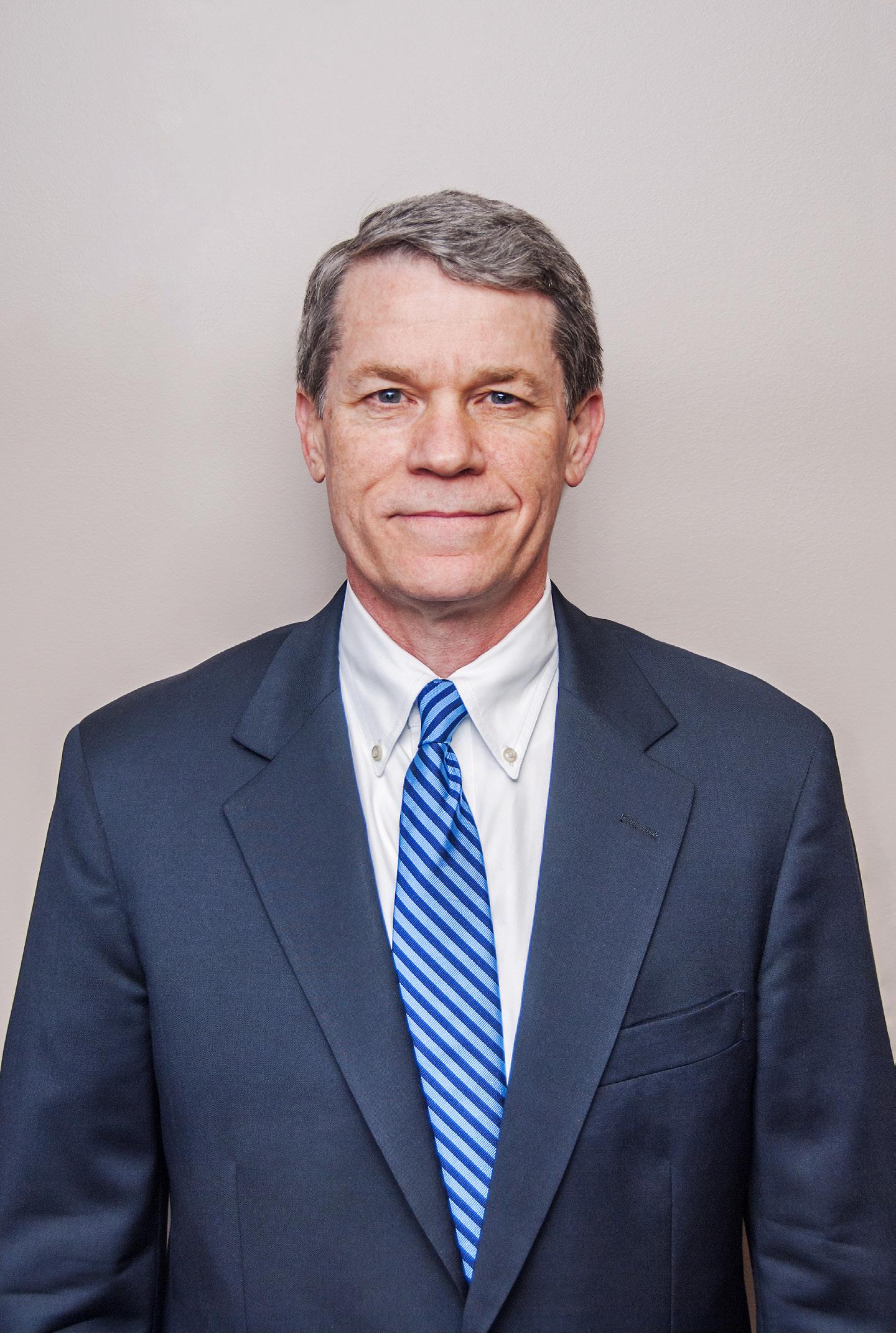
protected. As a result, Northside provided continuity of patient care, despite supply chain volatility.
While the strategy sets the direction, the organizational structure of the supply chain function should be flexible enough to anticipate and respond quickly to changes in the environment. One barrier to achieving an agile structure is unnecessary bureaucracy created by excessively complicated and/or outdated protocols, policies, and procedures. They had a valid purpose at one time but are no longer relevant. Therefore, it’s extremely important to challenge the status quo constantly.
Identifying and updating those obsolete or unaligned policies and procedures will increase organizational agility. As an example, Northside reengineered two critical processes to address this challenge. One dealing with disruption, and the other with operational efficiency. Both involved collaboration with key vendor partners.
Given the significant increase in manufacturing interruptions and bottlenecks at the ports, it became necessary to revisit our approach to managing back orders. Together with our acute care distribution partner, we launched several initiatives geared towards reducing the risk of stock outs. The thorough approach focused on the identification of root causes of declining order fill rates.
We determined that outdated procedures, communication gaps, and lack of process alignment increased back-order risk. To mitigate this, our focus shifted from managing back orders to identifying those products at risk well ahead of
projected stock-outs. Then, taking the necessary actions to minimize shortages. Working with our distributors and suppliers, the redesigned process yielded a 70 percent improvement towards our raw fill rate target.
document usage in surgical cases for vendor payment processing. The new system dramatically accelerated process cycle time, reduced resources required to support the process, and mitigated the risk of invoicing errors.
Decision-making should be delegated to the appropriate level of the organization to optimize agility. Too many levels within the organization may hinder decision-making and communication throughout the organization. At Northside, there are few levels of management within supply chain, and the VP reports directly to the CEO.
Timely decision-making is difficult when lacking the requisite information. In today’s supply chain environment, we are overloaded with data both from internal and external sources. Trying to extract insights from mountains of data (points) without a structured approach often results in analysis paralysis.
Another cumbersome and outdated process identified for improvement was the “bill only” process. Used for items only billed after a surgical procedure is performed based on consumption of product, this manual, paper-based approach historically included numerous touchpoints across various departments. In partnership with one of our primary software vendors, Northside implemented a cloud-based, AI application, streamlining and automating the “bill only” and “bill and replace” processes and procedures.
Both vendors and hospital staff use this to manage the bill only process and
Our approach begins with identifying the types of strategic and tactical decisions we make and the required information to support them. For instance, deciding which products will yield the largest return from our product portfolios, while improving patient outcomes remains critical to effective category and vendor management.
To make those decisions, we need to understand the drivers of supply expense in terms of volume, price, and product mix, while incorporating feedback from clinical value analysis to ensure we have the necessary information to optimize the product portfolio.
Perhaps the most important enabler of R2 is fostering an environment of trust.
“The ability to adapt to disruption, commonly referred to as resilience, is a critical element of an effective supply chain. How quickly we adjust determines the level of resilience.”
According to Stephen R. Covey, trust is defined as the “firm belief in the integrity, ability, or character—confidence and reliance . . . trust is the glue of life. It’s the most essential ingredient in effective communication. It’s the foundational principle that holds all relationships.”
Trust is all about having the confidence in team members to make the right decisions, but also to make honest mistakes and learn from them. It drives team engagement and synergies across the supply chain. The supply chain organization must be able to demonstrate visibly that it is acting in the best interest of key stakeholders and, ultimately, our patients.
Operating with a high level of trust often minimizes micromanagement, second guessing, procrastination, hidden agendas, and unnecessary conflict. Trust drives collaboration and team engagement.
Sustaining R2
Sustaining R2 is not dependent on a formalized plan or policy. Rather the critical elements of R2 are imbedded in the fabric of the organization, ensuring that bouncing back quickly is truly a fast-twitch response executed on cue to address disruption. It’s like being able to change a tire, while travelling at one hundred miles an hour. AHL

Northside Hospital is an integrated healthcare delivery system that serves the Atlanta region. It operates five acutecare hospitals with 1,705 licensed beds, and more than 250 outpatient locations across the state of Georgia.

Northside is one of the most respected and fastest-growing healthcare organizations in the Southeast and is committed to balancing clinical excellence with compassionate care. The health system leads the US in newborn deliveries and is among the state’s top providers of cancer care,







sports medicine, cardiovascular, and surgical services.







It has been recognized by Healthgrades, the leading online resource for information about physicians and hospitals, as one of the top US hospitals for outstanding performance in delivering a positive experience for patients during their hospital stay. Northside also has been ranked as one of the Best Places to Work among all top large employers in the United States by Comparably.com.

More than 25,500 employees and a network of 4,100 physicians serve nearly five million inpatient and outpatient visits a year across a variety of services, including cancer care, heart and vascular, orthopedics, maternity, pediatric and adult imaging, GI, surgery, spine care, urology, sleep disorders, and emergency medicine.
Owens & Minor is proud to partner with Northside Hospital as they deliver innovative, quality patient care in the Atlanta metropolitan area. This partnership has produced a modern approach to distribution that empowers Northside to continue prioritizing patient care during a period of rapid expansion, while improving inventory management and achieving considerable cost savings.
ICU Medical congratulates Carl Waller, VP Supply Chain Management at Northside Hospital, for being an outstanding strategic partner. We deeply value our collaboration with Carl and commend him for his ongoing dedication and commitment to addressing supply chain issues and developing strategies for patient and clinician safety.
We give healthcare organizations greater control over their product supply chain by providing direct sourcing solutions that increase the quality, lower the cost, and are designed to their custom specifications and brand. ASP Global offers high-quality med-surg supplies, custom products, and patient preference items to our health systems partners.


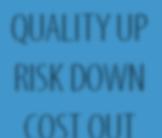





“In a highly competitive market, you have to know where you stack up. Benchmarking every five years or every other year won’t work anymore. Everything is changing so fast; companies should be benchmarking every year at the very least. Don’t downplay the importance of marketing and branding. How you are perceived and the trust you have with the market is key to attracting talent. HR teams should focus on driving quality, relevant programs to provide value to all employees.”
 Kirstin Boatto Marketing Director Corporate Relocation International
Kirstin Boatto Marketing Director Corporate Relocation International
“Pay attention to the feedback you request from employees. Don’t send a survey, and then take no action to address the concerns/ suggestions of employees. Having the understanding your team has a life outside of the office is an important key. Having the flexibility, with reasonable accommodation, to adjust the office life a little goes a long way.”
Monica Williams Executive Director of Benefits Baylor College ofMedicine (p.124)
“Regarding retention strategies, organizations should look to invest in career and professional development, develop strong managers/leaders to manage effectively, promote from within, build a strong culture, and ensure competitive pay and benefits. To attract quality talent, look to offer competitive pay and benefits, make diversity a priority in your recruitment process, and provide a strong Corporate Social Corporate Responsibility Program.”
Shannon Cruz Lloyd Associate VP of HR MIMEDX (p.36)“Start early. Connect with high schools, trade schools to get young adults interested in healthcare. Capitalize on their misunderstanding of the healthcare system and help them understand that healthcare is not just nurses— we have IT, HR, dieticians, physical therapists, security officers, billers, etc.”
David Villanueva Director of Employee Relations, Employee Health, and Diversity, Equity, & Inclusion Stormont Vail Health (p.164)“It’s important for company to offer a hybrid work schedule (office/home), otherwise employees will leave for employers that offer such.”
Ron Spielberger General Counsel Personal Touch Home Care (p.142)“I believe one of the better practices is to just ask your current employee base what works and what doesn’t in the new environment. Change is occurring and as leaders we need to embrace it. Include the employee base in creating the ‘new normal.’”
Gary Fennessy VP and Chief Supply Chain Executive Northwestern Medicine (p.88)“Create, own, and drive a company vision that is purposeful for all employees. COVID made everyone realize the value of family, health, and using our remaining time on earth in a purposeful way.”
Vidhu Bansal Dev VP of Rx to OTC Switch and Digital Transformation, R&D GlaxoSmithKline (p.160)“Job sharing. Flexible hours. Flexible work location. Perks like paid education. Equity incentives. Tie the job to philanthropic activities or align with a philanthropy.”
Tony Contessa Regional VP, NY/NJ Region–Select & Middle Market Segment Cigna (p.16)“Lean in: Getting to know people, talking with them, understanding what they are experiencing helped us understand the themes and what really was important to people (e.g., flexibility, tools for managing mental wellbeing, career development support, and community outreach). It was important we didn’t assume what was wanted/needed and what people were experiencing, but that we truly asked, and allowed people to have a voice and to show we could pivot to provide the flexibility, support, and outreach our employees were needing to experience.”
Dena House SVP of HR Organizational Development & Learning Adverum Biotechnologies (p.20)
“Offer a robust menu of voluntary benefits addressing work-life concerns. At EPIC, we introduced our ‘Benefits Booster’ bundle of voluntary (employee pay all) products, which includes caregiver support, back-up childcare, tutoring, and other support resources. It also includes Medicare transitional planning, pet and legal insurance, and data recovery protection.”
Craig Hasday President, National Employee Benefits Practice EPIC (p.62)
“I would suggest flexibility with staff, as a way to retain them; allow for remote or hybrid schedules. And for those who provide hands-on care, work with them if their schedule needs some modification from the typical nursing schedules that the industry has always had.”
Mark Weiss CFO The New Jewish Home(p.26)
In the face of complex problems and rapid change, business as usual is not enough. To succeed, leaders must breathe life into big ideas and bold commitments.
Over thirty-five years ago, Insigniam pioneered the field of organizational transformation and is a trusted partner to senior executives of the world’s best-run companies for whom speed to breakthrough, innovation and transformation are imperatives. With a dedication to service, we are with you at all points from:

• Building a bond and collaboration amongst your people
• Seeing what has not been seen before
• Designing novel approaches
• E ective and sustainable execution

think
